First-timer's guide to the Galápagos Islands

Mar 1, 2020 • 5 min read
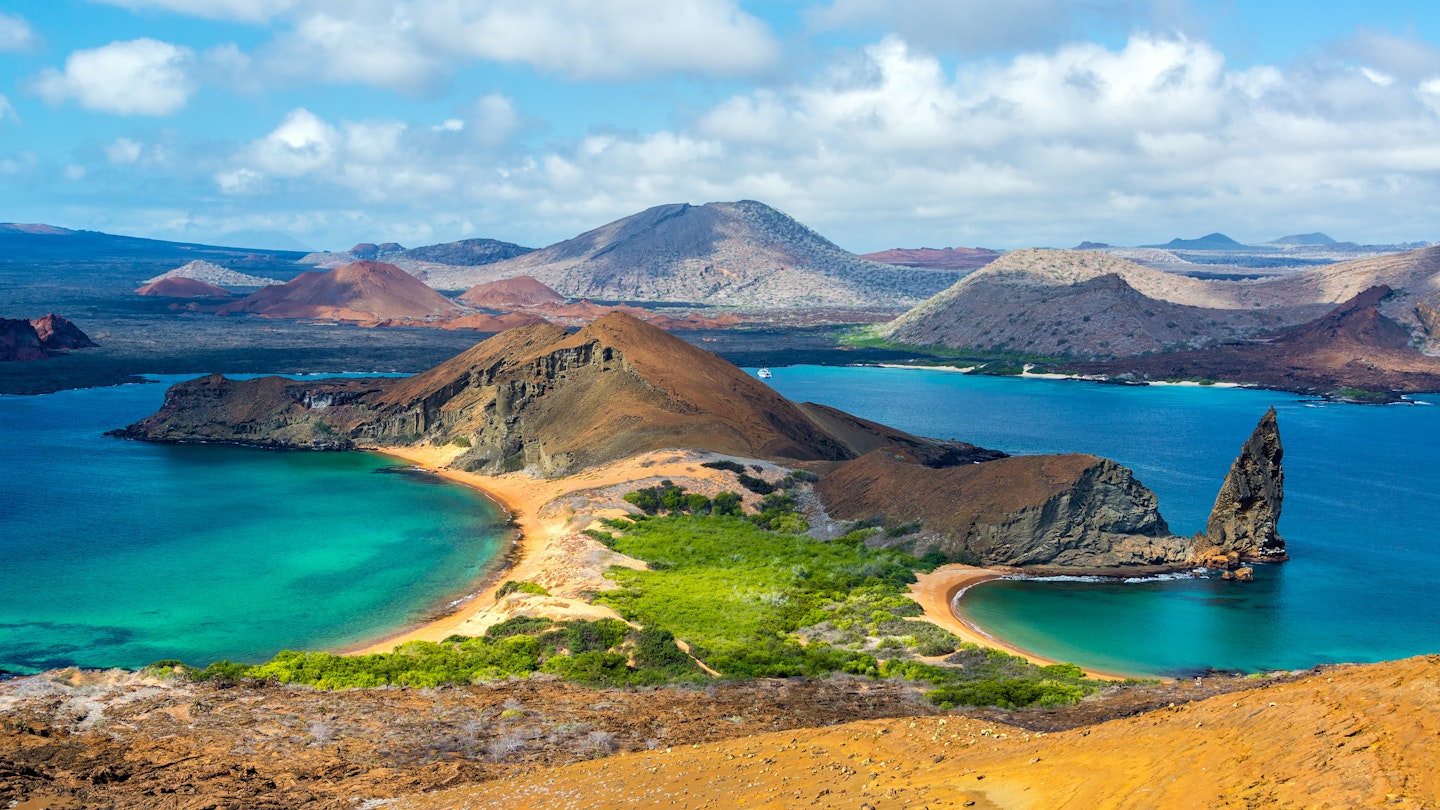
Planning is paramount before a booking a trip to the Galapagos Islands © Jesse Kraft / Getty Images
Wildlife is sure to wow visitors to the Galápagos Islands , but the archipelago has so much more to offer. Before a journey to this bucket-list destination, proper planning is paramount. Here’s what to know before you go.
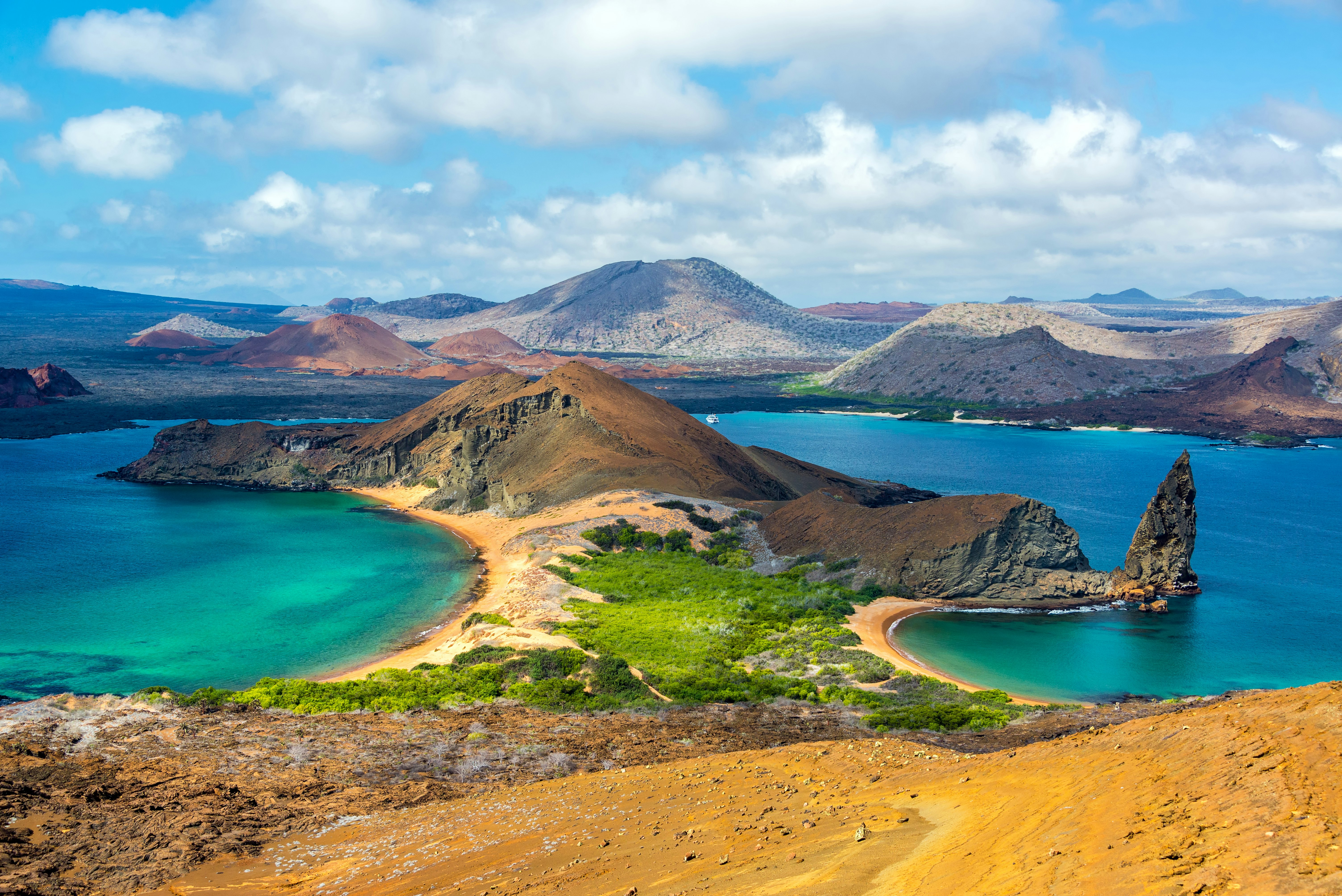
From the adrenaline rush of snorkeling nose-to-nose with white-tipped reef sharks to the wonder of watching up-close as blue-footed boobies perform mating dances on the sand, visitors can experience firsthand how locals coexist in harmony with the creatures of the Galápagos Islands – home to the rarest and most diverse species found in the world, and the inspiration behind Darwin’s Theory of Evolution.
There, time stands still, animals rule, and people delight in close encounters with wildlife, as there are no natural predators for the animals to fear. And beyond the one-of-a-kind wildlife viewings , there’s so much more to explore. In order to fully embrace a journey to the Galápagos Islands, it’s important to go properly prepared.


What to pack
From the jagged, jet-black lava fields of Santiago Island, to the powdery-soft beaches of Mosquera Islet, the landscape varies greatly throughout the Galápagos Islands, so proper footwear is fundamental. Sturdy, waterproof sandals will be required for wet landings, and lightweight runners or hiking boots will provide the proper support and protection from the rocky, uneven surfaces encountered during dry land hikes.
Weather waxes and wanes throughout the day, so prepare for both warm and wet environments. While the temperatures aren’t typically tropical, high-SPF sunscreens, protective sunglasses and neck-shading sun hats are essential, as the proximity to the equator means it can be easy to burn – even on cloudy days.
For long days on the water, manage motion sickness with a patch or over-the-counter pills and pack a small first-aid kit filled with essential medications that you may need while out at sea. Bug repellent isn’t mandatory, but it might help to prevent bites during longer inland explorations.
Shorts and t-shirts will suffice on most days, however, a light raincoat and sweater will provide comfort on wetter days and cooler mornings. Avoid slipping on soggy swimsuits by packing a few, as the night air can be humid and swimming and snorkeling are sure to occur several times throughout the day.
Most importantly, bring a fully-charged camera with back-up batteries to capture the stunning scenery and fantastic flora and fauna found throughout the islands – many of which are unique only to this part of the world.
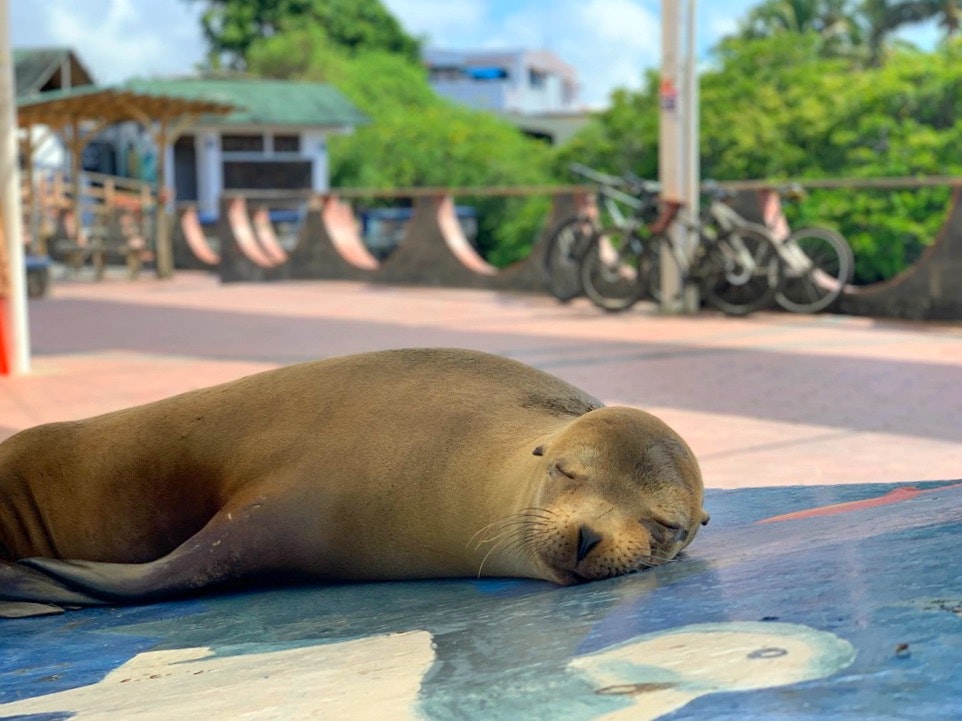
How to get to the Gal á pagos Islands
There are two stopover cities to choose from when traveling through Ecuador ’s mainland en route to the Galápagos Islands: Quito or Guayaquil . While both are stunning cities, Guayaquil is Ecuador’s largest city, has more frequent direct flights to the islands, and is closer in proximity.
Hotel del Parque – the first luxury boutique hotel to open in Guayaquil, is situated in the suburb of Samborondon, is a short 10-minute drive from the airport. Transportation can be arranged through the hotel. Situated on a tropical oasis, the restored 19th-century property offers authentic Ecuadorian cuisine and a peaceful setting to catch up on sleep before embarking on the remainder of the journey to the Galápagos.
There are two major airports on the Galápagos Islands: Seymour Airport (serving the island of Baltra), and San Cristobal (found on the island of Cristobal). The arrival and departure airport will depend on the location of the cruise departure or land accommodation site.
Before entering the area, a mandatory park fee must be paid by most visitors coming from overseas. In an effort to reduce over-tourism, each visiting adult traveler must pay USD$100. This rate is set to double by the end of 2020.
You might also like: Ultimate Ecuador: plan your perfect adventure
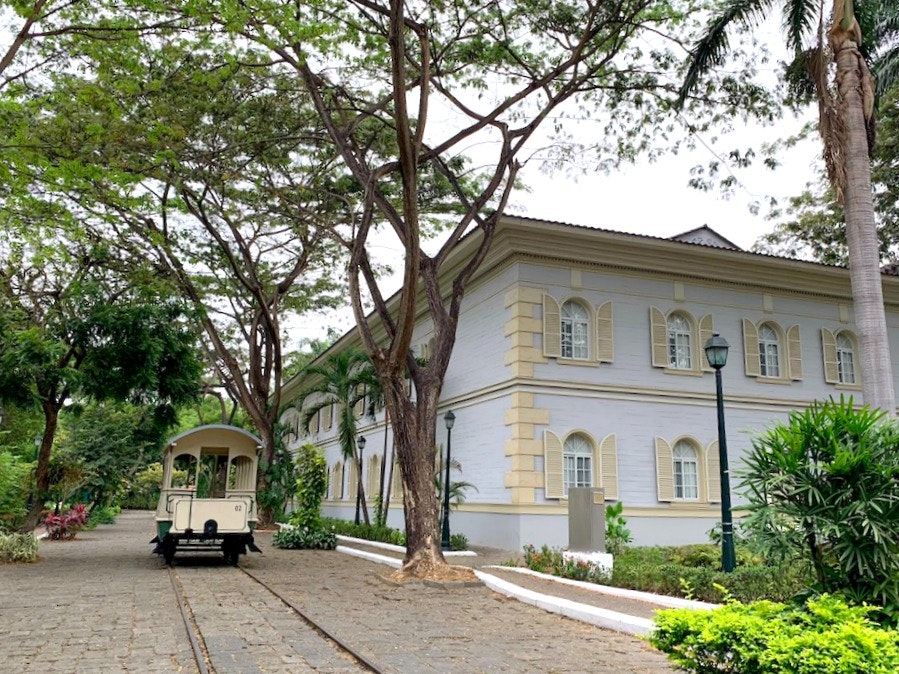
Where to stay
Water-loving wanderers often opt for a stay aboard a cruise ship or on one of the eco-friendly yachts, but there are land-based accommodations available as well.
While cruising tends to be the more common choice, a land-based stay offers a well-rounded option, providing visitors with opportunities to connect with the local people and culture, experience close encounters with the land-bound wildlife more frequently, and enjoy a restful sleep – ideal for those prone to seasickness, or guests looking for breaks to settle their sea legs.
For a more affordable land-based option, Puerto Ayora provides hostel-style accommodations, however day trips and excursions to attractions found throughout the islands will need to be booked separately.
Pikaia Lodge , a luxury eco-lodge found on Santa Cruz , sits in the heart of a private tortoise reserve, perched on the edge of an extinct volcanic crater, and overlooks acres of endemic Scalesia trees.
Darwin delights in every corner of the luxury lodge, which nods to the connection to the Theory of Evolution that emerged from Darwin’s visit to the Galápagos Islands, and the five-star cuisine, private 100ft luxury yacht, on-site spa and infinity pool provide the perfect setting for restful downtime in between days of adventure throughout the Galápagos Islands.
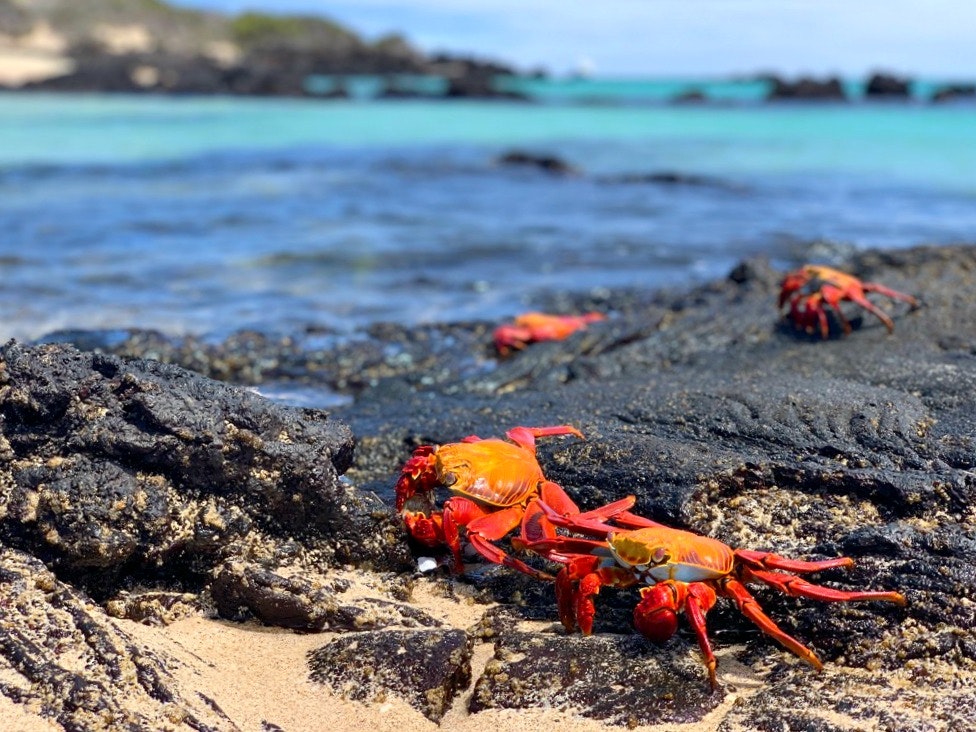
What to see and do
For island visits, the guidance of a certified tour guide is mandatory. This can be arranged through cruise excursions or as a part of a hotel package. Wildlife viewing is a must, but the islands also offer adventure spots beyond the ocean’s edge.
Observe giant Galápagos tortoises in the wild and learn about the history of the significant species at El Chato Tortoise Reserve , found on Santa Rosa. Afterward, explore the underground world of the islands by creeping through the on-site lava tube caves.
Head to Academy Bay and mingle with locals at the waterfront fish market and then stroll through the artisanal shops and purchase cacao treats, lava-laced jewelry and locally-grown coffee beans during a visit to town.
Then, hike along stunning stone pathways to Tortuga Bay and watch as black marine iguanas run along the white sandy beach. Head past the unswimmable Playa Brava and kayak with sea turtles and sharks at the hidden bay of Playa Mansa, found just beyond a mass of mangroves that line the shore.
Explore related stories
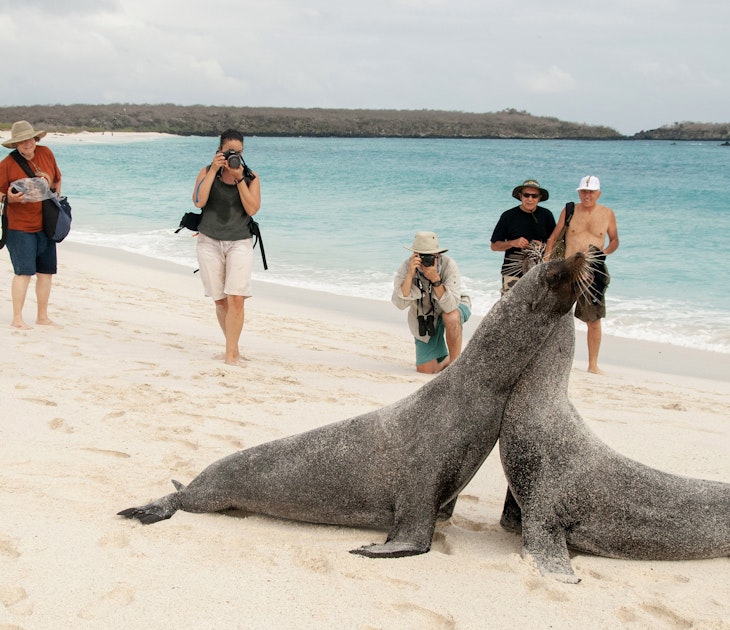
National Parks
Mar 25, 2024 • 2 min read
To combat overtourism and promote sustainability, authorities on the Galápagos Islands are raising fees this summer for most visitors from US$100 to $200.

Feb 1, 2024 • 7 min read

Jan 29, 2024 • 11 min read

Jan 5, 2024 • 20 min read

Nov 8, 2023 • 6 min read

Oct 30, 2023 • 8 min read
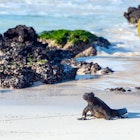
Oct 11, 2023 • 5 min read

Oct 7, 2023 • 6 min read

Sep 29, 2023 • 5 min read

Sep 27, 2023 • 10 min read
We’re on the road right now – join in on the fun and follow @thebrokebackpacker on IG!
- Meet the Team
- Work with Us
- Czech Republic
- Netherlands
- Switzerland
- Scandinavia
- Philippines
- South Korea
- New Zealand
- South Africa
- Budget Travel
- Work & Travel
- The Broke Backpacker Manifesto
Travel Resources
- How to Travel on $10/day
Home » South America » Ecuador » Galapagos
Backpacking Galapagos Travel Guide
“ A man who dares to waste an hour of time has not discovered the value of life ”- Charles Darwin.
Follow in Darwin’s footsteps and embark on an adventure unlike any other to a place with untouched islands and undisturbed eco-systems… I’ve always wanted to explore the Galapagos Islands; there is something truly incredible about this rarely visited place and, in the future, I very much hope to head on out there.
This week, I chatted to Galapagos veteran Lisa Swenson and she filled me in on everything I needed to know to explore Galapagos on a backpacker budget…
I had always wanted to explore the Galapagos, with its confusing and utterly fascinating creatures – a land where a Godzilla like creature is a harmless vegetarian and tortoises grow to the size of a fully grown man; what’s not to be curious about? My husband and I decided to not get bogged down by the daunting tour prices and instead try and do Galapagos on a budget. And a pretty tight one at that. Here is a great travel guide to backpacking Galapagos on a budget…
Exploring Galapagos on a budget
Getting to the galapagos islands, where to go while backpacking galapagos on a budget, top 10 animals to see in galapagos, how much does it cost to backpack galapagos on a budget, food in galapagos, backpacker accommodation in the galapagos, staying in touch while backpacking galapagos on a budget, volunteer in galapagos, galapagos tours, what to pack for galapagos, top tips for broke backpackers in the galapagos islands, books to read, apps to download while backpacking galapagos, backpacking galapagos for free, scuba dive the galapagos on a liveaboard trip, how to stay safe in galapagos.
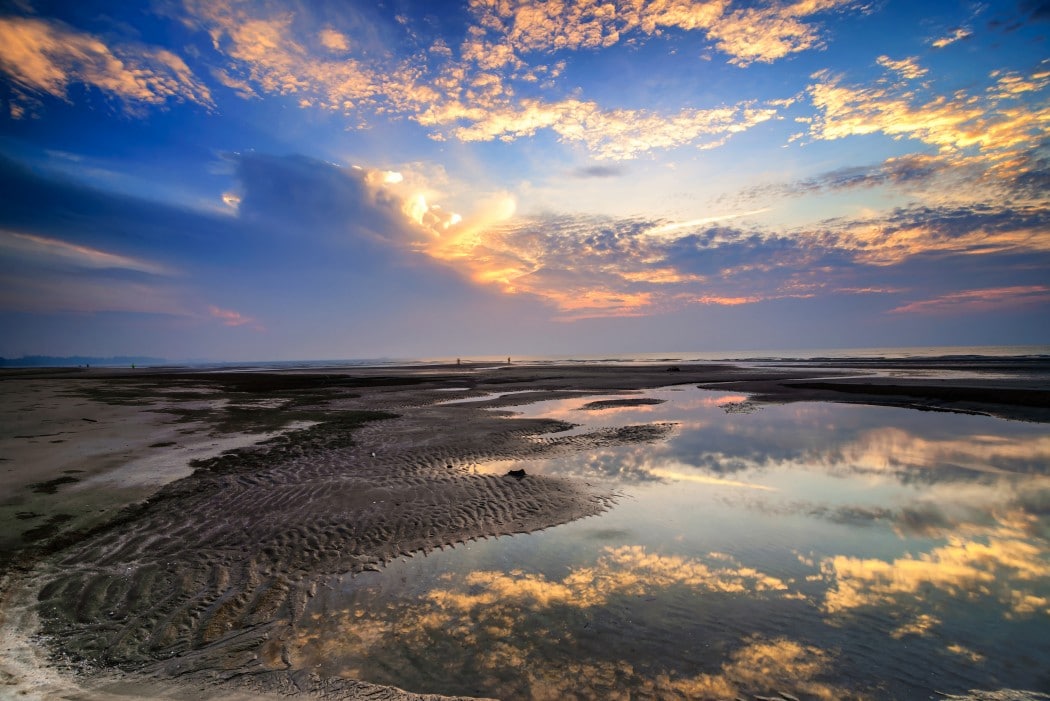
We flew into Quito and bought our Park Pass for Galapagos, an essential, at the airport which cost us about $100 per person. Once we reached Baltra we had to taxi across the dry desert island to get to a water taxi that would then take us to Santa Cruz. Our ‘real’ journey to Galapagos had begun, and it did not seem like an easy one.
The bus was cramped and people were squished together like canned sardines. The air was humid and stuffy and there wasn’t any air-conditioning – this certainly wasn’t any luxury tour but we didn’t care; we were heading somewhere amazing and would be seeing Galapagos on a budget. We were so thankful when we saw the ferry. But of course, we were once again jammed in with as many people as they could fit on the $2 water taxi. Finally, we could begin the last leg of our first journey and head on over to Santa Cruz.

Backpacking Santa Cruz
Santa Cruz was a destination in itself. We could have spent an entire week here seeing all that it had to offer – sandy beaches, colourful villas and ever smiling locals. Once we got to Puerto Ayora we realised it had everything we needed – restaurants, cheap places to stay, shops and even a couple of bars. The small island town was always busy with the locals walking or riding their bikes from home to work.
The town was directly on the blue sapphire water with access to piers, beaches, and water taxis and this made it to the perfect place to arrange Galapagos day trip . The day trips ranged from $45 – $95 dollars for an all-day snorkelling and land excursion to Isla Daphne including lunch. There are a lot tourist excursion kiosks so make sure you shop around and bring your haggling A-game to get the best price.

Backpacking Isla Daphne
The boat ride out to the island was beautiful; the water was calm and crystal blue. Birds soared through the salty blue sky squawking overhead as we skirted over the water. The island jetted out of the waterm full of life. We spotted a ton of birds: frigates, boobies, and some stunning tropic birds…

While snorkelling we saw sea lions, a few eagle rays, sea turtles, and a white tipped shark. Although the cost of this excursion isn’t crazy cheap, it is well worth doing and is one of the better value trips whilst exploring Galapagos on a budget.
Spotting Tortoises
After the trip we ventured out on our own to the El Chato Tortoise Reserve to see some unique species of birds. We then cabbed to Rancho Primicias where the Galapagos tortoises grazed about throughout the free range property. We walked along the lush green trails weaving in and around ponds and trees and constantly spotting many giant tortoises. They were massive- much larger than the ones at the Darwin Center and El Chato.
Backpacking through the Lava Tunnel
The Lava Tunnels were very similar to many caves I had previously explored in the US but with one major difference; the tunnels are surrounded by hardened lava rock. We paid the taxi driver extra so we could see these tunnels and crawl through the narrow openings. The tunnels had a string of dim lights that helped us see our way.

The driver picked us up on the other side of the tunnels where a bucket of water awaited us to wash ourselves off after clambering through the admittedly mucky tunnel. We then went to see Los Gemelos – two huge sinkholes that look like gorges. We went on a short walk and guess what we saw…
Giant iguanas and flamboyant flamingos in the lagoons near the Darwin Station. Our first tryst with these super fascinating beings. What an incredible experience! It was at this point that we really felt that our budget Galapagos adventure was off to an amazing start… We were seeing the highlights of the islands, on the cheap, without the need for an expensive tour.

It was almost sunset by now. We were absolutely exhausted but so overwhelmed and happy at what we had seen today. Not bad for the first day of a budget trip yeah?
Backpacking Isabela
The following day we returned to the same kiosk we had gotten the day trip deal from. The salesman gave us a map of Isabela, marked out locations for us and told us that we could see much of the island on our own. We went ahead and bought the ferry ticket, loaded our backpacks in and left on a 2 hour journey to Isabela. Our search for accommodation took way longer than we anticipated. We found a nice private room with a private bath for $50 – expensive I know! You can find hostels in the area for as cheap as $8.
Backpacking Los Tunneles
We embarked on a day trip to the beautiful Los Tunneles, early next morning. There were lava bridges over the sapphire blue waters and tunnels under the water. In the shallow snorkelling area, the snorkelling guide pointed out a sea horse for us all to come over and see! This was my first sea horse sighting and I was so happy to see one in the wild. We saw shoals of parrot fish darting in and around prettily through the lava formations. I even spotted a squid, spotted eagle ray, sting rays, and a couple of sharks. This area is so fascinating to explore. The snorkelling experience was truly one of a kind because of the beautiful formations.
Backpacking Punta Tortuga
After returning to the island we had a few hours to kill before taking the long water taxi back to Santa Cruz so we explore the small mangrove cove close to the pier called, Punta Tortuga. We saw some colourful fish and a couple of rays but we weren’t very impressed so we ventured to the beach area on the other side of the docks. Best decision ever! We left our backpacks on the shore with the sunning sea lions standing guard, and dove right in. We swam off shore with the friendly sea lions and a ton of little penguins.
I was constantly tapping, poking, and grabbing my husband to show him the little torpedo of penguins diving through the mangroves chasing the shimmering fish. While swimming I felt what I thought was my husband grabbing my toes to point out some more sea life and turned around to look, I saw two wee little penguins nibbling at my toes! Such an endearing experience.

Backpacking the Other Islands
Galapagos has many other islands to see that offer more wildlife viewing on the land as well as in the ocean surrounding them. Many of the Islands are only accessible by long cruises. Wolf Island is one of those due to its distance from Santa Cruz. Many islands also only allow scuba divers so make sure you do a bit of research before venturing out & bring your hammock with you if you want to camp!
Galapagos is famous for its splendid wildlife. Most adventurers come here to get their fill of spotting beautiful creatures that aren’t found anywhere else. The most famous animal of all would be the giant land tortoise. The islands where they can be spotted are Santa Cruz, Isabella, and San Cristobal. Another famous reptile is the Galapagos Land Iguana which can be found on Isabella, Santa Cruz, Fernandina, Baltra, and North Seymour. Another rare beauty is the Marine Iguana, which can be spotted on all the islands as they travel through the ocean all over Galapagos.
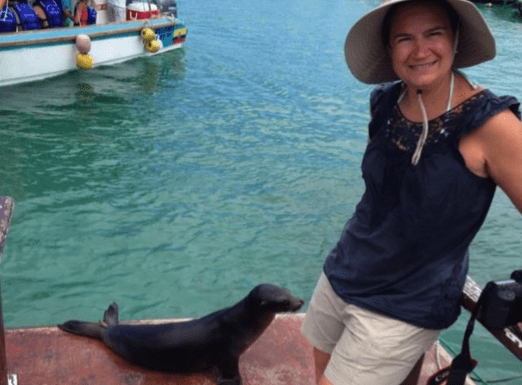
In the ocean waters you might happen across a Manta Ray or as the locals called them the Diablo Ray or Devil Ray. We spotted two doing somersaults as we cruised on the deep blue sea. Some mantas were doing flips while eating so we caught sight of their white bellies. These rays are found in deep channels and in the Canal Bolivar. Hammerhead sharks and white tip sharks can also be spotted all over Galapagos. The famous and ultra vibrant Sally Lightfoot Crab is also easy to spot. We saw many of these rock hopping along the shoreline.
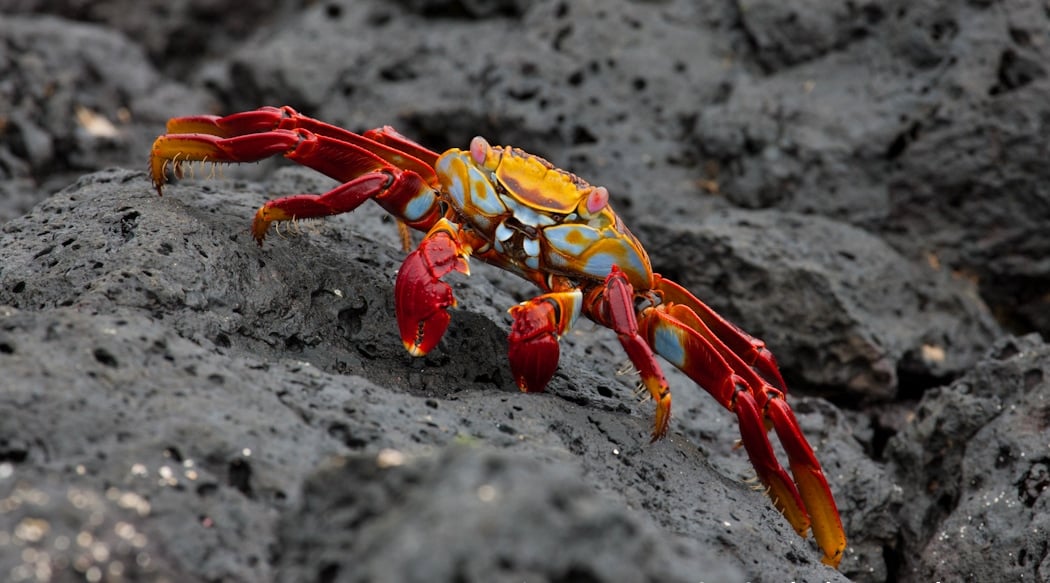
Galapagos is the most famous for the Darwin’s Finch, which can be spotted on Santa Cruz and Espanola. The Galapagos is also home to the Galapagos Flamingo which is one of the largest flamingos. They can be found in shallow lagoons in Isabella and Floreana. The Blue-footed booby is a popular favourite and is found all over the Islands, you can’t miss their bright blue feet! My favourite of bird by far were the inquisitive wee little penguins that swam all around the islands and dove in and out of the mangroves. A land so rich in wildlife, you will end up spotting most of these animals while backpacking Galapagos on a budget.
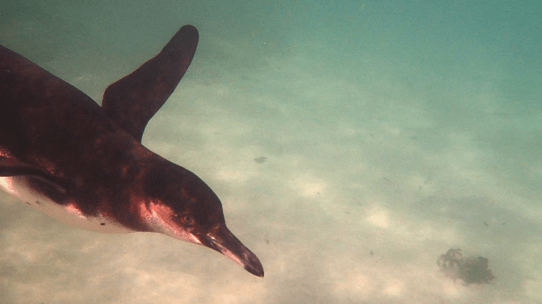
The main cost of going to Galapagos is the air fare. First you have to get to Quito (flights from the states are around $500 for a roundtrip) and then you have to make your way to Baltra, a $200 return flight from Quito. Of course, if you’re already in South America, you can travel overland from Colombia or Peru and enter Ecuador that way. Once you’ve made it to Baltra, you must pay a park entrance fee of $100 per adult and $50 per child. The rest of the trip was pretty budget friendly.
The food in general was amazing and there was always plenty of yummy beer to go with it. Meals ranged from $3 a person to $15 a person. If you eat where the locals eat you can get a good wholesome dinner for just $5 a meal. If you plan to eat where the tourists do, you’ll end up spending around $10-$15. Our most expensive dinner was $15 for the two of us to share a pizza and drink cokes at a tourist restaurant. So, yeah a word of advice; eat local if you aim to backpack Galapagos on a budget.
You can find plenty of hostels with private rooms and shared rooms. They charge per person for rooms – starting from $8 for shared, going to about $15 a night for a private room.
Couchsurfing is another viable option in the Galapagos. CS is a great platform for backpackers who want to crash on a couch for free. I would advise you to do a thorough check on the host though.
There are plenty of budget hostels in The Galapagos , but if you are still wondering which is the best part of the Galapagos to stay in? Well, let me give you a few suggestions.
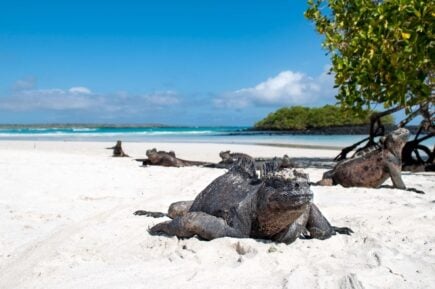
In terms of tourism, Santa Cruz is the most popular island in the entire archipelago! The main airport is actually on a separate island – Baltra – however, Santa Cruz is the closest inhabited island, and is only a short ferry ride away.
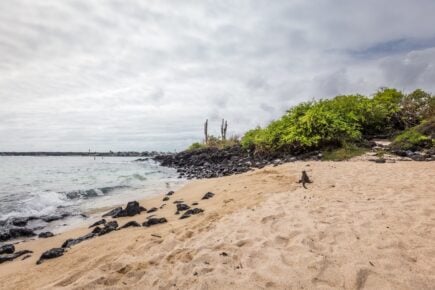
San Cristóbal
San Cristóbal is the most populous island in the Galapagos, and is home to the administrative capital – Puerto Baquerizo Moreno.
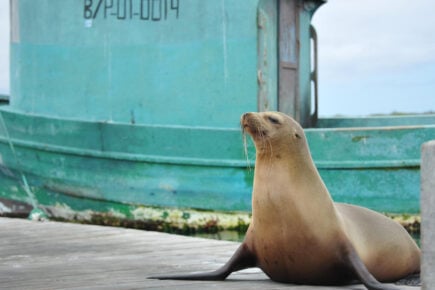
Isabela Island
The largest island in the archipelago, Isabela is nevertheless quite small population-wise – making it a great pick if you want an easy going and relaxed beach holiday!
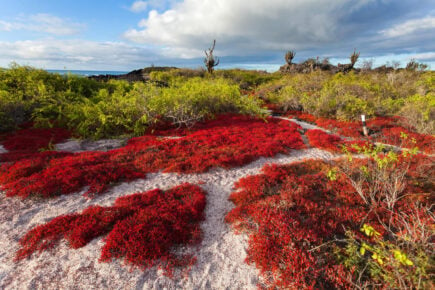
Floreana is easily the most unique of all the islands in terms of culture! By far the least populated, and smallest in size of the inhabited islands.
We did not have any service while we were in the Galapagos and we were fine with it. But if you absolutely must have reception, grab a local SIM card for about $5 and activate 3G on it. You can also use free WiFi that most hostels offer. Also, make sure you have a good Virtual Private Network for your cell; which basically prevents others from stealing your info while you’re using public Internet.
Volunteering abroad is an amazing way to experience a culture whilst giving something back. There are loads of different volunteer projects in Galapagos ranging from teaching, to animal care, to agriculture to pretty much everything!
Despite high levels of tourism, poverty is common throughout the Galapagos and there are plenty of opportunities for backpackers to volunteer. Most gigs you’ll find are helping with permaculture, and sustainability projects, helping the landscape recover from the damaging effects of mass tourism. It’s also possible to find opportunities in English teaching and housekeeping. If you plan to volunteer in Galapagos for more than three months, then you’ll need to apply for a volunteer visa.
Worldpackers
Our go-to platform for finding volunteering gigs is Worldpackers who connect travellers with host projects. Have a look at the Worldpackers site and see if they have any exciting opportunities in Galapagos before signing up.
Volunteer programs run through reputable work exchange programs like Worldpackers and platforms like Workaway are usually very well-managed and reputable. However, whenever you are volunteering do stay vigilant, especially when working with animals or children.

Worldpackers: connecting travellers with meaningful travel experiences.
Alternatively, Workaway is another excellent common platform used by travellers searching for volunteering opportunities. Workaway is pretty massive, with over 40,000 hosts registered (that’s 40,000 opportunities) and over 350,000 reviews on the site. With a database base that big, odds are you’ll be able to find something that strikes your fancy. You can read our review of Workaway for more info on using this terrific platform.
Volunteer programs run through reputable work exchange programs like Worldpackers and platforms like Workaway are usually very well-managed. However, whenever you are volunteering do stay vigilant, especially when working with animals or children.
Global Work and Travel
Last, but certainly not least, Global Work and Travel is another viable option for finding volunteer opportunities in Galapagos. What sets Global Work and Travel apart from other volunteering platforms is the amount of assistance they give, from a 24/7 global help-line, help with VISA processing to airport transfers and continued support once you are in Galapagos. It may be a smaller platform, but the projects you’ll find are high quality and immaculately organised. There are new programs and opportunities listed constantly as Global Work and Travel continues to grow its reach.
For those interested in volunteer work in Galapagos, Global Work and Travel offer a fantastic project one where you’ll get to choose between community conservation or assistant teaching . There are options to stay anywhere from 2 to 10 weeks with weekends off. As with all volunteer abroad programs, there’s a cost, but you’ll be able to pay it off in interest-free instalments. Don’t forget to bring your camera and make sure you are between the ages of 18-85 to qualify!

If you’re en route to Galapagos and you want to check out what’s available in terms of a last-minute Galapagos cruise, you should check out Galapatours. This is an online portal of all the cruise operators in Galapagos, and it’s updated daily. This means you can check out any last minute offers before you arrive and grab a place on a boat with a great island itinerary that will get you to the islands and wildlife you most want to see.
Feeling crushed by the extravagant pricing of cruises – from $6500 all the way to $14,000 for a ten day cruise, I was pleasantly surprised by how inexpensive they could be if you just rocked up and looked around a bit.
A great tip for those wanting to backpack Galapagos on a budget – go for a last minute trip. Once you get to the island you can find specials and deals being offered everywhere for last minute trips.
Day trips range from $40-$95 depending on where you want to go. Tour costs very much depend on what you want to do and see. For a week of adventuring, I would estimate spending between $400-$800 dollars on cruises to see all of the islands.
That’s a total steal compared to the prices quoted online… If you want to see the Galapagos on a budget; just go and figure it out once you have arrived.
All of that said, sometimes it makes sense to book a tour in advance, especially if you are picky and limited on time, looking for an eco-tour, etc. You’ll find our guide to the best Galapagos tours hire .
On every adventure, there are six things I never go traveling without:

Travel Security Belt
This is a regular looking belt with a concealed pocket on the inside – you can hide up to twenty notes inside and wear it through airport scanners without it setting them off.

Microfiber Towel
Hostel towels are scummy and take forever to dry. Microfibre towels dry quickly, are compact, lightweight, and can be used as a blanket or yoga mat if need be.

Petzl Actik Core Headlamp
A decent head torch could save your life. If you want to explore caves, unlit temples, or simply find your way to the bathroom during a blackout, a headtorch is a must.

‘Monopoly Deal’
Forget about Poker! Monopoly Deal is the single best travel card game that we have ever played. Works with 2-5 players and guarantees happy days.

Hanging Laundry Bag
Trust us, this is an absolute game changer. Super compact, a hanging mesh laundry bag stops your dirty clothes from stinking, you don’t know how much you need one of these… so just get it, thank us later.
For plenty more inspiration on what to pack, check out my full backpacking packing list.
To keep your spending to an absolute minimum whilst traveling in South America in general I recommend sticking to these basic rules of budget adventuring….
- Camp: With plenty of gorgeous natural places to camp, the Galapagos is an excellent place to take a tent, though camping is highly restricted. There are still a few opportunities, however. Check out this post for a breakdown of the best tents to take backpacking.
- Cook your own food: I took a small gas cooker with me to the Galapagos and cooked a few of my own meals as I could and saved some cash – check out this post for info on the best backpacking stoves.
- Haggle: Haggle as much as you can. You can always get a better price for things especially while in local markets, though you might find that the locals won’t budge much on certain things.
- Pack a travel water bottle : save money (and the planet) every day! Stop buying bottled water! I may be repeating myself, but having your own water bottle is that important!
Why You Should Travel to Galapagos Islands with a Water Bottle
Plastic washes up on even the most pristine beaches… so do your part and keep the Big Blue beautiful
You aren’t going to save the world overnight, but you might as well be part of the solution and not the problem. When you travel to some of the world’s most remote places, you come to realise the full extent of the plastic problem. And I hope you become more inspired to continue being a responsible traveller .
Plus, now you won’t be buying overpriced bottles of water from the supermarkets either! Travel with a filtered water bottle instead and never waste a cent nor a turtle’s life again.

Drink water from ANYWHERE. The Grayl Geopress is the worlds leading filtered water bottle protecting you from all manner of waterborne nasties.
Single-use plastic bottles are a MASSIVE threat to marine life. Be a part of the solution and travel with a filter water bottle. Save money and the environment!
We’ve tested the Geopress rigorously from the icy heights of Pakistan to the tropical jungles of Bali, and can confirm: it’s the best water bottle you’ll ever buy!
- Lonely Planet Ecuador & the Galapagos Islands – This book is your passport to the most relevant, up-to-date advice on what to see and skip, and what hidden discoveries await you. Spot an iguana, swim with penguins, get out there and discover the heart of Galapagos islands.
- Galapagos: Islands Born of Fire – This book offers an unforgettable photographic tour of the Galapagos. Explore with the author the incredible diversity of wildlife and habitats of the most fascinating and exotically beautiful places in the world.
- Huasipungo: The Villagers: a Novel – “The Villagers” is a story of the ruthless exploitation and extermination of an Indian village of Ecuador by its greedy landlord. An interesting read.
- The Queen of Water – Virginia’s story will speak to anyone who has ever struggled to find his or her place in the world. It will make you laugh and cry, and ultimately, it will fill you with hope.
- Galapagos Regained – The book centres on the fictional Chloe Bathurst, an unemployed Victorian actress who finds work on Charles Darwin’s estate, nurturing the strange birds, exotic lizards, and giant tortoises he brought back from his trip around the world. An interesting take on the theory of evolution.
- Galápagos – A story of the character Kilgore Trout who watches and broods over his no-longer-human descendants who have made natural selection a matter of debased survivalism.
- Beyond the Islands – A hilarious and troubling take that recreates the Galápagos Islands as the famous cradle of evolutionary theory and as an earthly paradise.
Galapagos Islands Offline Map Travel Guide
You will end up exploring the islands mostly on foot or by boat. Because of the lack of connectivity you will need something that will go off-grid with you. The Galapagos Islands Offline Map Travel Guide app is your best bet. It is detailed and will help you save all the info offline. Perfect if you’re backpacking Galapagos on a budget and want to save money on transport.
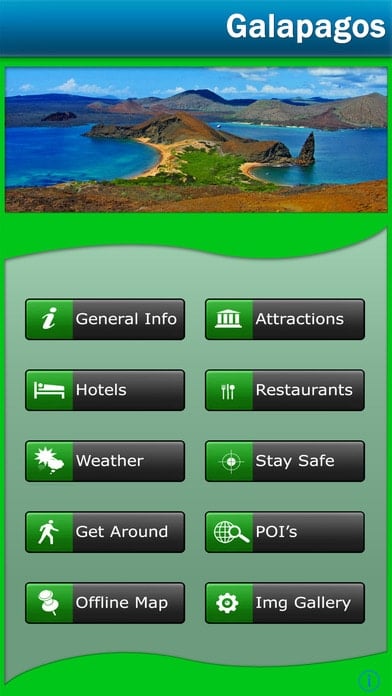
Are you a native English speaker looking to earn cash whilst traveling the world? Teaching English online is a great way to earn a consistent income—from anywhere in the world with a good internet connection. Depending on your qualifications (or your motivation to obtain qualifications like a TEFL certificate) you can teach English remotely from your laptop, save some cash for your next adventure, and make a positive impact on the world by improving another person’s language skills! It’s a win-win! Check out this detailed article for everything you need to know to start teaching English online .
In addition to giving you the qualifications to teach English online, TEFL courses open up a huge range of opportunities and you can find teaching work all over the world. To find out more about TEFL courses and how you can teach English around the world, read my in-depth report on teaching English abroad .
Broke Backpacker readers get a 50% discount on TEFL courses with MyTEFL (simply enter the code PACK50), to find out more, please read my in-depth report on teaching English abroad.
Whether you are keen to teach English online or looking to take your teaching game a step further by finding a job teaching English in a foreign country, getting your TEFL certificate is absolutely a step in the right direction.
The waters surrounding the Galapagos Islands make up some of the best scuba diving opportunities to be had in all of South America. The marine life is so abundant due to the heavy ecological protections placed upon the island by the Ecuadorian government years ago.
Joining a Liveaboard trip in the Galapagos is a great way to experience both the islands and the underwater marvels of the sea surrounding them.
Going to the Galapagos is an expensive affair generally. Plus it can be difficult to move around the islands.
Liveaboard trips go to remote dive sites and parts of the islands otherwise inaccessible to foreigners (and other divers). Eat, sleep, and go diving, all from the comforts of an awesome boat…
Sounds pretty awesome right?
For more information, check out Liveaboard scuba diving trips in the Galapagos here.
Check out our Ecuadorian safety guide for tips and advice for visiting. Otherwise, you can read our Backpacker Safety 101 for some more general information on staying saf while backpacking.
Pick yourself up a backpacker security belt to keep your cash safe on the road.
Check out this post for plenty of ideas on ingenious ways to hide your money when travelling.
I strongly recommend travelling with a headlamp whilst in Galapagos (or anywhere really – every backpacker should have a good headtorch!) – check out my post for a breakdown of the best value headlamps to take backpacking.
Travel Insurance for Galapagos
Traveling without insurance would be risky so do consider getting good backpacker insurance sorted before you head off on an adventure.
I have been using World Nomads for some time now and made a few claims over the years. They’re easy to use, professional and relatively affordable. They may also let you buy or extend a policy once you’ve started your trip and are already abroad which is super handy.
If there’s one insurance company I trust, it’s World Nomads.
ALWAYS sort out your backpacker insurance before your trip. There’s plenty to choose from in that department, but a good place to start is Safety Wing .
They offer month-to-month payments, no lock-in contracts, and require absolutely no itineraries: that’s the exact kind of insurance long-term travellers and digital nomads need.

SafetyWing is cheap, easy, and admin-free: just sign up lickety-split so you can get back to it!
Click the button below to learn more about SafetyWing’s setup or read our insider review for the full tasty scoop.
Being a Responsible Backpacker in the Galapagos Islands
Reduce your plastic footprint: Perhaps the best thing you can do for our planet is to make sure you do NOT add to the plastic problem all over the world. Don’t buy one-use water bottles, the plastic ends up in landfill or in the ocean. Instead, pack a tough travel water bottle .
Go and watch A Plastic Ocean on Netflix – it’ll change how you view the plastic problem in the world; you need to understand what we are up against. If you think it doesn’t matter, get off my fucking site.
Don’t pick up single use plastic bags, you’re a backpacker – take your daypack if you need to go to the shop or run errands.
Bear in mind, that many animal products in countries you travel through will not be ethically farmed and won’t be of the highest quality. I’m a carnivore but when I’m on the road, I only eat chicken. Mass-farming of cows etc leads to the rainforest being cut down – which is obviously a huge problem.
Need more guidance? – Check out our post on how to be a responsible backpacker.
Backpacking South America and the Galapagos Islands can be one hell of a party at times. Take it from me, it can be easy to get carried away. It is important to keep in mind that you are an ambassador for your country, which is awesome. We can make a positive impact on people when we travel and get rid of any ugly stereotypes that may be associated with your country.
If you visit indigenous villages or small communities always ask before taking photos. The people who live in these villages are not exhibits in a museum. They are normal folks just living their lives. Always show them the complete respect that they deserve.
When buying a local craft, do not haggle so low that the price is unfair to the person who spent countless hours crafting it. Pay people what they are worth and contribute to the local economies as much as possible.
Avoid eating at fancy gringo-owned restaurants. I don’t care how badly you want that lasagne and red wine. You make a choice with every dollar you spend. Try to spend your money in places where the experience is mutually rewarding.
I know it can be hard, but do your best to use the least amount of plastic water bottles that you can. Refill the ones that you do buy! Use a Grayl Geopress . Refill at your hostel! There are plenty of ways to reduce plastic!!!
Backpacking South America or any region for that matter often illuminates some of the great socio-economic inequalities of the world. Never take it for granted that you are healthy and financially able to go traveling. Show the world around you some gratitude and help to make a positive impact on it. Most of all have the time of your life and spread the love!
Hope this budget travel guide has inspired you to stop freaking out about expensive tours and get out there and explore Galapagos on a budget!

And for transparency’s sake, please know that some of the links in our content are affiliate links . That means that if you book your accommodation, buy your gear, or sort your insurance through our link, we earn a small commission (at no extra cost to you). That said, we only link to the gear we trust and never recommend services we don’t believe are up to scratch. Again, thank you!
About the Author: Lisa Swenson
Lisa Swenson is a third grade teacher at a local Arts Integration and Dual Emersion School in Georgia. Lisa enjoys adventuring outdoors with her family; Nathan, Stephanie, and Rebekah. She enjoys traveling to new places and exploring outdoors by hiking, kayaking, biking, camping, and photoghoraphing.
Website Instagram

Guest Poster
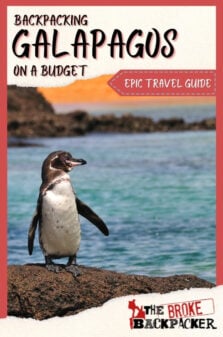
Share or save this post

- Destinations
Wild Junket

How to Visit Galapagos Islands: Travel Guide 2024
Last Updated on March 15, 2024
The Galapagos Islands are some of the best wildlife destinations in the world. Here’s a detailed guide on how to visit Galapagos Islands.
The Galapagos Islands are one of the most beautiful and unique places I’ve ever been. Having been isolated from the world for thousands of years, they are home to unique animal species found nowhere else on Earth. Blue-footed boobies, sea lions, and marine lizards roam freely on this archipelago.
A Galapagos Islands trip might come with a hefty price tag, thanks to the $100 entry tariff and pricey island cruises. But don’t let that stop you. It’s one of the best wildlife destinations in the world for good reason. We have been twice and it remains our favorite place on Earth! For those are planning to visit Galapagos Islands, here’s my Galapagos Islands travel blog and comprehensive guide.

Table of Contents
How to Visit Galapagos Islands
What make the galapagos islands special, a brief history of the galapagos islands, when to visit galapagos islands, how to visit the galapagos islands, the 2 airports on the galapagos islands are:, 1. go on a galapagos cruise, 2. do day tours on the galapagos islands, 3. take the inter-island shuttles, puerto ayora, santa cruz, puerto baquerizo moreno, san cristobal, puerto villamil, isabela, what to eat on the galapagos islands, 1. santa cruz island, 2. san cristobal island, 3. isabela island, 4. north seymour island, 5. bartolome island, 6. floreana island, 7. española island, 8. genovesa island, 9. fernandina island, 10. santiago island, how much time to visit galapagos islands, how to stay connected on the galapagos islands, cost of travel on the galapagos islands, rules of the galapagos islands national park, packing list for galapagos islands, final tips for galapagos islands travel, travel resources, galapagos islands travel guide.
The Galapagos Island archipelago is a collection of 13 major islands, seven smaller islands and about 125 islets and rocks. They lie about 600 miles (1,000 kilometers) off the coast of Ecuador in the Pacific Ocean and are some of the world’s most secluded islands .
Historically the Galapagos Islands were uninhabited and only served as bases for everything from scientific research to English pirates raiding Spanish treasure ships. They remained relatively undeveloped until Ecuador claimed them not long after gaining independence from Spain.

The plants and animals that live on the Galapagos Islands today are descended from animals that arrived by sea or air. Because the islands are so remote and far from one another, the animals evolved and adapted to conditions unique to their new homes. That’s why wildlife here are so special and cannot be found elsewhere on Earth.
Because of a lack of predators, most Galapagos animals never developed a fear of humans. Don’t be surprised to find sea lions lying by the streets and giant lizards swimming around your boat in the Galapagos. They are not the least bit afraid of us. The Galapagos is such a great destination for kids as they can get up close to wildlife and learn all about the planet here. Read my guide to traveling the Galapagos with kids.
Today, over 97 % of the land is national park , and Ecuador limits who may live there and how many tourists may visit. The Galapagos Islands are some of the most unspoiled places on Earth thanks to protection laws and conservations efforts.
During Charles Darwin’s nearly five-year circumnavigation of the globe aboard HMS Beagle, he spent only five weeks on the Galapagos Islands. His discoveries on the islands were paramount to the development of his Theory of Evolution. His book “The Origin of the Species: also put the Galapagos Islands on the world map.
Santa Cruz Island is now home to the Charles Darwin Research Station, which serves as the front line for long-term preservation programs protecting the unique Galapagos animals and plants for future generations.

One of the perks of the islands’ location along the equator is that the weather is going to warm and sunny all year round. Regardless of when you visit the Galapagos Islands, prepare for high temperatures.
There are two main seasons in the Galapagos: January to May is the hot season, giving calmer seas and warmer ocean temperatures. July to December is the dry season which sees cooler temperatures, making it great for hiking inland.
In general, the best time to visit the Galapagos Islands is from January to May for the best conditions to go snorkeling or scuba diving and cruising around the islands. The Galapagos Islands offer some of the best scuba diving in the world .

It’s easy to add the Galapagos into any Ecuador itinerary . You just need to plan (and save!) in advance to make the most of your time in the Galapagos.
Most foreign tourists over the age of 12 pay $100 , while children pay $50. Visitors from the Andean Community and Mercosur nations over the age of 12 pay $50, and children pay $25.
This entry tax may seem a bit high, but it is important to keep in mind that these fees are helping to protect the fragile environment here. Funds from the entry tax are said to finance the conservation of biodiversity of flora and fauna, and benefit the local community.

How to Get to the Galapagos Islands
The only way to get to the Galapagos Islands is to fly from Ecuador. Flights to the Galapagos Islands depart from only two cities in Ecuador: Quito and Guayaquil. Guayaquil is the main gateway city to the Galapagos, check out this list of things to do in Guayaquil .
You can fly direct to Quito from Miami, and return flights cost around US$400. Check for flights from USA to Ecuador . From Europe, most flights go from Amsterdam or Madrid to Quito for around US$700 return.
Flights from Quito/Guayaquil to Galapagos Islands cost around US$300 to $400 return. All flights are with either LATAM or Avianca , which are both reliable South American airlines. Foreigners are only allowed to book flights on premium class (and sadly they are very strict about it).
- Baltra Airport (GPS): Baltra is the airport closest to Santa Cruz Island. To get to Santa Cruz island, take a ferry for $5 and another $5 bus to Puerto Ayora, the main town on Santa Cruz. Or book a fuss-free airport transfer here .
- San Cristobal Airport (SCY): This airport is less than 5 minutes drive from the center of Puerto Baquerizo Moreno. It costs only $2-$4 per taxi (not per person). Most flights to San Cristobal will make a stopover on Baltra.
*TIP: I recommend flying into Baltra and out of San Cristobal like we did on our recent trip. It’s the same price as flying return to either island.
Book Your Flights to Galapagos Islands
Getting Around the Galapagos Islands
Traveling to the Galapagos Islands requires some planning (and saving!) as it isn’t the cheapest or easiest place to get around. It’s easy enough to do it yourself so you don’t have to book a Galapagos tour. There are three possible ways to explore the Galapagos Islands and hop from one island to the next:
The most popular way is going on a luxury Galapagos cruise, which brings you to several islands within a short time. You sail at night and arrive to a different island every morning. Cruise packages typically include all accommodation and meals, visits to the islands with a certified naturalist, and access to snorkeling gear and kayaks.
A 1-week Galapagos cruise can set you back around US$2,500 for budget standards or $3500 for luxury cruises. This includes all expenses, food and snorkeling equipment. You can save some money by showing up on the Galapagos Islands and shopping around for last-minute deals.
Those traveling the Galapagos Islands with kids might find that cruises aren’t particularly suitable for kids due to the intense schedule and limited space. Also, it can get choppy on the waters of the Pacific Ocean; many people get seasick while cruising the Galapagos. My friend was seasick the entire time he was on a Galapagos cruise. If your kids aren’t comfortable at sea yet, I wouldn’t recommend going on a cruise.

Budget travelers can opt to go island-hopping round Galapagos Islands independently, which was what we did on our first Galapagos Islands trip. We based ourselves on Santa Cruz and did day tours to other islands from there. There are plenty of local operators offering Galapagos tours online or at certain locations on the islands. Most Galapagos Islands day tours cost around $200-300 depending on where you’re visiting.
There are four islands that you can stay on without being on any tour:
- Santa Cruz: This island has the biggest tourist town and has most sights
- San Cristobal: It has a quieter town with iconic attractions
- Isla Isabela: Smallest town with few options but great for wildlife
- Isla Floreana: Only 1 hotel and no scheduled speedboats to other islands
Here are the most popular Galapagos Islands tours:
- Kicker Rock day tour from San Cristobal island (pictured)
- North Seymour day trip from Santa Cruz island
- Bartolome day trip from Santa Cruz island
- Floreana day tour from Santa Cruz island
- Snorkeling in lava tunnels on Isabela island

Besides day tours, there are also several speedboat companies that offer an inter-island shuttling service. You need to plan really well as there are limited departures each day and journeys can be long! For instance, the shuttle from Santa Cruz to Isabela takes around three hours.
The public ferries cost between $25-35US per person each way . It’s best to check with a couple of ticket sellers in town before buying your tickets. Or book these ferry transfers that include hotel pickups!
Public ferries only run these routes (back and forth):
- Santa Cruz (Puerto Ayora) – Isabela (Puerto Villamil)
- Santa Cruz (Puerto Ayora) – San Cristobal (Puerto Baquerizo Moreno)

Where to Stay on the Galapagos Islands
I’ve listed my hotel recommendations for the three most popular towns to stay at. If you’re wondering where to stay on the Galapagos Islands, these are the biggest towns.
Puerto Ayora , the main town on Santa Cruz island, is a lively town with a good range of midrange hotels and affordable guesthouses. Puerto Baquerizo Moreno , the town on San Cristobal island, is smaller but its accommodation options are more affordable. Puerto Villamil on Isabela island is the smallest but accommodations are cheapest.
Luxury: Finch Bay Galapagos Hotel — Undoubtedly the best hotel on Santa Cruz, this stylish hotel is slick and unpretentious. It’s got a beautiful swimming pool and beachfront location, with even its own pier and private yacht. Excellent place if money isn’t an issue! Check the rates.
Midrange: Hotel La Isla — A beautiful boutique hotel with stylish designs that blend naturally with the surroundings, and its small scale provides an intimate atmosphere. It’s within walking distance from Tortuga Bay and the town centre of Puerto Ayora. Check the rates.
Midrange: El Descanso del Guia — This new midrange hotel offers panoramic views over the coast from its rooftop. It also has a nice swimming pool, and clean and spacious rooms. Check the rates.
Budget: Hostal Gardner Galapagos — We stayed at this place located in the heart of town and minutes from the pier. Rooms are cheap and spacious, and relatively well maintained. Great value! Check the rates.

Midrange: Eco Hotel Katarma — The best hotel on the island is an eclectic and colorful eco lodge with an indoor swimming pool. Katarma is inspired entirely by art; it mixes different architectural, design, painting and sculptural influences to create a space where peace and life take the upmost importance. Check the rates.
Midrange: La Zayapa — Located right on the dock, La Zayapa is the heart of the town, offering room with views of the pier. We absolutely loved staying here. Good prices for such excellent location. Check the rates.
Budget: Hotel Cactus & Cactus — With a minimalistic design, this artistic hostel features clean lines and very simple but beautiful decor. Rooms are well-priced for what it is, highly recommend it! Check the rates.

Luxury: Flip Flop House — With capacity for four people, this beautiful, modern house has 2 bedrooms and 3 bathrooms and a hot tub. The property was built in 2016, and makes a comfortable home away from home. I highly recommend this if you are traveling with family or friends. Check the rates.
Midrange: Drake Inn — Located right on the beach, this simple but comfortable guesthouse offers well-priced rooms just three minutes from town. Its rooftop has excellent ocean views and makes a great spot to chill in the evenings. Check the rates.
Budget: Hotel La Jungla — This budget place offers great value for money, and a rustic jungle setting despite being just a few feet from the sea. All of its rooms have wide windows that look out to the ocean. Check the rates.

Food, especially seafood, is a huge part of island culture here and the restaurants to not disappoint. There are full spreads fit for kings as well as authentic, local eateries that boast fresh and cheap grub.
Here are four places I highly recommend checking out:
Los Kioskos — Puerto Ayora, Santa Cruz
This row of street food was our favorite spot to eat at night! Los Kioskos is basically a street lined with small, local stalls selling freshly caught seafood. You’ll hear sizzling from the charcoal parillas and smell smoky, grilled fish long before you stumble across this little alley. Food here is reasonably priced and oh so bueno!
Galapagos Deli — Puerto Ayora, Santa Cruz This deli is famous for its brick-oven pizza ranging in price from $6.50 to $9.75 USD and high-quality deli sandwiches from $4.70 to $8.75. Of course, it wouldn’t be a seaport deli without fish and chips, as well as piping hot espresso and delicious frozen gelato. Read reviews here.
Booby Trap — Puerto Villamil, Isabela Island Booby Trap is the best place to grab a slice of pizza, but it’s their fish tacos that I loved. The lobster also comes highly recommended at a very reasonable rate. The restaurant is owned by a greagarious retired American man and his Ecuadorian wife. Read reviews here.
Muyu Galapagos — Puerto Baquerizo Moreno, San Cristobal
If you’re looking to splurge, definitely book a table at Muyu Galapagos, one of the best restaurants in the whole archipelago. They serve up modern fusion food, focusing on fresh seafood with a contemporary twist. Read reviews here.

Things to Do on the Galapagos Islands
With over 21 islands spread out over a large area, the Galapagos Islands really do have a lot to offer for active travelers who like to get out and about. Here’s a round-up of the BEST things to do on the Galapagos Islands and the best Galapagos tours to book. I will indicate below how to visit each site below.
See Lizards and Sea Lions at Tortuga Bay
A 45 minute hike leads you to Santa Cruz’s most beautiful beach and bay. There are plenty of marine iguanas and sea lions lounging on the beach when we were there. It’s also a great spot for snorkeling with white tip reef sharks, and occasionally tiger sharks. It was the first spot we visited and we were blown away!
How to : Visit independently by walking or taking a taxi from Puerto Ayora.

Snorkel in Las Grietas
Las Grietas is a beautiful naturally formed freshwater pool formed in a crack between two volcanic cliff faces. During midday when the sun is high, the pool is a bright, clear blue. There isn’t a lot of wildlife here, but the crystal clear waters make it just a fun swimming spot. Plus it’s free to visit the site! No guide or tour needed. We absolutely loved it here and could have spent a day here if not for our fomo!

Visit the Charles Darwin Research Center
The Charles Darwin Research Center is a breeding centre and rehabilitation facility for animals from local islands. First stop by the Ruta de las Tortugas for a guided tour ($10) — they run tours in both English and Spanish every hour. The guide brings you on a short walk and talks about the endemic wildlife and plant life on the Galapagos, before showing you the tortoise breeding area (which is fenced up). At the end of the tour, you’ll be led into a room where the famous Lonesome George (the last tortoise of its kind who passed away in 2012) stands immortalized.
After the tour, walk to the end of the centre to visit the museum and learn more about the wildlife of the Galapagos. There’s also a station beach where you can swim and see black-tip reef sharks. All in all, the research center is a great spot to visit for those traveling the Galapagos with kids .
See Giant Tortoises at Reserva El Chato
Just a short drive from Puerto Ayora, Reserva El Chato is the best place in the Galapagos to see the rare Galapagos Giant Tortoises. You’ll see their ancient animals roaming around in their natural habitat, with no cages, fences, or walls to obstruct the view – and all for just $3. Book your entrance tickets here.

Swim with Sea Lions at La Loberia
San Cristobal is the best island to go for sea lions. Here at La Loberia, not only can you snorkel with tons of sea lions, but you will also see marine iguanas, lava lizards, frigate birds, and more. We had SO much fun swimming with the sea lions! Those animals can be really cheeky. It’s free to enter, just rent snorkeling equipment beforehand.
How to : Visit independently by walking 30 minutes or taking a taxi ($3 ride) from Puerto Baquerizo.

Snorkel or Scuba Dive at Kicker Rock
Around 3 miles north of San Cristobal island is this volcanic cone that rises from the sea. Kicker Rock, known locally as León Dormmido, is home to a smattering of blue-footed boobies and fregate birds, but it is really its below-water inhabitants that has visitors in awe.
The natural erosion of the cone has created a channel between the rocks that serves as the ideal place to view sharks and rays. If you come at the right time, you can see hundreds of Galapagos sharks (and come into touching distance of them if you choose to snorkel through the canyon). You might have the chance to see schools of spotted eagle rays, turtles, jellyfish, and sea lions.
How to : Only by cruise or on a day tour to Kicker Rock from Puerto Baquerizo.

Hike around Punta Pitt
Punta Pitt is one of the best places to see a huge variety of wildlife on the Galapagos. Both the blue-footed and red-footed boobies, and various species of frigates live in the area. They have chosen this site because its rugged geography prevents species that would be a threat to these birds from accessing here. Another species commonly found here are the iguanas, also due to its complex geography.
How to: Visit independently or a day tour from Puerto Baquerizo .

See the Views at Mirador Cerro Tijeretas
The Cerro Tijeretas lookout point offers a panoramic view of Shipwreck Bay and Kicker Rock. It’s definitely a spectacular spot and well worth the two-mile hike there from the visitor center. You’ll be hiking through a dry forest area full of cacti, acacia trees and lava lizards. The trail also leads to a calm, protected inlet along the shore which is a great spot for snorkeling.
How to: Visit independently by taking a taxi to the visitor center and walking from Puerto Baquerizo.

Hike and Snorkel around Los Tuneles
Los Tuneles or lava tunnels is a hugely popular site to visit. We hired a guide and came here on a day tour. A boat first takes you along the coast to a landscape characterized by bizarre lava formations and tunnels that provide shelter for an abundance of sea life. You’ll then need to hike for a bit before getting the chance to snorkel with sea lions, turtles, sharks, rays, sea horses among innumerable fish species.
How to: The only way to get here is on a cruise or day tour from Puerto Villamil .

Snorkel at Las Tintoreras
Las Tintoreras is an islet just off the main dock of Isabela Island. It’s often called mini Galapagos since almost a ll the Galapagos marine wildlife are found here. There is actually more wildlife here than on the main island.
It’s one of the few places to see the Galapagos penguins, the second smallest penguins in the world. It was incredibly getting to swim with them and see them in the water! You can snorkel in the area without a guide.
How to: Take a half-day tour from Puerto Villamill.

See Flamingos at the Wall of Tears
The Wall of Tears, or El Muro de Las Lagrimas, is one of the most famous hikes on the Galapagos Islands . It’s the only place to see the Galapagos Flamingos and you can do it without a guide. The name comes from the wall at the end of the hike. The Wall of Tears was built in the 1950’s by 300 prisoners, toiling away under the hot sun to cut and haul heavy black volcanic rock in order to build their own prison.
How to: Visit independently by walking from Puerto Villamil.

Our favorite spot, North Seymour, is a small uninhabited island that is hugely popular with all kinds of birds that live in the Galapagos. It’s a fascinating place with open nesting grounds of blue-footed boobies and the archipelago’s largest colonies of fregate birds. If you’re lucky, you might even see blue-footed boobies perform their courtship dance in the more open areas.
How to: The only way to get there is on a cruise or a day tour from Santa Cruz island .

Bartolome Island is the most scenic island in terms of landscapes. Be sure to climb up to the top of the viewpoint for a 360 degree panorama. There are black volcanic formations, which contrast sharply with the red, orange and green of the rest of the island. Also don’t miss the Pinnacle Rock, home to a colony of Galapagos penguins.
How to: The only way to visit is on a cruise or a day tour from Santa Cruz island .

Another island I really enjoyed visiting was Floreana, where Charles Darwin visited and collected the Floreana Mockingbird. On the island, you can find beaches of different color and a fresh water lagoon where flamingos can be observed during the hot season.
Devil’s Crown is an old eroded, semi- submerged, volcanic cone where you can spot penguins, sea lions, sea turtles, dolphins and colorful fish. It’s one of the best snorkeling sites in the Galapagos Islands because of the coral reef in the middle which is a perfect attraction for marine life.
How to: Visit on a cruise, public ferry (no fix schedule) or day tour from Santa Cruz island .

One of the oldest islands of them all, Española Island is about 4.5 million years old and located on the southern east corner of the archipelago. This island is home of the Española Mockingbird, the only carnivorous one. Here there is also the only Marine Iguana population that remains red and green throughout the year. About 1500 tortoises live there today.
This is the only nesting site for the Galapagos Waved Albatross, thanks to the cold waters from the Humboldt current. This endemic animal nests on the flat grounds of this island. They breed from the month of April to December.
How to: You can only visit by cruise or on a day tour from San Cristobal island .

Also known as the “Bird Island“, Genovesa Island most certainly lives up to its name in a spectacular way. It’s common to spot these birdlife on the island: puffball chicks, crowned and lava herons, red footed boobies, Nazca boobies and also the swallow–tailed gulls, the only nocturnal gulls in the world that will be nesting at the cliff’s edge.
Be sure to visit Prince Philip’s Steps, an 81-foot stairway that leads to a narrow stretch of land which opens out onto the plateau surrounding Darwin Bay on the north side of the island.
How to: The only way to visit this island is on a Galapagos cruise.

Fernandina Island is often referred to as a “land without time” as it is a volcanic island without any introduced species. The island is 300 thousand years old and it is still active.
There are an estimate of around 100,000 black and gray iguanas on Fernandina Island. As you look out the lava rocks they may look like they are moving – they are covered in these reptiles basking in the sunshine. Their dark coloration is an adaptation that allows them to hold onto heat so that they can stay under the water and search for food.

Despite being the fourth largest island, Santiago Island is an uninhabited island that can only be visited on a cruise. The black lava pools at Puerto Egas are home of a great variety of fauna, including marine iguana basking in the sun, hundreds of red crabs , herons , fur seals that will swim with you.
From there it’s a 2km walk to Sugarloag Volcano where you can get a spectacular view of lava lizards, Galapagos doves, and Darwin finches.

On our first trip there as backpackers, we spent 5 days in the Galapagos Islands and based ourselves on Santa Cruz the entire time. This time round, we had 1 week and stayed on Santa Cruz and San Cristobal, but we still wished we had more time. Ideally, I would recommend spending 10 days in the Galapagos Islands so you can enough time to base yourselves on the three main inhabited islands.
You’ll probably want to combine another week or so on mainland Ecuador to make the most of your trip. On this recent trip, we spent two weeks in Ecuador , combining time in the historic center of Quito with hikes in Otavalo and Cotopaxi National Park.
Our 1-week Galapagos itinerary:
- Day 1: Fly to Santa Cruz
- Day 2: See Tortuga Bay + Visit Charles Darwin Center
- Day 3: Do a day trip to Bartolome Island
- Day 4: Take the ferry to San Cristobal
- Day 5: Explore the Loberia, Puerto Chino, and the Giant Tortoise Reserve
- Day 6: Do a 360 day trip around the island + Kicker Rock
- Day 7: Fly to Quito from San Cristobal
Recommended 10-day Galapagos itinerary:
- Days 1-3: Santa Cruz Island
- Days 4-6: Isabela
- Days 7-10: San Cristobal

Internet connection is limited and slow on the Galapagos Islands. Even in our hotel and Airbnb, the download speeds were very slow. Get prepared to disconnect abit while you’re here.
I recommend getting an eSIM card with data plan as that works faster than the WiFI in hotels. I personally use eSIMs wherever I travel these days as they are SO much more convenient – you can buy them online, and don’t need to go to the shop or activate your eSIM through the store. Most phones are compatible with eSIMs, including all of the new iPhones, Samsung, Google and Huawei phones. For a comprehensive list of phones compatible with eSIMs you can check out this article .
Airalo is the world’s first eSIM store and it has eSIMs from over 190 countries and regions around the worlds. I have bought eSIMs from Thailand, Vietnam, Singapore, Ecuador and Peru from Airalo and never had any issues.
Check out Airalo’s eSIMs here.
Let’s face it: the Galapagos is quite an expensive destination mainly due to the tourist tariff and the flight to get there. First you’ll be spending around US$500 for your flight and entry tariff . Day tours are around US$200-300 each, and a week-long cruise can set you back at $2500 .
Galapagos Islands travel is not cheap as the archipelago is so remote, almost everything needs to be imported. Accommodation on the islands are more expensive than on mainland Ecuador but you can still find decent guesthouses at $40/night for a double room and luxury hotels for $200/night.
Food is quite affordable especially at the local eateries. Expect to spend around US$8-10 on a local meal, and $20-30 in a hotel restaurant. There are also supermarkets in towns and you can cook on your own to save money.
All in all, you’ll have to budget for the kind of adventure you want. Just remember, the Galapagos Islands are a truly unique place in the world and they are definitely worth saving up for!

80% of the Galapagos Islands is actually protected as a national park and there are rules in place to protect the fragile ecosystem in the park.
- Some protected areas can only be visited with a licensed guide, so make sure you research before venturing out on your own.
- When you encounter wildlife, remember to stay back and not get too close as you might cause them stress. Don’t feed them or use flash photography.
- If you are traveling to the Galapagos Islands with kids , make sure they stay close to you and remind them not to go near or touch the animals as they’ll be interfering with the natural environment.
- Any professional photography or filming recorded for commercial purposes must be authorized by the GNPD.
- Camping is only allowed in a few authorized spots. To get permission, you need to request authorization from the Galapagos National Park’s offices at least 48 hours in advance.
- The Galapagos Islands take the practice of “leave-no-trace” very seriously. Since fire poses a serious risk to the flora and fauna, smoking of any kind, as well as campfires, are strictly prohibited.
- When shopping for souvenirs, do not take or buy any products made from banned substances like black coral, lava rock, native woods, and animal parts.

What to Pack for the Galapagos Islands
Any Galapagos Islands travel involve lots of time in the water and under the sun. Be sure to prepare yourself for the weather and pack sunscreen, sun-proof swimming gear and snorkeling gear . We didn’t bring our own snorkeling gear as we were traveling South America for a few months, but I highly recommend bringing your own to avoid having to rent one everywhere you go.
One item that I strongly recommend bringing is waterproof footwear. My favorite shoes from KEEN footwear have never failed me. They’re perfect for both land and water activities (like walking on corals or waterfalls). Also don’t forget a sun-proof swim shirt that can protect your skin even while snorkeling (bikini/shorts are not enough!).
- SPF 70 Sunscreen
- Mosquito repellent with DEET
- Snorkel mask and fins
- UPF50+ rash guard swim shirt
- Dry bag for snorkeling/kayaking
- Quick-dry towels
- Sun hat that covers the neck
- KEEN covered sandals
- SteriPen to sterilize water
- Dramamine for motion sickness
- GoPro Hero 7 for waterproof photos/videos!
- Quick-dry t-shirts for the hot weather

- Bring cash in US dollars, which is the main currency on the Galapagos Islands.
- There are limited ATMs on Santa Cruz and San Cristobal, and none on Isabela island. Most places won’t accept credit cards, or will charge a high fee to do so. So having some spare cash is definitely useful.
- Learn some Spanish! Knowing some basics like ‘gracias’ (thank you), ‘por favor’ (please), and ‘como estas?’ (How are you?) will go a long way.
- The water conditions between islands can be rough, remember to bring motion sickness medication ! Even if you don’t usually get seasick, it’s best to be prepared for the rough conditions. I didn’t get seasick at all, but my friend who went on a cruise got seasick many times during the whole voyage.
- Print your flight itineraries and bring them just in case, because sometimes smaller international airports want to see a printed copy before they let you inside.

Inspired? Pin it!

Over the years (and traveling to 140+ countries), I’ve learned a thing or two about travel planning. I’ve put together this list of travel resources that I personally use to find the best deals and book travel! For more details, check out my travel tips resource page .
- Booking Flights : Kayak is brilliant for finding the best dates to fly as it allows you to search for the lowest airfares within a 3-day period. Then I use Skyscanner as they’ve consistently given me the lowest airfares.
- Accommodations: I always use Booking.com to book hotels, mainly because of the flexible cancellation policy and good customer service. You can also find short-term rental apartments there (I prefer not to use Airbnb due to the extra charges).
- Travel Insurance: It’s important to have travel insurance, regardless of whether you’re traveling for a few days or months. Safety Wing is the most popular travel insurance company for COVID19-coverage. I use their Nomad Insurance plan , which covers any healthcare expenses I may have worldwide. Refer to my travel insurance guide for more details.
- Health Advice: I always refer to the travel guides on the CDC website for recommended medications and vaccines. You can get them at your travel doctor’s office or a walk-in pharmacy.
- Tours: If you’re looking for all-encompassing tours, I recommend small-group adventure tour outfitter, G Adventures . I’ve traveled with them to Antarctica, Mongolia, Svalbard, and Nepal, and loved every single trip. For day tours, I always book with Viator and GetYourGuide ; they have easy booking systems and free cancellations.
- Car Rental: I always book car rentals on Discover Cars , as they’ve consistently given us the best rates and customer service (with free cancellations). We’ve used them in Seychelles, South Africa, Spain, Peru, and Mexico.
- Transportation : Whenever possible, I book local transportation online using Bookaway and Busbud . They’re more reliable than many local transport websites and cover trains, buses, and car hire.
- Restaurants: TripAdvisor is my go-to resource for restaurant reviews and bookings. I also make restaurant reservations on OpenTable .
- Travel WiFi: I recommend getting an Ecuador eSIM before arriving here. Airalo is the world’s first eSIM store and it has eSIMs from over 190 countries and regions around the worlds. Check out Airalo’s eSIMs .
Nellie Huang
Nellie Huang is the founder of WildJunket. Originally from Singapore, Nellie has traveled to over 140 countries across 7 continents. As an adventure travel blogger, she has a special interest in unusual destinations and deep experiences. Her work has appeared in many major publications including BBC Travel, CNN and LonelyPlanet.com. Read more about her here and get more life updates from her on her Facebook and Instagram .
Leave a Comment Cancel Comment
Save my name, email, and website in this browser for the next time I comment.
This site uses Akismet to reduce spam. Learn how your comment data is processed .
The Comments
Awesome post! Thank you!
Great info…thank you! Would love more luxury cruise recommendations.
very informative and very helpful
Thanks Richard!
After being in Guayaquil for a week, I have only 2 days for the Galapagos Islands. Do you have a recommendation for a 48 hour tour?
I will be there in mid-November 2023.
Fitness Travel
Amazing post and awesome pictures.
You May Also Like
Two weeks in argentina itinerary & guide, how to walk the camino de santiago, video: paragliding off lion’s head in cape town.
- Search Please fill out this field.
- Manage Your Subscription
- Give a Gift Subscription
- Sweepstakes
- Destinations
- Central & South America
The Ultimate Galápagos Islands Travel Guide
Discover the islands that inspired Charles Darwin.
:max_bytes(150000):strip_icc():format(webp)/Stacey-Leasca-2000-631fabdcfe624115bea0ce8e25fdec96.jpg)
The Galápagos Islands, located roughly 600 miles off the coast of Ecuador, remained a closely guarded natural secret for millions of years. Over that time, the archipelago evolved into a home for an all-star cast of plants and animals. Sometime in the 1800s, some swashbuckling pirates and intrepid explorers started arriving in the Galápagos Islands. The most famous early visitor was Charles Darwin, a young naturalist who spent 19 days studying the islands' flora and fauna in 1835. In 1859, Darwin published On the Origin of Species , which introduced his theory of evolution — and the Galápagos Islands — to the world.
Since then, word of these islands and their magnificent beauty has steadily grown. In 1959, the Galápagos became Ecuador's first national park, and in 1978, it was named a UNESCO World Heritage site . Today, more than 275,000 people visit the Galápagos every year to see those incredible animals and landscapes for themselves.
As amazing as you think the Galápagos Islands will be, they routinely exceed expectations. It's a place where lizards swim, birds walk, and humans — for once — don't take center stage.
Reasons to Visit
Biodiversity brings over 100,000 visitors each year to these remote islands that were totally unknown to the world until 1535. Without the influence of a human presence, the island's flora and fauna, and the surrounding marine life, thrived for thousands of years by evolving into unique species you won't find anywhere else in the world, such as the charismatic giant tortoises and blue-footed boobies. Beyond seeing the main stars of the island, many visitors also enjoy the beautiful beaches and choose the Galápagos Islands as their honeymoon destination .
This is also one of the world's top scuba diving destinations, so spending time on or in the water is a must, whether that means you're ready to jump in with your snorkel for a sea lion swim or are happy to enjoy the views from the deck of your adventure cruise . Brimming with natural beauty, the Galápagos is for many a once-in-a-lifetime destination where the marvels of the natural world are waiting to astound you.
Best Time to Visit
There's no bad time to visit the Galápagos Islands. No matter what time of year you go, the adventure is sure to be unique and wonderful. June through December are the cooler and drier months. Even though this is the dry season, a garúa (or light, misty rain) is still possible, particularly in December, and skies can be cloudy and gray.
January through May are the warmer and wetter months, but the rain creates brilliantly clear blue skies between showers — great for photography. March and April tend to be the hottest and wettest months, while August tends to be the coolest time.
Water temperatures vary throughout the year because of the powerful ocean currents in the archipelago. Between June and December, the colder currents dominate and the water temperature dips low. A wet suit (likely provided by your boat or hotel) may be required while snorkeling during these months. However, the upside is that the cold current brings in huge quantities of plankton, which attract hungry marine life.
If you're set on seeing a particular species in the Galápagos, talk to the tour operator and pick the month and itinerary that will give you the best chance for a sighting. Some species are seasonal, and many exist only on specific islands. For example, the waved albatross, also called the Galápagos albatross, is not a full-time resident. These birds just show up for mating in the spring and summer.
How to Get There
Getty Images/Mauricio Handler
Flights to the Galápagos Islands depart multiple times each day from Quito or Guayaquil on mainland Ecuador. Flights from the U.S. are plentiful to both cities. Hotel options are better in Quito and, in general, this city is more compelling with a stunning colonial center, which was made a UNESCO World Heritage site in 1978. It's also home to ample museums, shopping, and restaurants to easily fill a few days. However, Quito is over 9,000 feet above sea level, so altitude can be a problem for travelers arriving from lower elevations. Steamy Guayaquil, Ecuador's largest city, is at sea level, so altitude is not an issue. However, the hotel and restaurant selection is much more limited in Guayaquil.
If you're booking your own flights from mainland Ecuador to the Galápagos Islands, remember that there are two airports on two different islands in the archipelago. San Cristóbal Airport is on the island of the same name. Seymour Airport, which runs entirely on sun and wind power, can be found on tiny Baltra Island, which is separated from Santa Cruz Island by a narrow channel. Be sure to book your flights to the same island you'll be based on, or where your boat departs and returns.
By Land or By Sea
Getty Images/Westend61
The first decision you have to make when visiting the Galápagos Islands is also the most difficult. Do you want to stay in a hotel on one of the three inhabited islands, exploring other islands and areas via day-trip boat rides? Or do you want to be based on a live-aboard boat, which provides accommodations and transportation from island to island? There are three main factors to consider when choosing between land and sea: cost, time management, and access.
A trip to the Galápagos Islands can be pricey. However, it's easier to craft a less expensive experience if you choose to be land based. These days, there are hotels and restaurants at many price points on San Cristóbal Island, Santa Cruz Island, and, to a much lesser extent, Isabela and Floreana Islands. Live-aboard boats come in a range of price points, too. However, all but the most bare-bones boats still add up to more than a land-based vacation.
If you choose a land-based vacation, expect to spend a lot of time getting from your hotel onto a boat, out to the day's destination, then back to your property. On the other hand, live-aboard boats do most of their navigating during the night when travelers are asleep in cabins on board. This means passengers wake up in a new destination ready for a full day of exploration. Because land-based explorations are limited to the five islands that can be reached in one day, travelers won't be able to visit the more distant islands that boat-based itineraries include.
Unless you're terrified of sailing, suffer from seasickness , or hate the idea of being on a boat for a week, book a cruise. You'll waste less time running back and forth, plus you'll see as many distinct areas of the Galápagos Islands as possible.
Most live-aboard boats offer five- to eight-day itineraries, with set departure dates and routes. Routes are dictated by Galápagos National Park officials to mitigate crowding and environmental stress. Your boat will provide a northern or southern itinerary (sometimes called eastern and western itineraries), alternating weekly. Both include wonderful land excursions, plenty of time in the water, and ample opportunities to see the famous flora and fauna of the Galápagos.
Boats in the Galápagos Islands are limited to a maximum of 100 passengers, but most carry fewer than that. The benefit of traveling on a smaller-capacity vessel is a more intimate onboard experience and faster transfer times between your main vessel and the rubber dinghies. Smaller boats also tend to have more character and history. And if you're traveling with a big group, don't worry, as larger-capacity boats tend to have more onboard services, like guest lectures and medical facilities.
Ecoventura , which has several vessels that allow for up to 20 passengers at a time, is another excellent operator. In addition, two naturalists take guests onshore and explain every animal and plant in great detail.
Scuba divers who want to focus on underwater adventures have a few options in the Galápagos Islands as well. The Galapagos Sky , Galapagos Aggressor III , and Galapagos Master are live-aboard boats that were designed specifically for scuba divers. They ply the waters all the way to the little-visited northernmost islands in the archipelago, where deep, cold, current-filled diving yields time with manta rays, whale sharks, sunfish, and hammerhead sharks. Note that these are for experienced divers only.
Best Hotels and Resorts
A wide range of hotels can be found on Santa Cruz Island and San Cristóbal Island, and several boats operate out of harbors on those islands as well. Be sure to book a hotel that's located near the harbor (not in the highlands), so you can be close to the boat's boarding spot for day trips.
For example, the 19-room Golden Bay Galapagos is situated right on the harbor of San Cristóbal Island. You can watch sea lions cavort on a small beach directly in front of the property, and day-trip boats leave from a dock that's no more than a three-minute stroll away. Book the corner suite, which features a living-room bathtub and glass walls that slide open to eliminate all barriers between you and the nature outside. Meanwhile, the Angermeyer Waterfront Inn is right on Puerto Ayora on Santa Cruz Island. The hotel's newest room has been cleverly fashioned inside a beached wooden boat.
Or, book a hotel that owns and operates its own boats to ensure a seamless standard of service and the most practical and convenient itineraries. For example, the unparalleled Pikaia Lodge , located in the highlands of Santa Cruz Island, has its own boat that is used exclusively for guests on packages that include land and sea adventures.
The Finch Bay Galapagos Hotel , set in Puerto Ayora on Santa Cruz Island, also has its own yacht, dubbed the Sea Lion . This vessel can hold up to 20 passengers plus two guides (many other day-trip boats carry 16 passengers and have just one guide). Sea Lion itineraries also encompass all five islands that day-trip boats are allowed to visit.
Last-minute deals are sometimes available for travelers who can afford to spend a few days searching for sales after arriving. However, the Galápagos Islands are a major tourist destination, so it's advisable to book well in advance. Dive boats, in particular, tend to fill up fast because there are so few of them.
If you are spending the night in Quito or Guayaquil, there are a few nice hotels that we also recommend checking out. In Quito, Casa Gangotena , on Plaza San Francisco in the heart of the capital's colonial center, is the best hotel in Ecuador, combining history, style, and service. Another top option is Illa Experience Hotel , a 10-room boutique hotel in the city's central San Marcos neighborhood. The property sits in a renovated mansion, and each floor presents different decor, including colonial, republic, and contemporary styles. In Guayaquil, Hotel del Parque , located in the city's leafy Parque Histórico, is a sophisticated boutique property with 44 rooms. The restored building dates back to 1891, and houses a spa where you can book a massage in a repurposed church bell tower.
Best Restaurants
pxhidalgo/Getty Images
As you can imagine, the seafood in the Galápagos Islands is extremely fresh and the islands have many fine dining establishments to cater to hungry visitors. You'll find a range of dining options across all the islands' main hubs, many of which are associated with hotels, such as the Finch Bay Restaurant in Santa Cruz, which blends local Ecuadorian cuisine with international style. Another popular restaurant is the FraFre GastroBar , where the fish is served with a regional flair that's popular among locals and tourists. You'll also find more casual eateries like the humorously named Booby Trap that serves up fish tacos and pizza on Isabela Island alongside wonderful oceanfront views.
If you are looking for a memorable meal in Quito, Zazu is the only Relais & Châteaux restaurant in Ecuador. For a more casual experience, head to sibling restaurant Zfood , where a Hamptons-style fish-shack vibe is replicated perfectly and seafood reigns supreme. At Urko , chef/owner Daniel Maldonado stays focused on showcasing Ecuadorian ingredients and flavors. Go for the tasting menu to get a full sense of what he calls cocina local .
Things to Do
Getty Images/Layne Kennedy
Aside from observing the fabulous animals above and below the water, you can incorporate many other striking landscapes into your adventures. If you want to island-hop, you can coordinate visits to these sites yourself, but if you're on a cruise you may have to follow the pre-planned itinerary.
Throughout the islands you can enjoy the white sands of beaches like Tortuga Bay and Puerto Villamil, or take the adventurous route for a hike to the top of the Sierra Negra Volcano, an active shield volcano that last erupted in 2018, providing a dazzling show for offshore boaters. For something more tame, you can pay your respects at the Charles Darwin Research Station in Puerto Ayora, which has been used as a scientific base since 1964. Visitors can access the exhibition hall, gardens, and public library.
Best Islands to Visit
guenterguni/Getty Images
There are 127 islands that make up this tropical archipelago, but only about 20 are frequently visited by tourists, and only four have major populations. Isabela Island is the largest of these, but despite its size, it has fewer people than Santa Cruz, which is the most populated island with approximately 12,000 inhabitants between the towns of Puerto Ayora and Santa Rosa. When you fly into the Galápagos, you will most likely arrive through Baltra Island, which is separated from Santa Cruz by a short ferry ride. Meanwhile, the province's capital is located on San Cristobal Island.
Booking a live-aboard boat trip will give you more opportunities to see the many different islands that make up these enchanted isles. However, if a particular attraction or animal captures your attention, you may want to seek out specific sites like Bartolomé Island, known for its volcanic rock formations like Pinnacle Rock, and Española Island, where you'll find the nesting sites of the waved albatross at Punta Suarez. If you're interested in the history of human discovery, Floreana Island was the first to be visited by people. Here, you can hear the stories of the many seamen who rolled into these waters and learn about the fascinating postal system they set up using a simple wooden barrel. Bird-watchers are especially fond of Genovesa Island, where frigatebirds and red-footed boobies are frequently spotted. For Galápagos penguins and flightless cormorants, the sparsely vegetated Fernandina Island is another popular spot.
Packing Tips
Getty Images/WestEnd61
A trip to the Galápagos is a big adventure, so you should come prepared with the right clothes and tools to face the elements. It may be tough to find what you need once you arrive on the islands — especially if you are spending most of your time at sea — so we've broken it down into essential categories and created a packing list to get you started.
Basic supplies are available at small shops on both San Cristóbal and Santa Cruz islands, but prices are high and the selection is limited. It's best to have the essentials with you. These include sturdy closed-toe walking shoes with durable soles. Although land excursions are generally short and trails tame, you may be walking over jagged volcanic rock and other obstacles from time to time. However, you will also want sandals or flip-flops to wear in towns and on boats. Leave the heels at home, especially if you've booked a boat-based itinerary. Even the most luxurious boats have narrow, steep stairways that are nearly impossible to navigate safely (or gracefully) in heels.
You'll also be glad to have rain gear and good weather protection for your camera. You will be traveling on boats and in dinghies, and rain showers can occur at any time. If you're exploring an island when wet weather rolls in, there will be no place to shelter out of the rain.
Health and Comfort
Stock up on lots of insect repellant and water-resistant, high-SPF sunscreen. As you might have guessed Ecuador is on the equator, which magnifies the strength of the rays, and most Galápagos excursions are completely exposed to the sun. We also recommend purchasing reef-safe sunscreen to help protect the coral, animals, and waters around the islands. A hat with a brim for sun protection during land excursions is also recommended. If you're planning to participate in kayaking and snorkeling excursions, a rash guard is also useful for sun protection. When water temperatures are colder, a wet suit will be provided. If you have fins, a mask, and a snorkel that you love, bring them with you. Snorkeling gear is provided, but the quality and cleanliness vary.
Seas are generally calm, and boat captains take great care in choosing protected anchoring spots. However, if you're prone to motion sickness, bring some Dramamine with you. Prescription preventions like scopolamine patches work well, too. Note that scopolamine is generally not available for sale in Latin America. Bring a reusable water bottle , so you can fill it up for day-long excursions and reduce your plastic waste.
There are ATMs on Santa Cruz and San Cristóbal islands, but they can run out of cash, so bring some with you to cover tips. Credit cards are also often accepted at shops and restaurants. The official currency of Ecuador is the U.S. dollar.
What Not to Bring
The introduction of non-native plant species is considered a top environmental threat to the Galápagos Islands, so do not bring any fruits, vegetables, or plants of any kind with you. Anything that might have seeds or spores clinging to it, such as the soles of your shoes and any outdoor gear or camping equipment, should be washed and inspected thoroughly before being brought to the islands. The threat of invasive plant species is so great that visitors arriving in the Galápagos have to sign an affidavit swearing that they're not bringing in any food, animals, seeds, or dirty camping gear.
In 2012, Ecuador's then-president Rafael Correa abolished fees at national parks and reserves in the country. However, Galápagos National Park was not part of that exemption and still requires a $100 entrance fee per person, which is payable only in cash upon arrival at either airport in the Galápagos Islands. In addition, each visitor must buy a $20 transit card, which is also payable only in cash at the airport. The transit card is a measure of immigration control, so all visitors must purchase one at the airport when they arrive and return it when they leave. If you are booked on a tour, your tour operator might take care of this for you, but it's better to ask ahead of time.
Before Visiting the Galápagos Islands
With the anticipation building for your trip, you may be looking for books and movies to get into the spirit of an adventuring naturalist. Here are some of our recommendations of what to read and watch to prepare for your trip.
- My Father's Island by Johanna Angermeyer: Published in 1998, this book provides an account of the author's German ancestors, who were among the first to settle on Santa Cruz Island. Their challenges and triumphs are humbling, offering valuable perspectives on the Galápagos. Members of the Angermeyer family still live on Santa Cruz Island, where they run the Angermeyer Waterfront Inn.
- The Galapagos Affair: Satan Came to Eden: Released in 2013, this documentary cleverly splices video footage, letters, and other archival material to recount a real-life murder mystery involving a self-proclaimed baroness, her lovers, and other settlers on Floreana Island in the 1930s. Cate Blanchett narrates one of the main characters.
- On the Origin of Species by Charles Darwin: This classic and its author will be referenced repeatedly during your time in the Galápagos. Read up on Darwin's seminal theory of evolution, which was inspired, in part, by observations he made in the archipelago.
:max_bytes(150000):strip_icc():format(webp)/Karen-Catchpole-high-res-Karen-Catchpole-2000-96bc4a9557d44827be95624f221ea866.jpeg)

Galapagos Travel Guide
Looking for an in-depth Galapagos travel guide ?
Then you’re in the right place!
The Galapagos Islands are a true bucket list destination for so many travelers. This unique archipelago off the coast of Ecuador has been called a “living museum and showcase of evolution” for its gorgeous landscapes, diverse marine life, and rich ecosystem.
The islands were made famous by biologist Charles Darwin, who formed his theory of evolution after visiting in 1835. Since then, scientists and travelers alike have flocked to this archipelago to discover its unique plant and animal life.
Get ready for the adventure of a lifetime, as you definitely won’t forget your trip to the Galapagos Islands!
The Galapagos archipelago is made up of 21 islands, several of which are uninhabited.
The islands are home to three airports — Seymour Airport on Baltra Island; San Cristobal Airport on San Cristobal Island, which serves flights to and from mainland Ecuador; and Emetebe on Isabela Island, a small airport for inter-island flights.
You’ll need to fly into one of the two major airports from mainland Ecuador to enter the islands, and you’ll find that you can meet up with many cruises and tours nearby.
Most travelers stay on San Cristobal Island, Floreana Island, Isabela Island, and Santa Cruz Island, all of which offer several accommodation options at different price points.
Alternatively, you can book a tour or Galapagos Islands cruise which takes some of the guesswork out of planning your trip. This is one of the most popular ways to see the Galapagos as you can visit multiple islands in one trip and see incredible sights you might not have access to otherwise.
Galapagos National Park limits cruise ships touring the islands to a maximum of 100 passengers, so you’re sure to have a much more intimate experience than you would on one of those megaships in the Caribbean.
The style of these ships also ranges from super-luxe liners to smaller expedition yachts, and you’ll find that there is a cruise to accommodate every type of budget. Just be sure to do your research and know exactly what the experience will be like on board before you book.
Regardless, when comparing a Galapagos cruise vs overland travel you’ll likely find that the price of a cruise is often comparable to island hopping on your own, and a much more comfortable and convenient way to see the islands.
Keep reading to dive into resources that will help you with planning a trip to the Galapagos Islands in Ecuador in South America.
Note: This ultimate guide to Galapagos travel contains affiliate links to trusted partners!

Galapagos Map
Use this Galapagos travel map to begin planning your trip to this incredible archipelago!
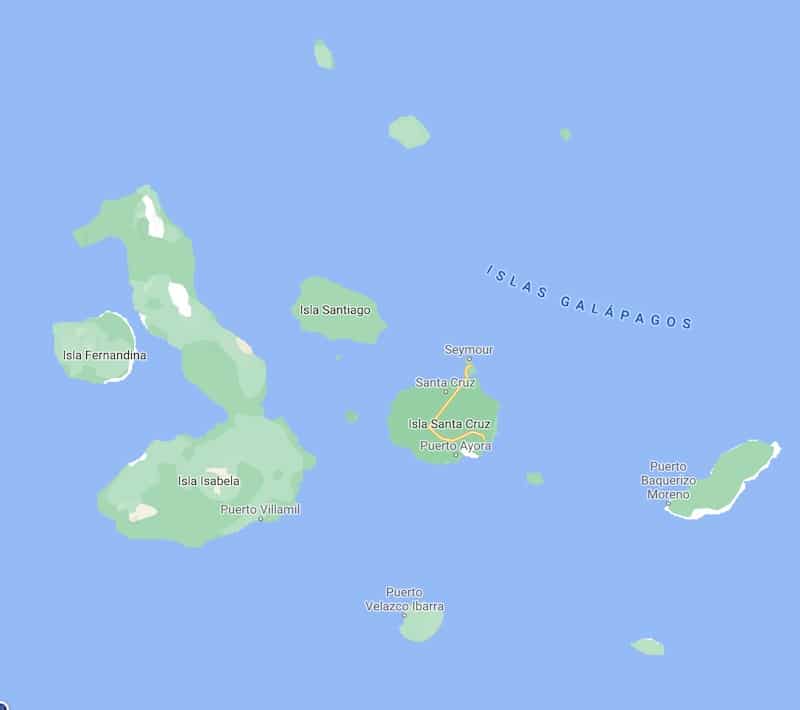
Click here for an interactive Google Map version of the above graphic.
Galapagos Islands Cruise
Thinking about taking a Galapagos cruise ? These guides can help!
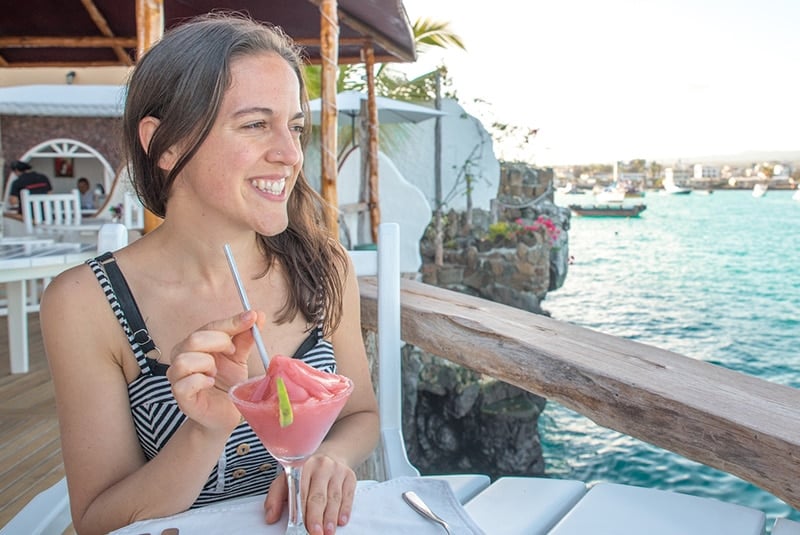
Best Galapagos Islands Itinerary: M/Y Passion Yacht Luxury Cruise + Puerto Ayora
Galapagos Travel Guides
Plan the ultimate trip to the Galapagos Islands with the help of these itineraries and excursions!
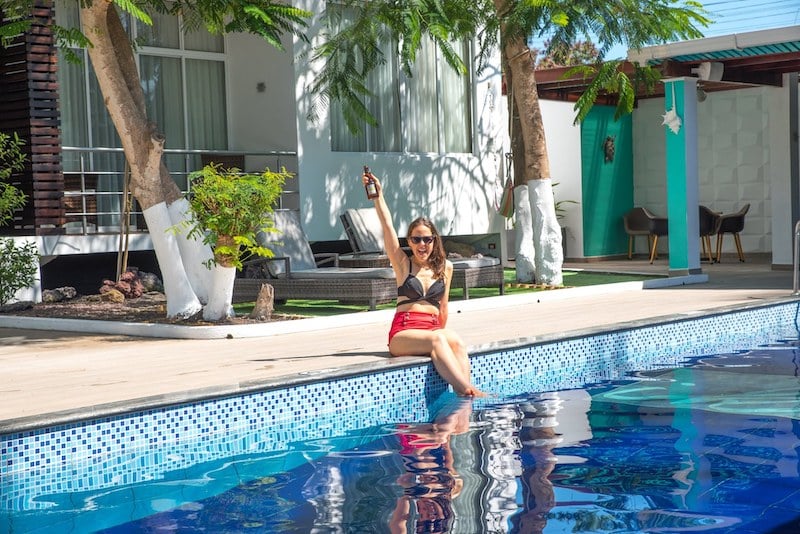
12 Things To Do In Puerto Ayora + Day Trips
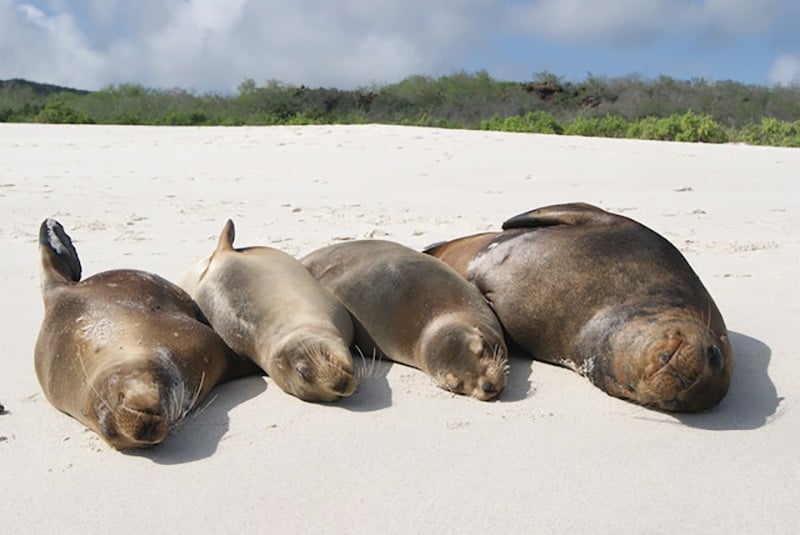
How To Visit The Galapagos Islands On A Budget
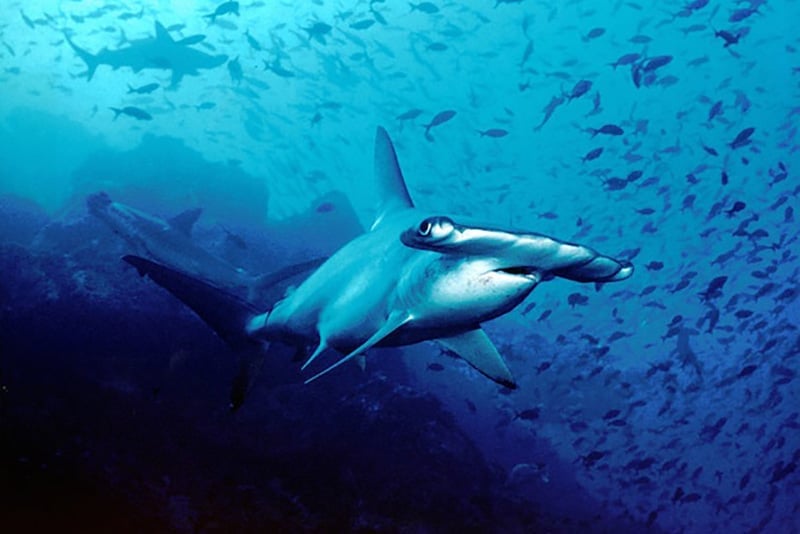
How To Swim With Sharks & Sea Lions In The Galapagos Islands
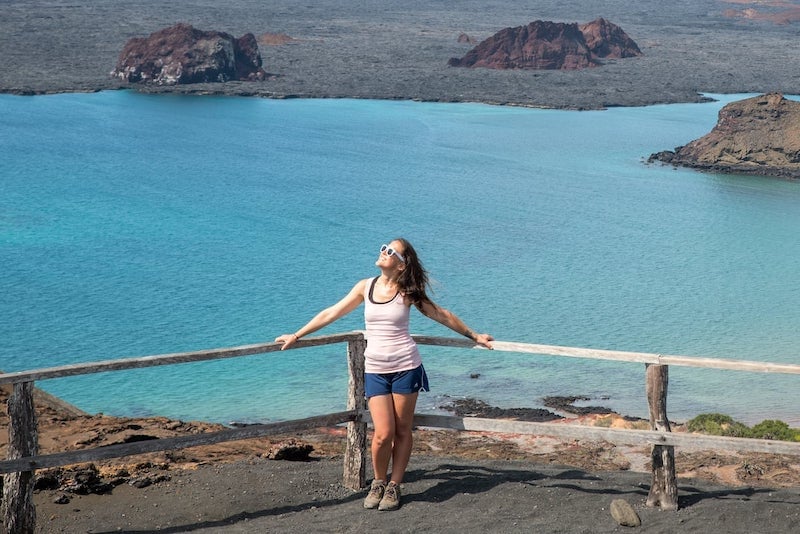
21 Best Places For Solo Travel In South America
Galapagos Travel Videos
Explore Galapagos travel through video!
Packing For A Galapagos Cruise During Mist Season
Puerto Ayora + Day Trip To Las Bachas & North Seymour Island
M/Y Passion Ship Tour: A Galapagos Islands Luxury Yacht
Seeing Pacific Green Sea Turtles In Galapagos – M/Y Passion Luxury Cruise Day 1
Genovesa Island Galapagos: A Bird & Wildlife Adventure [Cruise Day 2]
Galapagos Remote Islands: Exploring Marchena & Santiago [Day 3]
Hiking Dragon Hill & Bartolome Island In The Galapagos [Day 4]
5-Day Galapagos Islands Cruise Aboard The M/Y Passion Yacht [4K]
Best Galapagos Tours
Explore local culture with a Galapagos tour guide through these unique excursions:
- Tour Lobos Island from San Cristobal
- 7-Day Galapagos Island Hopping Budget
- 6-day Multi Sport Tour in Galapagos including Isabela
- Full Day Seymour North Island & Las Bachas from Puerto Ayora
- Day tour to Pinzón Island and La Fé/Palmitas Bay with Snorkeling & Fishing from Puerto Ayora
- Full Day Bartolome Island & Sullivan Bay from Puerto Ayora
- Full-Day Yacht Tour to Floreana with Snorkeling and Fishing from Puerto Ayora
- The Giant Tortoise Experience | Lava Tubes + Los Gemelos from Puerto Ayora
- Bartolome Island Full-Day Tour: Snorkeling & Hiking Trip from Santa Cruz
Galapagos Hotels
Click here to browse the best Galapagos travel hotels!
Prefer self-contained stays?
Click here to check out unique local rentals !
You can also use this map to search for local stays:
Galapagos Travel Insurance
It doesn’t matter if you’re traveling solo or with a group on a Galapagos tour. When visiting the Galapagos Islands — or any other country in the world — make sure to get travel insurance to protect your health and safety.
In my opinion, the best travel medical insurance for travelers is SafetyWing as they’ve got a large network and offer both short-term and long-term coverage — including coverage if you’re traveling for months as well as limited coverage in your home country).
Additionally, SafetyWing is budget-friendly and offers $250,000 worth of coverage with just one low overall deductible of $250.
With coverage, you’ll have peace of mind as you embark on your Galapagos travel itinerary.
Click my referral link here to price out travel insurance for your trip in just a few clicks .
Galapagos Travel Guide FAQ
Below, find answers to frequently asked questions about traveling in the Galapagos .
Q: What are the best places to visit in the Galapagos?
One of the top places to visit in the Galapagos is Santa Cruz Island , home to many of the archipelago’s top attractions.
Here you’ll find Tortuga Bay , arguably one of the most beautiful beaches in the world and one of the top places to spot the Galapagos’ most iconic animals.
Tortuga Bay gets its name from the many marine turtles who come to the beach every January and February to lay their eggs. The beach is also home to plenty of other critters like iguanas, sea lions, Sally Lightfoot crabs, and more. It’s definitely one of the best beaches out there for nature lovers.
You can spot some more native wildlife at Rancho Primicias , a private farm best known for its giant tortoise reserve. You seriously won’t believe the size of these guys until you see them!
And for the science nerds out there, the Charles Darwin Research Station is definitely worth a visit for its collection of natural history specimens, animal conservation efforts, and research exhibits.
There is also plenty to see on San Cristobal Island , just a few miles east of Santa Cruz.
A favorite of many visitors to the island is Isla Lobos , a scenic beach that’s a favorite hang out of the island’s sea lion population. You’ll see plenty of sea lions sunning themselves along the shore here, though you’ll want to enjoy them from a distance as they can get a bit territorial.
The beach is also great for swimming and snorkeling for those looking to take a dip in the Pacific.
Looking for a more remote adventure? Hop a dinghy out to Kicker Rock , or Leon Dormido , to check out some of the spectacular marine life that gather around this isolated rock formation.
Once you’re back on the island, enjoy a stroll through Puerto Baquerizo Moreno, San Cristobal’s main town and the capital of the Galapagos Islands. Here you’ll find plenty of colorful architecture, the islands’ Natural History Museum and several shops and restaurants.
The archipelago’s largest island, Isabela Island , has lots to explore both by land and sea.
Hikers will want to visit Chico Volcano and the Sierra Negra Volcano for thrilling treks and incredible views. Both volcanos offer unique perspectives and a peek into the archipelago’s formation millions of years ago.
For an interesting view on how nature and modern life come together, head to Albemerle Point, the site of an abandoned US radar base from World War II that is now a nesting point for flightless cormorants. Surprisingly, Albemerle Point is one of the most remote points in the Galapagos with no boat landings allowed, but book a boat tour and you’ll get some great views of these unique birds.
Isabela Island also has tons of great spots for divers, though most require a fair amount of experience due to their strong currents. Snorkelers Cowley Islet and Tagus Cove offor some amazing underwater views of the local marine life.
Q: How much does a Galapagos trip cost?
Despite the ubiquitous high-priced tours that most people think of when they start planning a trip to the Galapagos, independent travel around the islands is surprisingly budget-friendly.
Travel to the Galapagos will likely be your biggest expense, as you’ll need to fly into Ecuador and then hop on another flight to the islands themselves. Once you arrive at the islands, though, you’ll find that things like food and budget accommodations are not prohibitively expensive.
The average traveler spends about $111 per day in the Galapagos Islands on food, accommodations, transportation, activities, and other travel expenses. Also note that the fee to enter the Galapagos National Park is $100 per adult.
Q: What is the best way to travel around the Galapagos?
The best way to get around the Galapagos Islands is by boat. Whether you’re cruising the islands or just hopping on a boat transfer between islands, this is the best way to reach different parts of the archipelago.
There are also several inter-island ferries throughout the islands that will set you back about $25 to $35 per person.
You’ll need to fly from mainland Ecuador to reach the islands, but inter-island flights really only run between the main islands like San Cristobal and Isabela. Flying is certainly a quicker way to get around, but it’s definitely one of the more expensive modes of inter-island transportation and one of the least convenient.
Once you’re on the islands, consider renting a bike to explore the downtown areas. Public transportation can be hard to come by on most islands, so biking is an inexpensive and easy way to get around.
Q: Is it safe to travel to the Galapagos Islands?
The Galapagos is considered a safe destination. Crime rates are pretty low, though you’ll want to exercise standard precautions when it comes to petty crime like pickpocketting.
Always be aware of your surroundings, don’t flaunt any obvious signs of wealth and keep any valuables in a safe place, particularly in major tourist areas. Basically, know important tips for how to protect yourself from pickpockets .
The islands’ environment poses more of a risk to travelers, though there are many ways to stay safe.
The sun is particularly strong in this part of the world so you’ll want to wear sunscreen whenever you go out (and don’t forget to reapply!).
Hats and appropriate clothing are also a must. Consider bringing special sun-protective clothing with UPF on your trip for extra protection.
Also, take care on diving and snorkeling excursions, as tides and currents can be very strong. Make sure you’re going out with a reputable tour group leader as well, and see if they’re equipped with surface markers or other equipment to help you find your way back to the group if you get swept away.
Q: What do I need to know before going to the Galapagos?
One thing to know before going to the Galapagos is that there are very few ATMs on the islands. You’ll want to consider getting a fair amount of cash out before you head to the islands so you’re not stuck in a tight situation.
And considering the remote nature of the islands, you’re going to want to bring cash vs relying solely on credit cards. Also, remember that the currency in the Galapagos Islands is the US Dollar – good news for American nationals traveling to the islands!
It’s also important to stay on the designated trails and stick to designated visitor locations throughout the islands. Many areas are off-limits to tourists in an effort to conserve the islands, and heading off the beaten path could be dangerous for both you and the environment. Tour guides can come in handy here; be sure to ask if you’re not sure where you can and can’t explore.
If you’re planning on booking a Galapagos cruise , know that the quality can vary greatly. For instance, on a budget cruise, you may find yourself sharing a cabin with a stranger, paying extra fees for certain things, and dealing with lower quality equipment.
Do your research and be sure you know what life will be like on board before you book, as even budget cruises in the Galapagos can get pricey. Always look up what’s included in the price, the amount of guests on board, cabin styles, and any other questions you may have before committing.
Q: How many days should you spend in the Galapagos?
Most experts recommend spending at least 7 days in the Galapagos in order to maximize your time on the islands.
Traveling to the islands can take quite a bit of time and, depending on where you’re traveling from, you may need some extra time to acclimate to the environment and time zone.
If you’re planning on doing some island hopping, you’ll also need to factor in time to travel between the islands. A week-long trip will give you enough time to visit a few islands and see many of the gorgeous sites in this archipelago.
Q: What is the best month to visit the Galapagos?
The warm season, running from December to May, is considered the best time to visit the Galapagos. Temperatures are usually in the 70s and 80s Fahrenheit during this time and you won’t run into a ton of extreme weather.
This is also the perfect time for outdoor activities and active travel adventures on the islands. This is also the most popular time to visit the islands, so you’ll probably want to book your travel far in advance to beat the rush.
Q: Do I need an Ecuador travel visa?
Visitors from the United States, Canada, the United Kingdom, Australia, and the European Union do not need a visa to enter Ecuador. Visitors from several South American countries, including Bolivia, Colombia, Argentina, Chile, Peru, Paraguay, Uruguay, and Brazil simply need to show their national ID to enter the country.
It’s recommended to view your country’s Ecuador International Travel Information page for the most up-to-date information on entry and exit rules and Ecuador Travel Requirements. You can also contact the Consulate General of Ecuador.
Q: Where is the Galapagos?
The Galapagos is an archipelago in the Pacific Ocean off of mainland Ecuador in South America. The destination is located about 605 miles (1,000 kilometers) from South America.
Q: Are credit cards accepted in the Galapagos Islands?
While hotels and tourist establishments often accept credit cards — particularly Visa and Mastercard — you’ll mainly use cash while exploring the Galapagos Islands. Note that you’ll often likely spend less when paying cash as many businesses in the Galapagos tack on a 5%-10% credit card fee.
Q: Can you drink the tap water in the Galapagos Islands?
The tap water in the Galapagos Islands is not safe to drink.
Q: What is the local currency in the Galapagos Islands?
The local currency in the Galapagos Islands is the US Dollar (USD).
What would you add to this Galapagos travel guide?

Enjoyed this ultimate Galapagos Islands travel guide? Pin it for later!
One week in the Galapagos islands
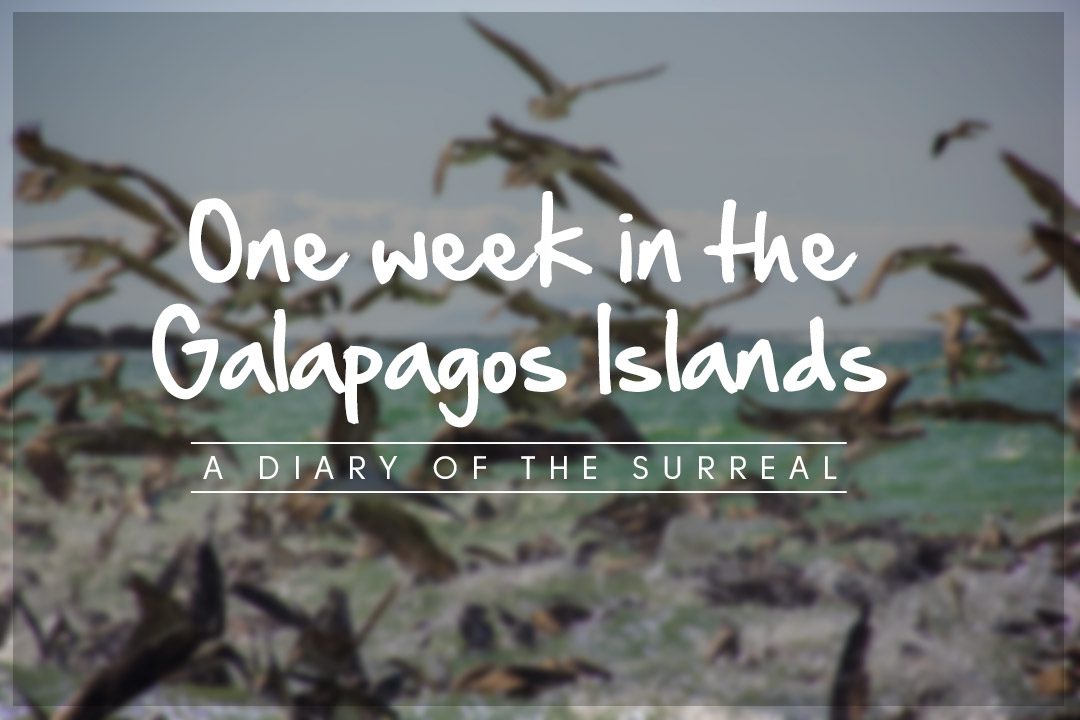
‘It feels like I’m not supposed to be here’: my first thought as the Galapagos Islands appeared through the aeroplane window.
It felt as though we were descending into Jurassic Park, or some sacred land that I wasn’t deserving enough to enter. I was glad to be there, don’t get me wrong, but I didn’t feel worthy. This was the Galapagos .
Yeah, that initial glimpse of the islands was humbling. But I’d soon learn that thankfulness is a feeling you’ll experience most days in the Galapagos Islands. With each new wildlife discovery and each new encounter, gratitude is the most common reaction.
And these islands should be admired. They should be understood and prized by as many people as possible. There is nowhere quite like them, certainly not anywhere that I’ve been, and the week I spent there with Intrepid Travel blew my mind in more ways than I thought imaginable.
This diary starts in Baltra, the main airport in the Galapagos Islands , after two heady days in the incredible Quito.
Follow the adventure:
Day 1: Baltra and Santa Cruz Island
Once we cleared customs – which was a fairly rigorous process of form filling, baggage checking, and line waiting – in Baltra we met our leader, Oswaldo Noboa (who’s a naturalist, not a naturist) and boarded a bus bound for the dock. And, presumably, adventure.
Our boat, Nemo III – a beautiful catamaran, originally built in Italy – was waiting on arrival. There’s a Jacuzzi on board that was brought into existence by her original Italian owners, but Galapagos sustainable tourism practices means we can’t use it (it requires hot water, which requires power, which is deemed an unnecessary use). A crying shame on one hand, a win for the planet on the other.
Once on board, we took a short trip to Santa Cruz Island and made a wet landing on Bachus Beach. There, sea lions, marina iguanas, Sally Lightfoot crabs, blue-footed boobies, frigatebirds, pelicans and a sole flamingo were waiting.
The amount of interaction we had on this first day was pretty overwhelming (see feature image). A bunch of fish in the shallows meant that we were lucky enough to witness a boobie, pelican and frigatebird feeding frenzy take place along the beach. It was so impressive that at times you could barely make out the horizon through the rabble. And the horizon is big .
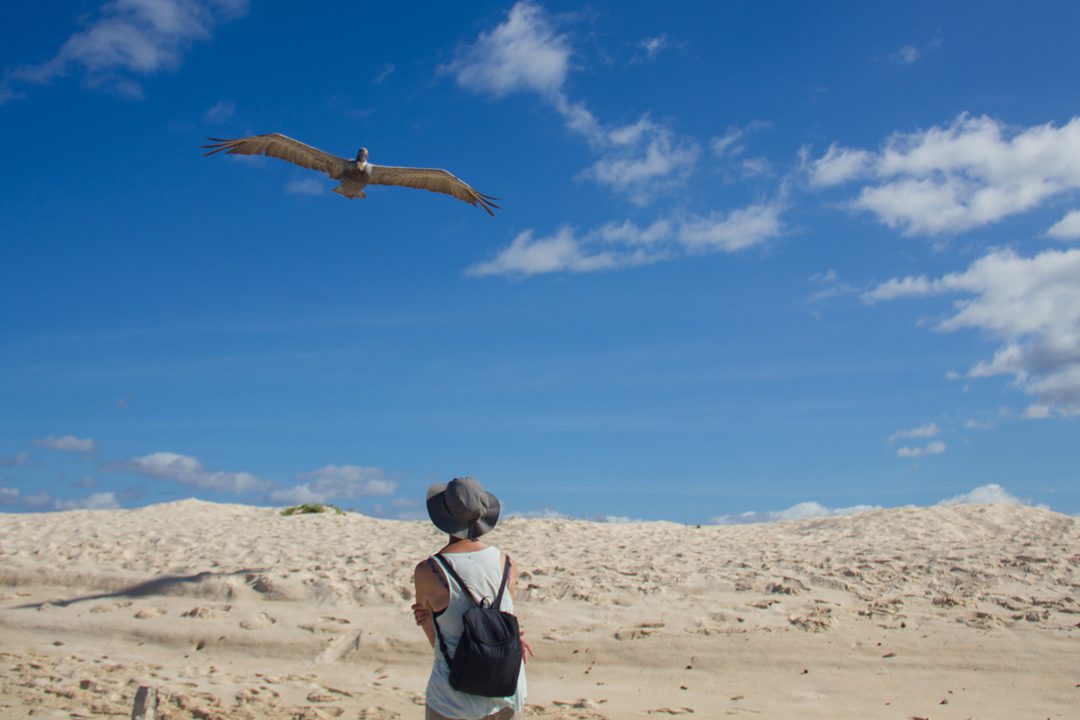
A not-so-rare pelican encounter
We strolled the beach, following the fishing spectacle, and took a thousand photos then swam for a while before reboarding Nemo III.
We met the crew, shared some drinks and swapped stories before settling in for an incredible dinner of camarons (prawns). It’s been am awesome day. But I’m a little jetlagged, a little seasick, a little drunk and have little else to say about it. Tomorrow we will arrive at Genovesa Island, for more bird watching and some snorkelling. Good.
Day 2: Genovesa Island
Sleep was good. It’s completely unsurprising how tiring it is to be walking and snorkelling all day and I can’t even begin to describe how exhaustinge boat life is. Split between eating, drinking and talking, the hours tick by at an alarmingly leisurely pace.
This morning I awoke an hour early for breakfast, because I forgot to set my clock back an hour when I arrived. But what I lost in sleep was more than made up for by watching the sunrise over the prehistoric façade of Genovesa Island. Well, almost.
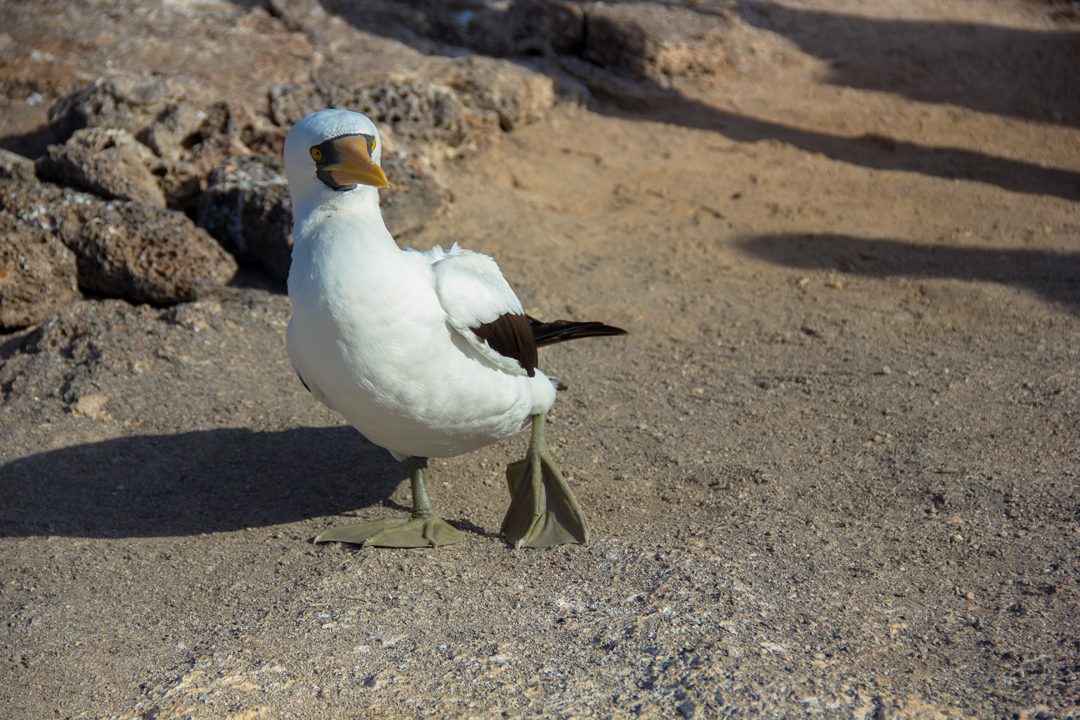
Masked boobies: the goodlooking seagulls of the Galapagos
We took a short boat ride to some steps that ascended the steep cliff and arrived, after climbing said steps, at a clearing, in which masked and red-footed boobies were going about their business as if mankind had never set foot on their turf.
We walked for a short time across the top of Genovesa. The sun baked; we perspired. We saw masked boobies for the first time and I concluded that they were my favourite of all the boobies (except, y’know).
Then we saw red-footed boobies and I reconsidered my conclusion about masked-boobies for a short time, before returning to my original conclusion. They look like big, handsome, clean and thoroughbred seagulls, without any of the annoying sandwich-stealing tendencies.
Related: Fill your own diary. Explore the Galapagos Islands with Intrepid Travel.
We walked to the other side of the Genovesa ‘peninsula’: a rounded semi-cone in the middle of which a volcanic crater once spouted hot stuff. We’re told that masked boobies can’t nest in the trees because they’re too heavy. For a moment I feel sorry for them, but only for a moment.
Once through we reached the clearing we were greeted by a black-on-blue display of Galapagos birds against the sky. Underneath the commotion, the cliff top rolled away and into a sheer drop that none of us, nor any travellers before or after us, would ever see. The thought of a completely unviewed panorama from the northern side of Genovesa Island is as close to perfect as I could imagine. Just as some things are better left unsaid, surely some things are better left unseen.
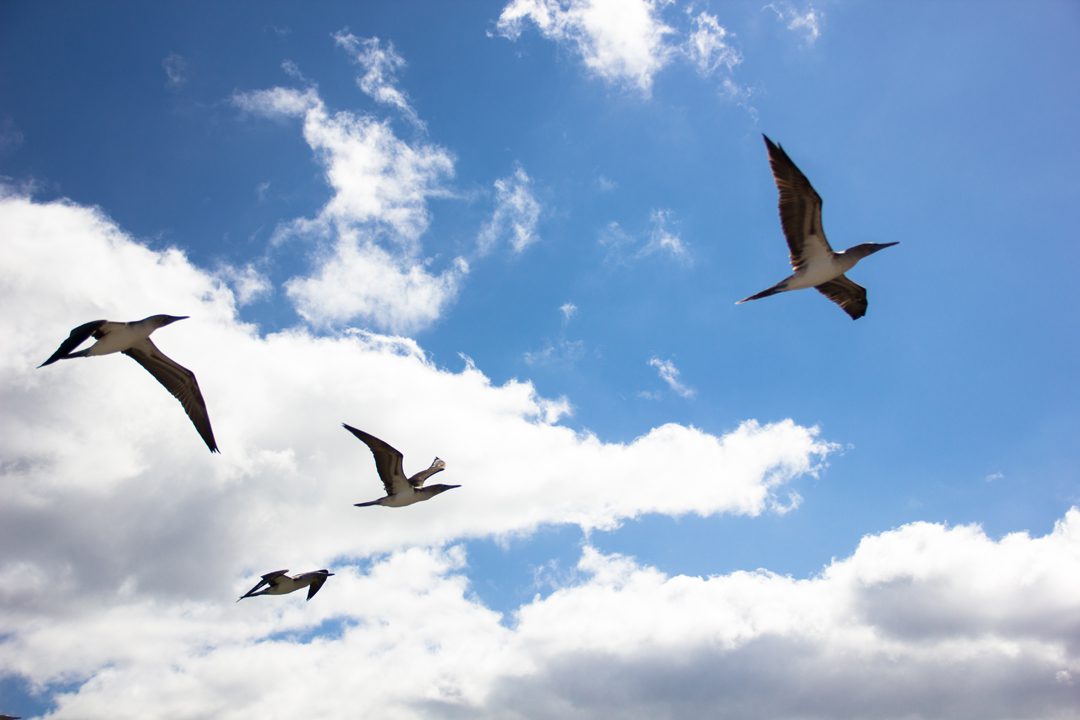
Boobies on Genovesa: not camera shy.
One thing that’s difficult not to be struck by in the Galapagos Islands is how the majority of the wildlife doesn’t so much as flinch when approached by humans. Where seagulls would scatter amongst the sky, boobies sit quietly and watch you pass without giving so much as a second glance.
“I could say the place looked like Mars, or the moon, but that would be cliché and truth be told I have absolutely no idea what either of those places look like.”
After our walk, we returned to Nemo III for lunch after which we climbed aboard the dinghy again and travelled a short distance to a beach, on the opposite side of the crater from our morning excursion.
Here we found sea lions (who are completely adapted to doing bugger all) doing bugger all. We enjoyed another short walk, and saw more red-footed boobies and juvenile frigatebirds.
A small saltwater pool greeted us after 10 or so minutes of walking. In it, a sea lion pup was tossing fish around and playing catch with itself. Imagine if we could teach domestic dogs to play catch with themselves. Imagine.
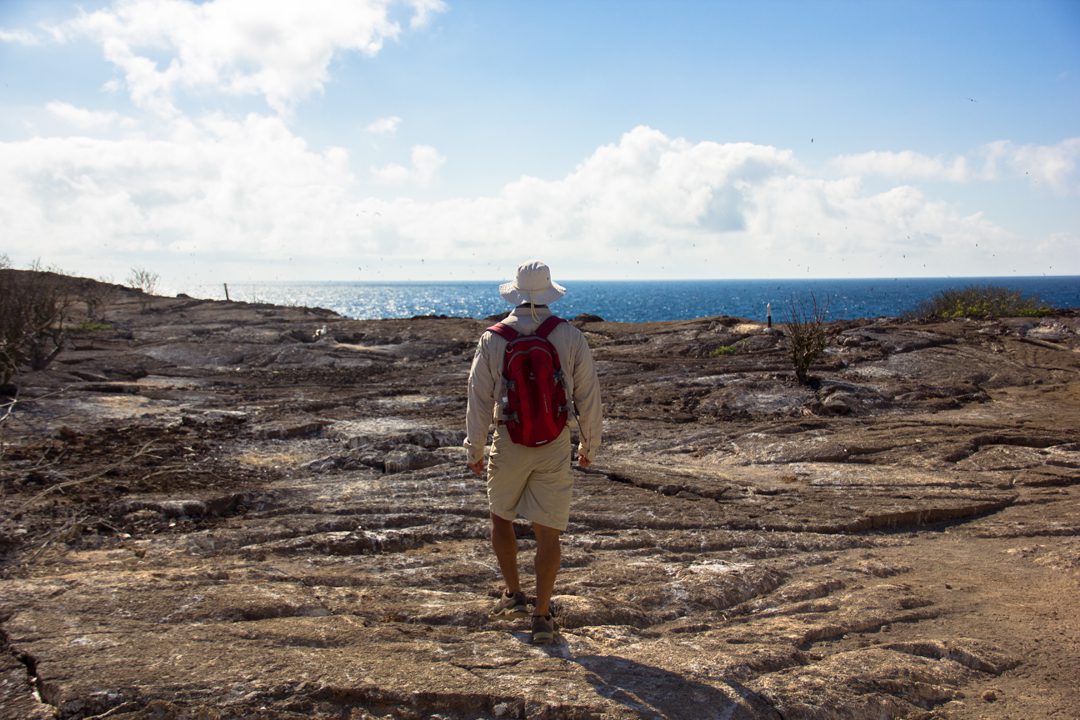
Oswaldo, approaching the edge
After we unsuccessfully tried to encourage the sea lions to play with us in the shallows for a while, we headed back to Nemo. We ate and set sail for Sullivans Bay, on Santiago Island.
Day 3: Santiago Island, Sullivans Bay and Dragon’s Hill
We awoke to the serenity of Sullivan’s Bay. Pinnacle Rock was close by, though not many seemed to pay attention to it. Many other islands and chunks of land were visible too. Breakfast was a feast of hot food and fresh fruit, as it seems is the norm aboard Nemo III. We took a boat to shore, which was an enormous lava field.
Lava fields might not sound that interesting or spectacular. I for one, even having read plenty about them, didn’t expect to be affected by them much. But once you begin walking across the field, and you find yourself considering that everything underfoot was once flowing, molten lava, it’s impossible not to feel something. I felt grateful. Grateful to be there, and equally grateful not to be there in 1867, the last time the volcano erupted.
Explore the lava fields on Sullivans Bay by clicking around the below image:
I could say the place looked like Mars, or the moon, but that would be cliché and truth be told I have absolutely no idea what either of those places look like. What it did look exactly like, however, was a field of frozen lava, black, whole; a spectacle completely without time.
Oswaldo told us a story about the human history of the Galapagos Islands. Specifically, it focused on the American occupation during WWII, the Wall of Tears and the Penal colony. It ended with Oswaldo announcing that the two main characters in his story – an eight-year-old boy and a policeman – were his grandfather and his great grandfather. Oswaldo, who moved out here when he was 15-years-old, is tied inextricably to this place.
Snorkelling followed soon after. The water was welcoming after the walk, during which we were sandwiched between the hot lava rock and the hot sun. We were able to play with a sea lion for the first time, which was nothing if not far more novel than playing with a dog.
“We are now bound for I don’t know where, because I haven’t checked the itinerary. But I know that it’s going to be unlike anywhere I’ve been before.”
We snorkelled for one hour and ten minutes. Jack – an Australian from Sydney who’d already been travelling for a few months – and I went ahead to try and spot some sharks before the splashing of the rest of the group scared them off. And it worked. I saw a whitetip reef shark for a few seconds, but by the time I turned around to alert Jack of its presence, it had gone. I’d never swam with sharks before.
A short while after, just as I was considering turning back to the boat because I could feel my neck getting sunburnt, I saw a Galapagos penguin through the water, like a cute torpedo. That penguin was at once the reason I stayed in the water for a further 20 minutes and the reason I have just emptied an entire bottle of aloe vera on my neck.
Play with Galapagos sea lions by clicking around the below image:
As if all of the above wasn’t exhausting enough, Nemo then cruised to Dragon’s Hill, named so after it’s population of land iguanas. As soon as we disembarked the zodiac boat, we spotted marine iguanas in the water, whitetips resting near the shore and sea turtles. The place was a veritable hangout for Galapagos rock stars.
We walked for an hour, maybe more, through the hinterland and up to a small hill, which offered panoramas of aforementioned landscape and its beach and its lagoons. I spotted a big old ship in the distance with its sails up. If I looked just the right way and cut out all the other, more modern boats of my peripheral, I could well have been in the 1600s. I wasn’t, though, and I had a DSLR camera around my neck. So I took it out and took a photo of it. The picture didn’t turn out very well.
Related: Discover the Galapagos Islands with Intrepid Travel
On the way back to the zodiac we came across two land iguanas. They were bright yellow and much larger than their waterborne cousins. Oswaldo thought they were going to have a fight, but they didn’t. So that was that.
Back on board Nemo we jumped straight into the water – we were soaked with sweat and ready to cool our bones. We are now bound for I don’t know where, because I haven’t checked the itinerary. But I know that it’s going to be unlike anywhere I’ve been before.
Day 4: Santa Cruz Island (Puerto Ayora)
Turns out that Puerto Ayora was pretty similar to places I’d been before. It’s the most populated town in the Galapagos and a bit of a tourist hub. We got up early to make tracks to the Charles Darwin Research Centre – the focal point for much of the scientific research that takes place in the Galapagos Islands – and arrived around 7.30am. It was dead quiet. No tourists around at this hour; just the increasing heat and the imposing stench of giant tortoise poo.
We didn’t get to see any of the labs, which was a bit of a shame, but we did see young giant tortoises, the smallest of which were no longer than four or five inches, so they just looked like regular tortoises. The adult ones didn’t even look real.
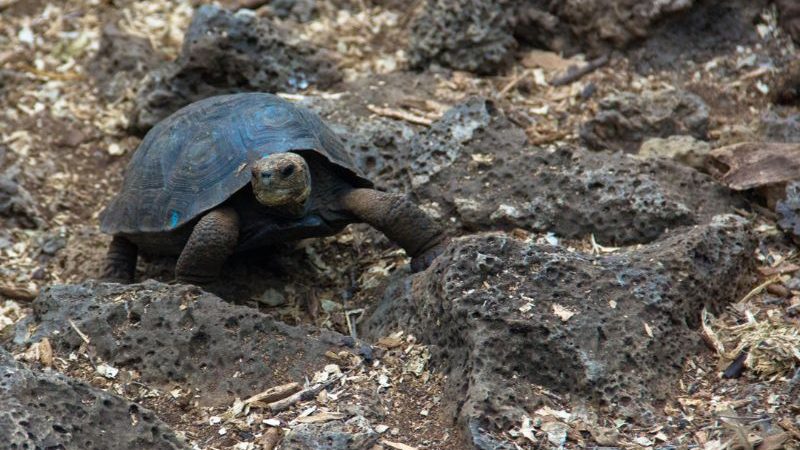
A non-giant giant tortoise
We saw the pen in which Lonesome George, the last Pinta giant tortoise lived before he passed away in 2012. The guide then went on to tell us how Lonesome George didn’t want to reproduce with either of the two females who were not-so-subtly placed in his pen.
George’s disinterest in these shell-clad damsels would eventually lead to the extinction of his subspecies. Earlier in the tour, our guide had explained how scientists are able to choose the sex of the tortoises they breed – 28 degrees and you get a male, 29 degrees and you get a female. Guido, an Italian on our trip who had a knack for saying the wrong thing at the right time, pointed to a picture of Lonesome George and said:
“30 degrees: gay.”
Thanks to Guido, I spent the rest of the tour pondering whether or not the scientists had done much research into homosexuality in giant tortoises. They must have, I thought, because the rest of their research into why Lonesome George didn’t want to reproduce had been inconclusive. And if George wasn’t gay, maybe the pressure was just too much for the poor chap.

Giant tortoises: keep off the grass.
Later, we travelled into the highlands and saw some giant tortoises in the wild. I much preferred this to seeing them shut up in pens. I mean; I know the Charles Darwin Research Centre is essential for breeding, research and other scientific stuff, but seeing these not-so-wild beasts in their natural habitat was a real thrill. And I use ‘thrill’ in the tamest imaginable sense of the word.
In the afternoon we spent free time in the town. Free time consisted of a couple of beers in a colourful bar whilst watching local kids skateboard and play volleyball. It was at this point I noticed that whenever I sat down I felt a strange, side-to-side rocking sensation, as if I was still at sea. The beers didn’t help, either.
Day 5: Isabela Island (Urvina Bay)
Today started with I can’t remember what because today is actually the day after today. I neglected to write yesterday, so I’m trying, with some difficulty, to recollect what we awoke to. I believe it was something like: big hunk of land, lava formations, volcano, ocean, birds – in no particular order. All that may not sound too impressive, but I can assure you that it was. I think.
After the bit I can’t remember, we took the zodiac to shore and proceeded to walk across some more old lava formations on Isabela Island. This lava was far rougher and older-looking than the stuff we’d seen before. Oswaldo told us a story about a young American student who walked off the track six years ago and fell 20 metres to his death. The most striking part of the story was that his girlfriend, who was travelling with him, didn’t even notice he was missing until dinner that night. After the story, we saw some flamingos and sweated a little. It was hot.
“For most places in the world, the clichés will usually do. But there are no ‘beautiful vistas’, ‘awe-inspiring panoramas’, or ‘serene landscapes’ in the Galapagos Islands”
After the sweating, we took a short detour en-route back to Nemo and saw a host of animals that had colonised some rocks. You could’ve fit sea lions, marine iguanas, sea turtles, blue-footed boobies, Galapagos penguins and pelicans all into the same photo. I say ‘you could’ve’ because I didn’t, but I’m sure someone else has at some other juncture.
The afternoon went something like: snorkelling with sea turtles (which was by far and away one of the most incredible experiences I’ve ever had), spotting a seahorse whilst snorkelling, visiting a black sand beach, snorkelling with Galapagos penguins off the black sand beach, taking a short stroll back from the beach and encountering land iguanas and giant tortoise, sampling some home made grappa from the four Hungarians who recently joined Nemo III, bed.
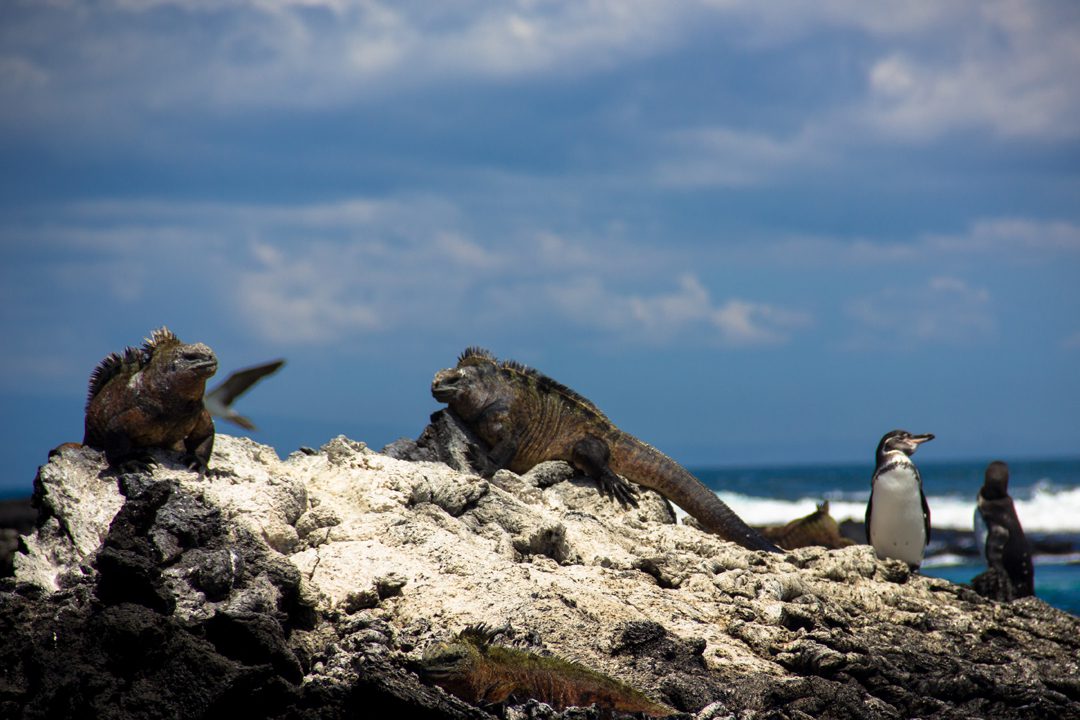
In the immortal words of the Spice Girls: “Iguana be my lover, you better get with my friend. My friend is a penguin.”
I keep trying to think of words and phrases to describe what I’m seeing here but I can’t. For most places in the world, the clichés will usually do. But there are no ‘beautiful vistas’, ‘awe-inspiring panoramas’, or ‘serene landscapes’ in the Galapagos Islands. It’s all so much more than that. Anything less than what’s required would be an insult to Isla Galapagos, so please bear with me whilst I try and figure out what I’m trying to say.
Day 6: Fernandina and Isabela
I felt exhausted when I woke up today. The Hungarian’s generosity with their grappa may have had something to do with it. I don’t even know what grappa is, or if that’s how you spell it, but it was pretty tasty for a home made-drop. And I’m not blind, so that’s good.
The zodiac took us to the shore or Fernandina around 8am. The sky was grey, which was good – the sun here burns quicker than any sun I’ve ever met. We walked across more lava rock, interspersed with beach and mangroves, and saw the biggest mob (we don’t know the collective noun for them) of marine iguanas we’ve seen yet. The place also stunk. Apparently that’s what happens when you leave a bunch of marine iguanas and sea lions to laze around in the searing heat all day and get a bunch of birds to poop all over them. Who knew?
The best part, for me at least, of being on Fernandina was that we saw an Orca from the shore. We didn’t see much, just a few glimpses of the dorsal fin in the far distance, but it was still one of the greatest things I’ve ever witnessed. Pure power.
“…our debarkation would likely be busy. Or busy at least for Galapagos, which is defined by having around 40-50 people within your peripheral vision at any one time.”
After fresh juice (blackberry, I think) on Nemo we went snorkelling again. And again, we were blessed by the presence of sea turtles. Sea turtles are a lot like cows, with shells, that live underwater and don’t look like cows. They just kind of float around and graze on algae. If a cow ever found itself in water, I would imagine that after several thousand years it would eventually evolve into a sea turtle. And vice versa, if a sea turtle were to ever find itself on land. Ridiculous, maybe, but also maybe not.
We arrived at Darwin Bay after leaving the Fernandina and climbed some raggedy old steps, then a dirt path, up to a view of Darwin’s Lake – a lake that formed in an old volcanic crater. Apparently Darwin came here in search of water in 1835 and so they named the lake after him. Seems a bit over the top if you ask me.
The lake was nice, though, and Don (an older Australian gent) was glad to have made it up there. I could tell Don was glad to have made it up there because he asked Dane (a younger Australian gent) to take his photo at the top, which is usually a good indicator of someone being pretty pleased to have done something.
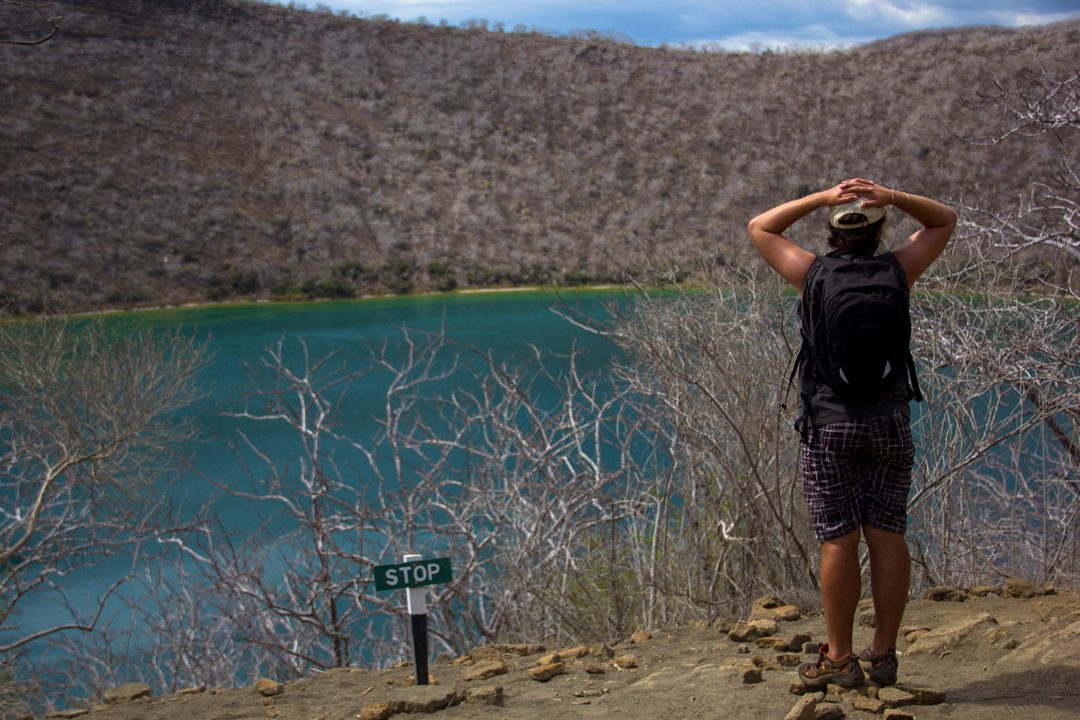
Jack: surveying the scene and obeying signage.
After the walk we were all hot so most people went swimming around Nemo, except my friend Hunter and I, who chatted with Oswaldo. He’s an interesting guy, and extremely passionate about the Galapagos, wildlife and conservation. It was good talking to him.
Now, we have a long navigation to our next port of call, Santiago Island. It’s 5.25pm and we expect to arrive around 5am. In about an hour and a half we will cross the equator (and have dinner). The beers taste good tonight.
Day 6: Santiago Island (James Port and Espumilla Beach)
There were about three or four boats anchored near us when we awoke this morning. This meant that our debarkation would likely be busy. Or busy at least for Galapagos, which is defined by having around 40-50 people within your peripheral vision at any one time.
We took the zodiac over to the shore – another one made of black sand – and were the last group to arrive. We were supposed to set off on a walk to find fur sea lions before snorkelling from the beach, but as the other groups had already started the walk, Oswaldo suggested we do snorkelling first.
Swim with the fishes by clicking around the below image:
It was a good suggestion – we had the entire beach to ourselves. We snorkelled among whitetip reef sharks and it was the best showing of them we’d seen so far. At one point, I looked down to find two swimming in circles no more than four feet underneath me. Mental.
I swam back to the beach to join the others and begin our walk, but I was distracted en-route by a sea lion that seemed game for a bit of rough and tumble. It shot forward and danced and dived up and under, blew bubbles, barrel rolled and generally made a spectacle of itself. It was an effort to keep up with the thing, and probably one of the best experiences I had on the trip.
Related: Peruse Intrepid’s Galapagos Island itineraries
The walk was similar to other Galapagos walks we’d had. Sparse landscapes fringed with wild oceans, overseen by anxious black clouds, iguanas laying all over the place, the click of camera shutters never too far away. We found the fur sea lions, which looked a lot like regular sea lions, before heading back to the beach and joining our crew from Nemo III for a quick game of football on top of a little lookout. It was a blast, until Jack popped a blood vessel in his leg and we had to cut it short. He’s a nurse, though, so he’s in good hands.
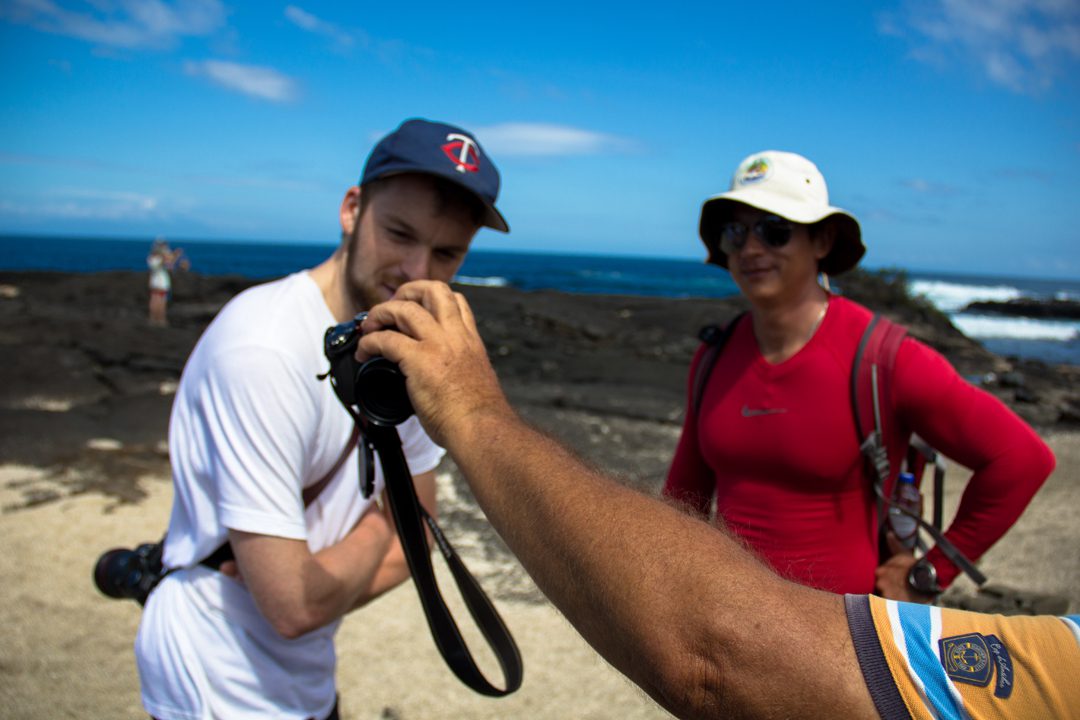
Sharing photos. Probably photos of animals.
After lunch we snorkelled off the dinghy at Espumilla Beach. White-tips, a solitary sea turtle and a load of fish were in there (the ocean) to greet us. We’re now bound, with the sails up, for I don’t know where (again). It’s our last night on Nemo III tonight, which is sad. It’s been an unbelievable week.
Day 7: Daphne, Baltra and Quito
Nothing much planned for the day, except the overwhelmingly sad journey back to normality. We awoke at dawn to watch, um, dawn, and do a couple of laps of Daphne Island before heading back to Baltra, then Quito, then home.
We left the crew and Oswaldo our tips, shook hands and said our sad goodbyes. Sometimes the end of a trip sees many folks glad to be heading home, but it didn’t feel like that today.
Some of our group went off to other islands to carry on their Galapagos explorations, some headed to Guayaquil and others onwards to Quito. I fell into the latter category and by the time we got back to the mainly our numbers were seriously depleted. Again, the sadness!
I sprawled out on my hotel bed and opened my laptop to flick through the thousands of photos I took whilst I was away, desperate to hang on to the trip for as long as I could.
And as I did so, I again felt a very real sense of gratitude wash over me. The Galapagos Islands are surreal. And as I write this, the last entry of a weeks’ worth, I find it difficult to comprehend just how unbelievable the past few days have been.
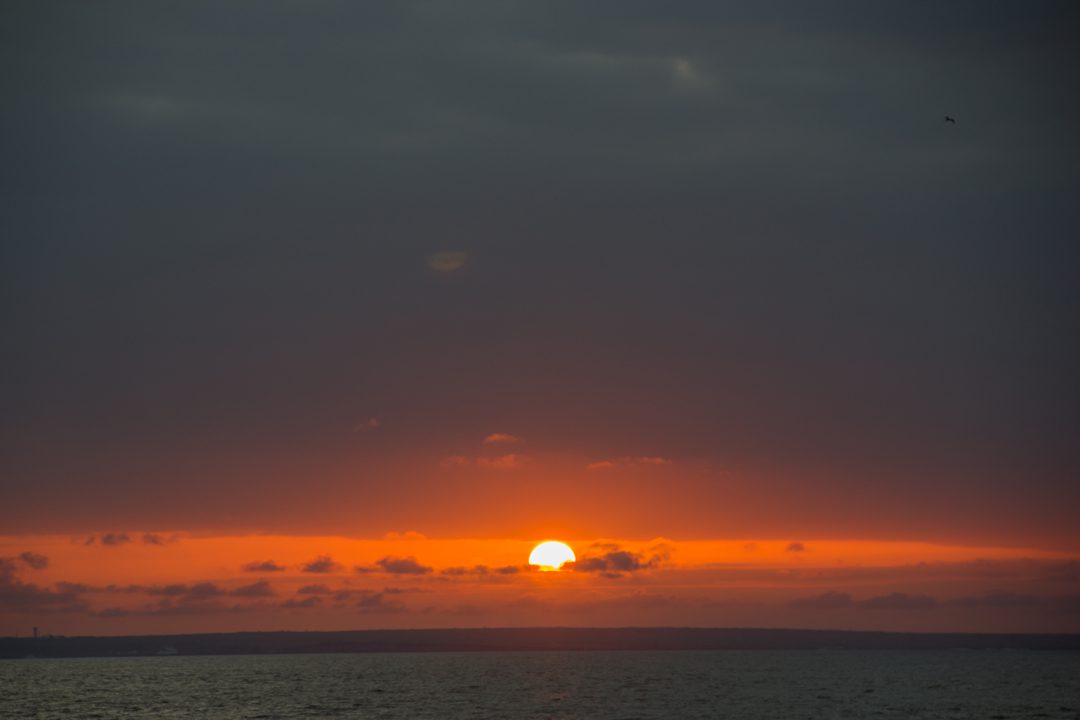
One last Galapagos sunrise
Oliver travelled on Intrepid’s Galapagos Panorama trip. Explore all of Intrepid Travel’s Galapagos itineraries here.

Feeling inspired?
Oliver Pelling
I once drove a tuk-tuk 1200km around Sri Lanka. I enjoy food of the Mexican and Japanese persuasion (and Korean. And most others). I'm from England but I live in Melbourne, where it feels like I'm on holiday all the time. I write about travel, music and skateboarding. And I'm usually much wittier than this, but writing about myself makes me self-conscious.
You might also like
From delhi to udaipur, here are the five..., travel globally and think locally with intrepid leader..., follow the leader: tu vu will never stop..., turkey’s most underrated experience: mountain biking in cappadocia, the best thing about a family tour seeing..., why ninh binh and lan ha bay should..., love elephants here’s why you should visit mandalao..., why you should visit the most peaceful place..., what it’s like spending the night in a..., 10 things i wish i knew before hiking..., what i wish i knew before hiking to....
- South Africa
- Philippines
- Travel Resources
- Work With Us
- House Sitting Enquiries
Galapagos Travel Guide

“Dolphins!” shouted the captain, as he banged on the side of the boat. Everyone, including the crew, rushed to the front of the boat in time to see an enormous pod of dolphins launch themselves out of the water. We were grinning from ear to ear as we watched these beautiful animals flying out of the waves and nine metres into the air.
A trip to the Galapagos — a chain of islands on the equator in the pacific — will contain many amazing “Galapagos moments” like this one, from seeing 150-year-old giant tortoises in the wild to snorkelling with fearsome hammerhead sharks. In this blog, we’ll explain how to plan, organise and enjoy a trip to the Galapagos.
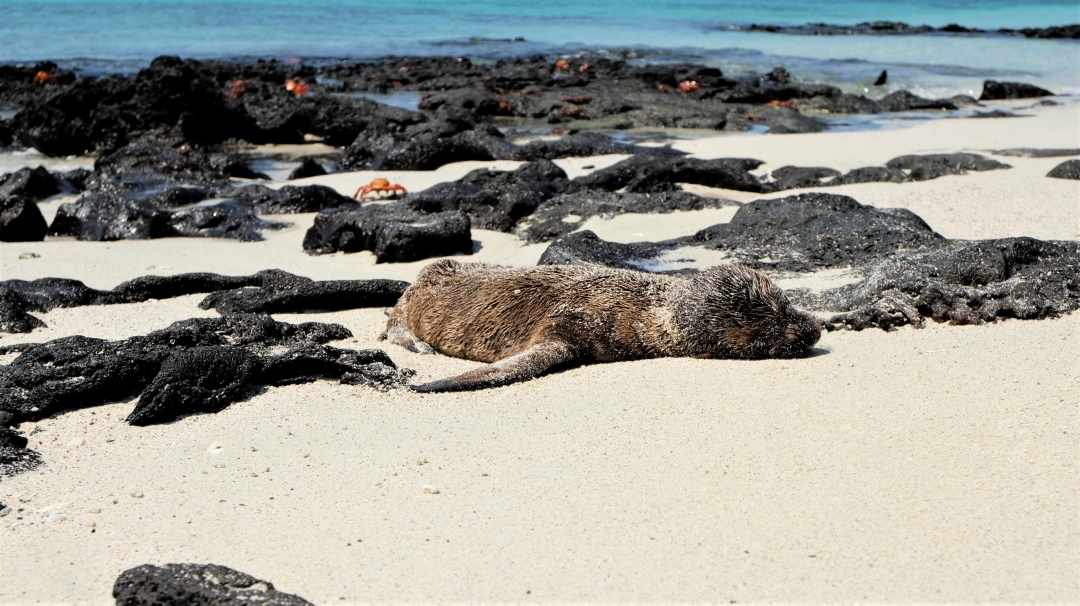
Animals of The Galapagos Islands
The animals of the Galapagos are its star attraction! You’ll see wildlife whichever islands you visit, but if you have a particular favourite, such as the Galapagos penguin or hammerhead shark, you should try to plan your trip around the spots where you’re most likely to see them.
Many of the animals of the Galapagos are endemic, meaning they can be found nowhere else on earth. Due to the low number of predators in the Galapagos, many of the animals are not afraid of humans. Some, like the superstar Galapagos sea lions, are playful and curious animals which are likely to come over and take a good look at you! Visiting the Galapagos is the closest you’re likely to come to seeing the natural world as it was before humans messed everything up.
I’ve included a table of interesting animals below. I’ve underlined the ones that we saw during our seven-day Galapagos trip, which we did in February 2020. I’ve included the locations and islands where you can see each animal too.

When Is The Best Time To Visit The Galapagos Islands?
You can see many animals all year round in the Galapagos. However, certain animals, particularly whales and dolphins, are more likely to be seen in a certain season. If you are interested in birds and reptiles, you might also want to time your visit to match nesting times.
There are two distinct seasons in the Galapagos: “summer” (sometimes called rainy season or hot season) which lasts from January until May and “winter” (sometimes called dry season) which lasts from June until November.
We visited in February 2020 and got lucky — we were able to see dolphins even though dolphin season is typically from July to November.
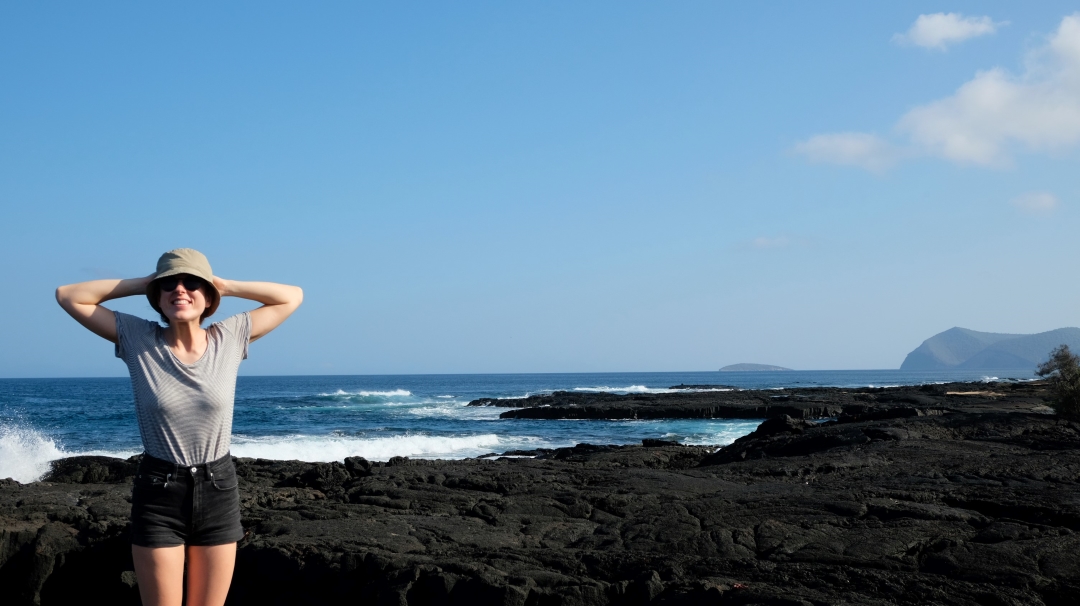
Planning a Galapagos Island Cruise
1. decide which animals you’d like to see and which islands you’d like to visit.
You’re coming to the Galapagos to see wildlife, so make sure the Galapagos island cruise that you pick will stop at the places where you’re most likely to see your favourite animals! Use the animals table at the start of this blog to help you plan.
2. Decide what time of year to visit the Galapagos
The best time of year for you will depend on your availability and the animals that you’d like to see! Use the table at the start of this blog to get an idea of when is the best time for your visit. If you want to see dolphins or whales, then your best bet is to come from June to September.
3. Decide what kind of boat you’d like to stay on
There are probably two factors to consider when picking a boat. 1) The number of passengers. If you pick a very big boat, you’re going to be sharing the snorkelling spots with a huge number of other people. This might reduce your chances of seeing animals. 2) Budget. Different boats have different prices. We identified a couple of boats in our budget then used TripAdvisor reviews to rule boats in or out. We decided against the budget option Golondrina, for example, because reviews said that the engine is loud throughout the night and we’re light sleepers. This travel agency site gives a good overview of your potential boats for the Galapagos island cruise . There are also luxury cruise options, such as those offered by Rainforest Cruises and Touring Galapagos .
4. Decide on your itinerary
Your itinerary is the route your Galapagos island cruise will take. Galapagosislands.com has the itineraries for each of the boats that they work with listed on their website. In my opinion, it’s best to choose an itinerary that spends as little time as possible around the islands of Santa Cruz and San Cristobal. These are both wonderful islands, but you can easily visit them on your own by adding a few days to the end of your trip. Instead, look for an itinerary that takes you to places that are difficult or impossible to visit by ferry.
You should also think about the length of time you’d like to spend on your Galapagos island cruise. Do you suffer from seasickness? A shorter cruise, either four or five days, could be your best bet. Do you want to get to a distant uninhabited island, such as Wolf? You’ll need to pick a longer cruise. We chose a five-day cruise that started on Santa Cruz and visited Isla Isabela, Fernandina and Santiago . We then travelled to San Cristobal by ferry to spend two additional days diving. For me, this was the perfect length of time that I needed to see everything.
5. Contact a travel agency to book your trip or contact the boat owners directly
It’s finally time to book your Galapagos island trip! I’d recommend double-checking everything — reviews, itinerary, your calendar — as this is a trip you’re only likely to do once and it’s important to get it right. We paid through a bank transfer and the process went smoothly. Your travel agent may book your flights for you, or you may decide to book your flights separately.
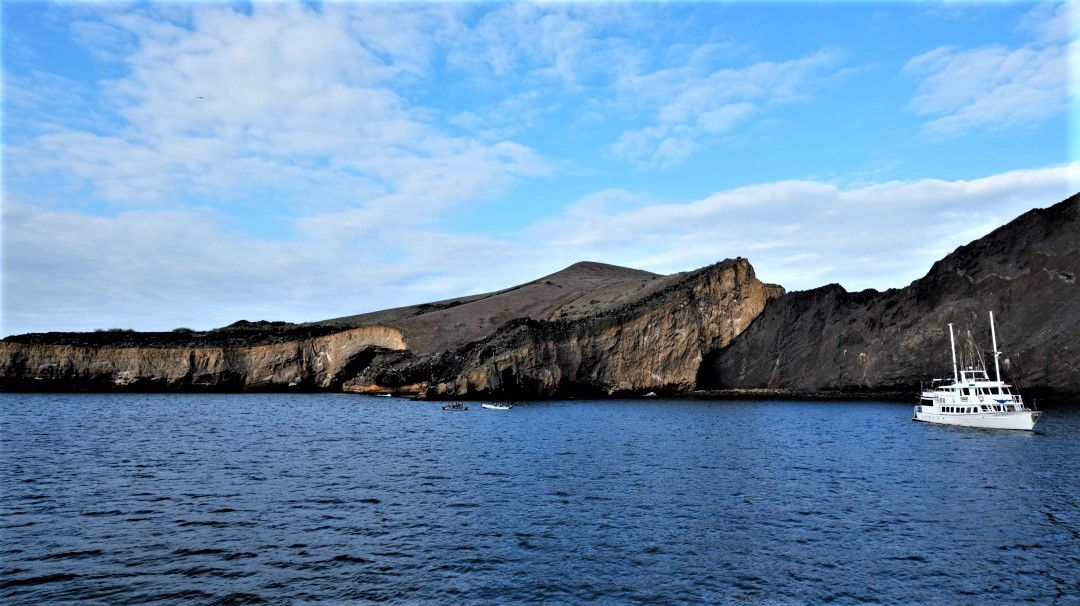
Is The Galapagos Expensive?
Visiting the Galapagos is eye-wateringly expensive. It’s the most money we’ve spent on any travel destination in such a short trip. In total, an eight-day Galapagos trip with a five-day cruise and two days of diving cost us $3,150 per person. Here’s the cost breakdown:
- Flight from Quito to Santa Cruz ($175)
- Galapagos entry fee ($100)
- Galapagos tourist card ($20)
- Galapagos five-day cruise, plus bank transfer fee ($2,215)
- Wetsuit and snorkelling hire for four days ($25)
- Food and drink ($76)
- Accommodation ($50)
- Ferry ticket from Santa Cruz to San Cristobal ($30)
- Diving for two days ($300)
- Flight from San Cristobal to Quito ($158)
Itinerary For Visiting The Galapagos Without a Cruise
It’s possible to visit the Galapagos without paying for a cruise. This will reduce the costs massively and, done right, you don’t have to miss out on some of the best diving or snorkelling sites, such as Kicker Rock. If you don’t book a cruise, try to book your snorkelling and diving in advance online, as spaces do fill up fast. If I were to visit the Galapagos without taking a cruise, here’s the itinerary I’d follow:
- Day 1: Fly to San Cristobal (Galapagos) from Guayaquil or Quito. If you arrive early, hire snorkelling equipment and snorkel at Tijeretas Muelle. It’s a 20-minute walk from Puerto Baquerizo Moreno.
- Day 2: Snorkelling day trip to Kicker Rock. Enjoy a sundowner at MUYU.
- Day 3: Take a ferry from San Cristobal to Isla Isabella, via Santa Cruz.
- Day 4: Snorkelling day trip from Isla Isabella to Los Tuneles.
- Day 5: Take a morning ferry from Isla Isabella to Santa Cruz. In the afternoon, visit the Charles Darwin Research Centre. Enjoy an iced coffee at 1835 Coffee Lab after the visit.
- Day 6: Snorkelling day trip from Santa Cruz to Bartolome, North Seymour or Santa Fe.
- Day 7: Fly from Santa Cruz to Quito or Guayaquil.
If you have time in the morning before your flight, hire snorkelling equipment and visit Las Grietas or Tortuga Bay, both of which are walk-able from town.
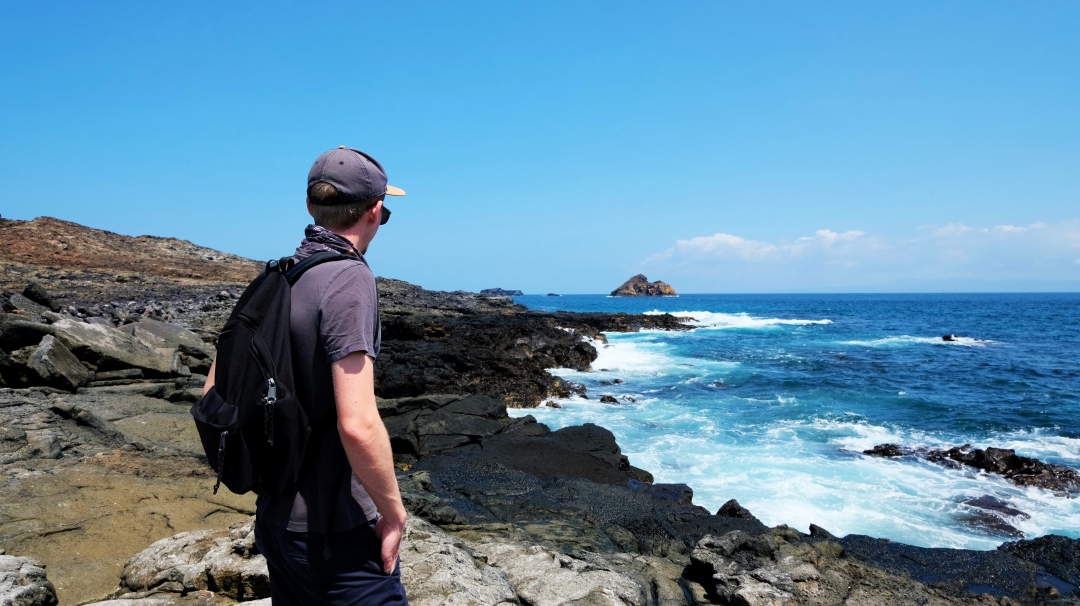
How Much Does It Cost To Visit The Galapagos Without a Cruise?
If you were to use the itinerary above, which would allow you to see Galapagos penguins, hammerhead sharks and many other iconic Galapagos animals, all without taking a cruise, then you could spend as little as $1,312 per person.
- Flight from Quito to San Cristobal ($158)
- Wetsuit and snorkelling hire for two days ($30)
- Food and drink ($165)
- Accommodation ($184)
- Ferry ticket from Santa Cruz to San Cristobal ($90)
- Snorkelling day trips, x3 ($390)
- Flight from Santa Cruz to Quito ($175)
You could reduce this cost a little by spending less on food and drink by making your own meals. For a budget restaurant in San Cristobal, I recommend Lucky’s . You can get a hearty vegetarian plate for $4.50. For a taste of luxury while on a budget, I recommend MUYU . MUYU is a hotel right on the seafront, complete with palm trees and sea lions lazing on the white sand. MUYU isn’t normally cheap, but you can get a delicious vegetarian wrap and a great cup of coffee for $7.50 from their breakfast menu.
Snorkelling, Diving and Animal Spotting in The Galapagos
Before you set off, I recommend that you read up on the best snorkelling and diving spots in the Galapagos. You can see different animals at different spots and different times of the year and that can help you plan your trip.
For example, Charlie wanted to swim with Galapagos penguins and I wanted to swim with Galapagos sharks! We worked out that to have the best chance of seeing both animals we’d have to visit at least two islands: Isla Isabela and San Cristobal.
Snorkelling and Things To Do on Santa Cruz, The Galapagos
Santa Cruz is home to the Galapagos’ largest town: Puerto Ayora (22,000 population). The largest airport of the Galapagos, Baltra Airport (also called Seymour Airport), is technically on a separate island, but it’s a short ferry over to Santa Cruz from the airport. While you’re on Santa Cruz, make sure you use the ATMs as cash isn’t always easily accessible on other islands.
Snorkelling on Isla Mosquera
Isla Mosquera is a white speck of sand not far from Santa Cruz. We visited Isla Mosquera as the first stop of our five-day cruise. There’s an adorable sea lion nursery and a colony of small marine iguanas. I also saw an enormous blacktip reef shark while taking a dingy to the shore. The water here was warm and clear.
We booked our five-day Galapagos island cruise on the Fragata directly from the owners of the boat, which seemed to be cheaper than going via a travel agency.
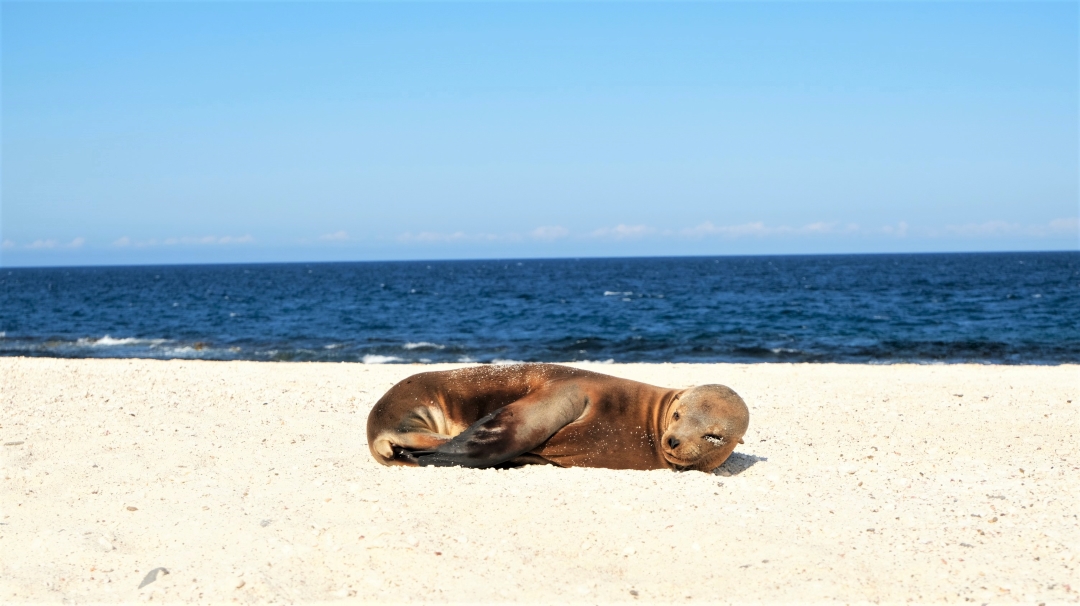
See Giant Tortoises at The Charles Darwin Research Centre
It’s a twenty-minute walk from Puerto Ayora to the Charles Darwin Research Centre. Scientists are working hard to breed giant tortoises and land iguanas here and restore their populations across the Galapagos. You need to enlist a guide to visit the centre and you can also see adorable baby giant tortoises.
Snorkelling and Things To Do On Isla Isabela and Fernandina, The Galapagos
Isla Isabela is the largest island in the Galapagos. It’s mostly uninhabited, though there is a small town (Puerto Villamil) on the southern tip of the island. Ferry services connect Isla Isabela with Santa Cruz and San Cristobal. Fernandina is a small island on the western side of Isabela. The channel between Isabela and Fernandina is a great place to see dolphins and whales.
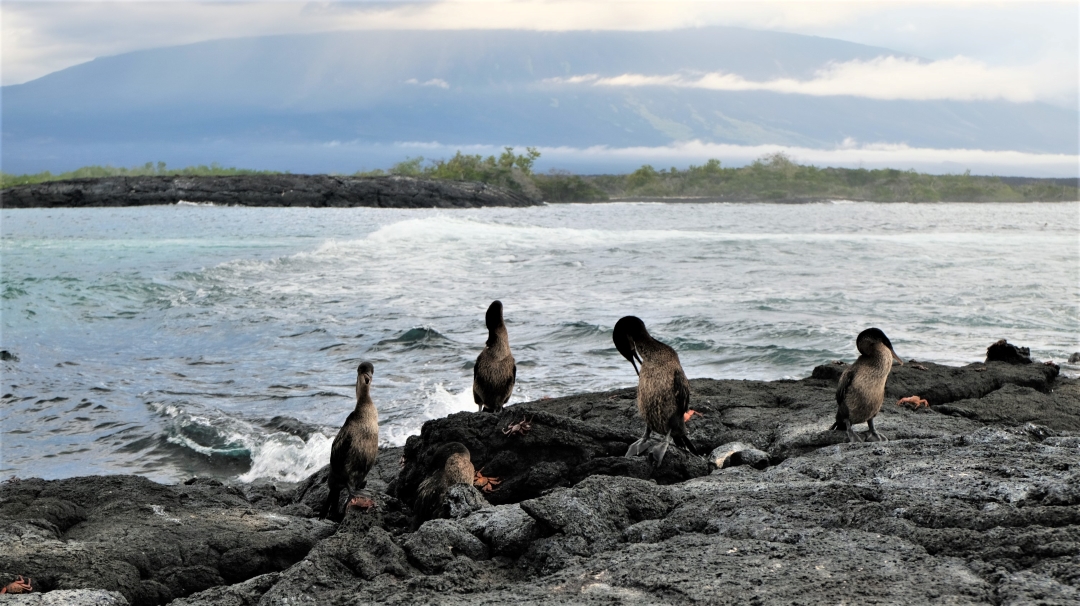
Snorkelling at Punta Vicente Roca, Isla Isabela
Top pick! Punta Vicente Roca was one of the best snorkelling sites we visited in the Galapagos. It’s located right at the top of Isabela. Even before I got off the boat I saw two giant manta rays — one leaping out of the water and landing back in with a belly flop! We also saw nesting blue-footed boobies, Galapagos penguins, flightless cormorants, a shoal of golden cow-nose rays and a heap of beautiful Pacific green turtles. We visited Punta Vicente Roca as part of our five-day Galapagos Island cruise. The water was clear and warm.
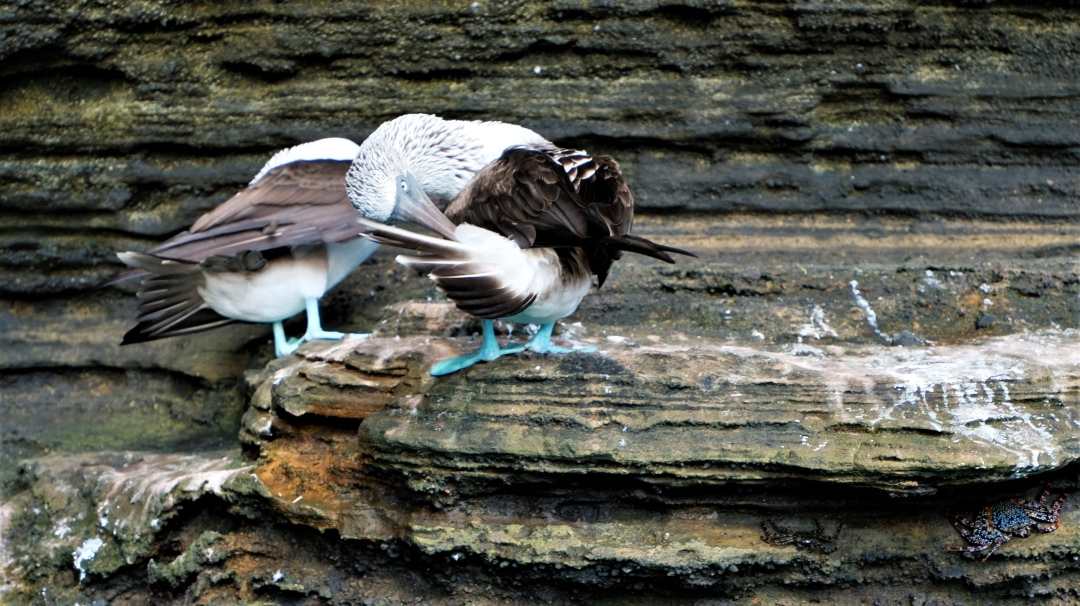

Snorkelling and Animal Spotting at Urbina Bay, Isla Isabela
Top pick! We were very fortunate when we came ashore at Urbina Bay! We saw loads of wild giant tortoises and land iguanas. Giant tortoises are amazing creatures and their sheer size (up to 450kg) is something to see. Urbina Bay in Isla Isabela is one of the best places to see Giant Tortoises in the wild. Thanks to the efforts of scientists at the Chares Darwin Research Centre, the population is recovering. We visited Urbina Bay as part of our five-day Galapagos Island cruise.
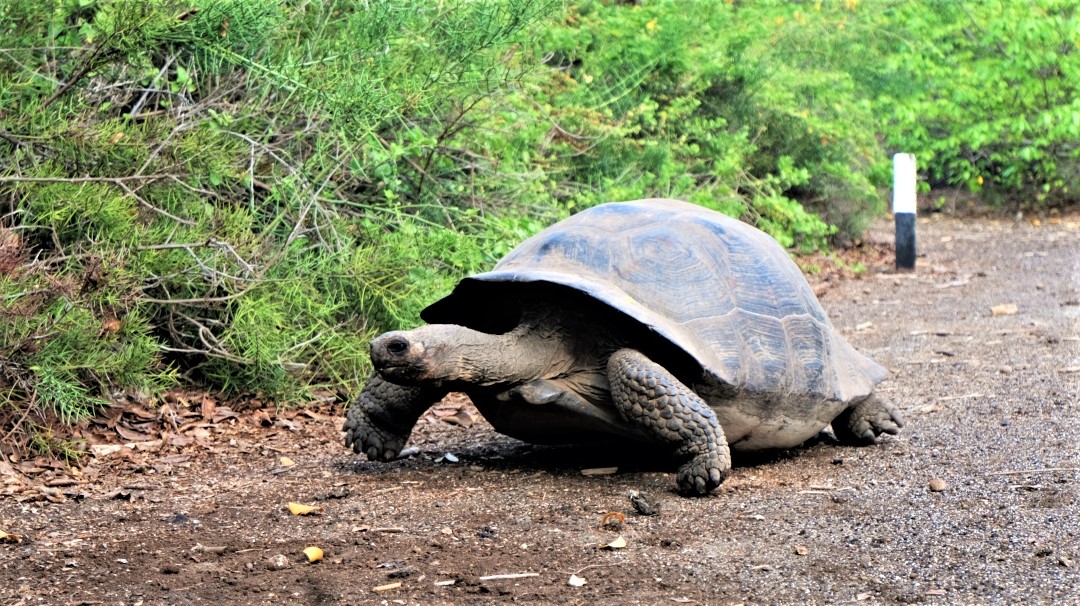
Snorkelling at Tagus Cove, Isla Isabela
Tagus Cove, on Isla Isabela, is one of the best places to swim with Galapagos penguins. The cove isn’t pretty, and passing ships have made things worse by adding graffiti which can still be seen to this day. But penguins, turtles and even small sharks love to cold and murky water here. Catching a glimpse of a penguin is difficult as they swim so fast, but we saw a number of them while snorkelling. Playful sealions also swam with us for a time, which was an unforgettable experience.
Snorkelling and Animal Spotting at Punta Espinosa, Isla Fernandina
Top pick! Punta Espinosa is hands down the best place to see marine iguanas, which amass in great heaps around the beaches. Strangely, marine iguanas spend a lot of time spitting. This is because they take in a lot of seawater while eating algae and they need to spit to remove saltwater from their system.
We also saw some Galapagos hawks here, which are the islands’ top “land” predator, as well as tonnes of sea lions and a few penguins. We visited Punta Espinosa as part of our five-day Galapagos Island cruise. We snorkelled here too, but we didn’t see much aside from a handful of turtles in the water. The water was cold and cloudy.
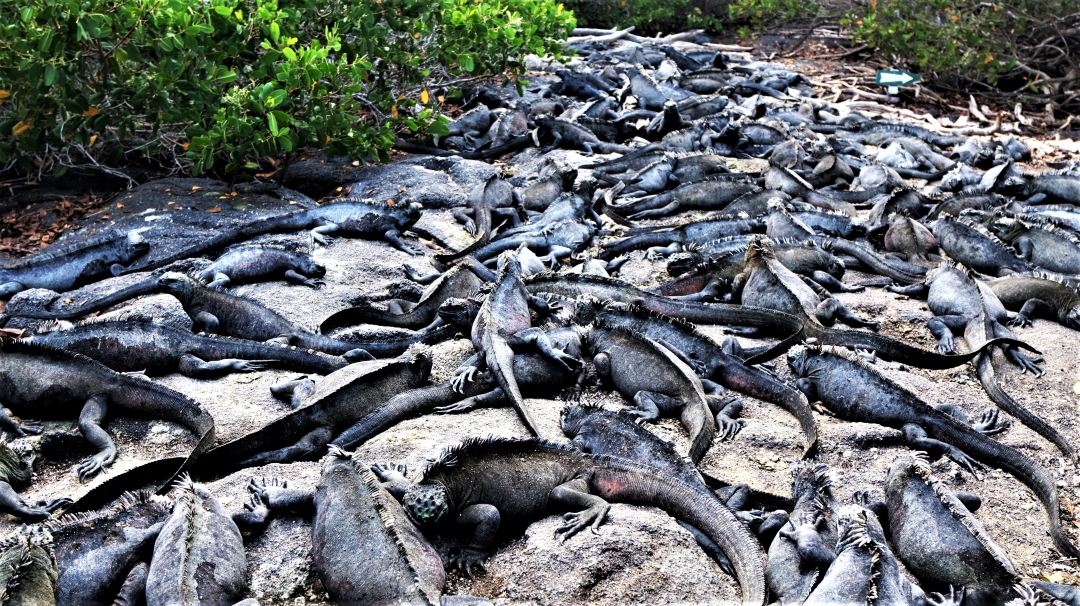
Snorkelling and Things To Do on Isla Santiago, The Galapagos
Isla Santiago is a largeish uninhabited island between Santa Cruz and Isla Isabela. Like the other islands of the Galapagos, it’s volcanic. That means the landscape is made up of black lava fields as well as sandy beaches of different colours. The vegetation is mostly cactuses and small shrubs rather than palm trees!
Snorkelling At Puerto Egas On Isla Santiago, The Galapagos
Puerto Egas is a great place to snorkel with small, white-tip reef sharks. We also saw a lava heron here as well as the fur sea lion. Unlike the Galapagos sea lion, which can be found everywhere, the fur sea lion is hard to spot in the wild. We visited Puerto Egas on our way back to Santa Cruz as part of our five-day cruise. This is a great snorkelling spot with warm waters and clear visibility.
Snorkelling at Sombrero Chino On Isla Santiago, The Galapagos
Top pick! Another great place to snorkel with small sharks in the Galapagos is Sombrero Chino. Might be a good option if you’d like to swim with sharks but feel a little nervous! This snorkelling spot felt very tropical with warm, crystal clear waters and an abundance of marine life, including rays and lobsters. We visited Sombrero Chino as part of our five-day cruise.
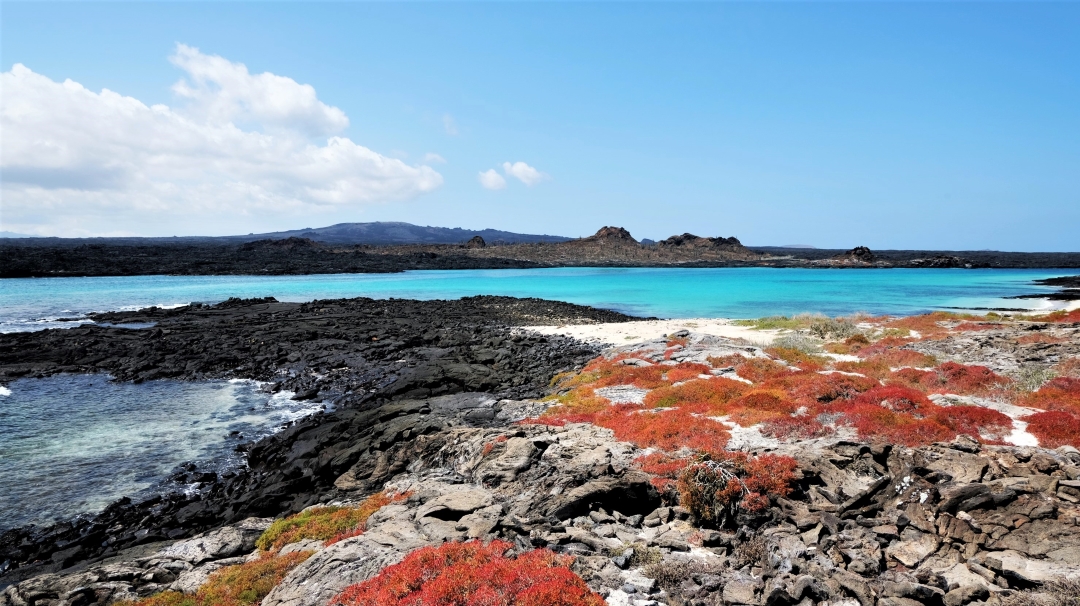
Snorkelling and Diving on San Cristobal, The Galapagos
San Cristobal is the easternmost inhabited island of the Galapagos. It has a small town, Puerto Baquerizo Moreno, where you can arrange day trips to the famous Kicker Rock, which is a 40-minute or so boat ride away. You can also withdraw money here, though we’ve heard the ATM can sometimes run out of cash. You can catch a ferry from here to Santa Cruz or Isla Isabela.
Diving At Caragua Wreck, San Cristobal
This shipwreck, over 90 years old, can be found in the bay of Puerto Baquerizo Moreno. We saw playful Sea Lions, Green Turtles, several rays and even an octopus. There’s a semi-enclosed tunnel that you can swim through. Parts of the ship are clearly visible. The water was cold but clear.
I booked my wreck dive for $140 from Alpha Scuba. This included two tanks of air and a refresher dive before the wreck dive. I booked in town, but I was quoted similar prices online and wish I’d booked in advance. I’ve also heard good things about Wreck Bay, which is another diving company.
Diving at Kicker Rock (Channel), San Cristobal
(Top pick!) The channel between Kicker Rock is an excellent place to dive with sharks, including hammerhead sharks. While diving the channel, a big hammerhead shark passed within a few metres of our group. We saw plenty of other sharks (black-tip, white-tip and Galapagos sharks) in the same dive. Other fish were beautiful and abundant. Note that Kicker Rock is known as Leon Dormido in Spanish.
Diving at Kicker Rock (Tail), San Cristobal
(Top pick!) When diving at the tail end of Kicker Rock, we passed through a shoal of fish so large that they blocked out the sun and it was like diving at night. We saw many hammerhead sharks and other large sharks as well as yellowfin tuna and barracuda at this dive site. Above the water, it’s possible to see Magnificent Frigatebirds nesting on the tail of Kicker Rock.
The water was warm enough and the visibility was good – but it can drop as low as 5 metres if you’re unlucky. If you feel the cold easily, ask for a 7 mm wetsuit. There’s a gentle surge in the channel and a strong current at the tail. Our divemaster did a safety check and assessed our skills before the dive at Puerto Grande.
The cost is $160 for two dives at Kicker Rock, with lunch included. We set off at 9 and we’re back in port by 14:45. Seasickness tablets are essential. You can pay $110 to snorkel at Kicker Rock. Snorkelers and divers share a boat. The snorkelers on our boat saw several sharks but no hammerheads. It’s possible to see hammerhead sharks while snorkelling at Kicker Rock.
Galapagos Islands Airports
All flights to the Galapagos connect via Guayaquil (GYE), which is a city on the coast of Ecuador. Even if you book a flight from Quito (UIO), you might find that you have a technical stopover at Guayaquil for around forty minutes.
There are three airports in the Galapagos:
- Seymour Airport (GPS) on Baltra Island (closest to Santa Cruz).
- San Cristobal Airport (SCY) on San Cristobal Island.
- Emetebe on Isabela Island.
Confusingly, Seymour Airport is sometimes known as Baltra airport and sometimes known as Santa Cruz airport. Emetebe is little more than a landing strip. You can only fly from Guayaquil to Seymour Airport or San Cristobal Airport.
You’ll have to buy a tourist card ($20) when boarding your plane at Quito or Guayaquil. When you arrive in the Galapagos, you’ll have to buy a Galapagos entry ticket ($100).
The Galapagos is very strict about protecting the national park from introduced animals and vegetables. It’s best to play it safe and not bring any fresh food or plants of any kind into the island. You’re also not supposed to bring camping equipment, including hiking boots, into the island.
If you do fly to the Galapagos, do consider paying to carbon offset your flights. Frequent air travel is very carbon-intensive. You can read our guide to offsetting your carbon emissions to help you calculate the cost.
Galapagos Packing List
This travel packing checklist includes everything you need to pack. Don’t forget your passport and important documents too! I haven’t included it as an essential, but consider bringing your own snorkelling mask. It’ll save you a few pennies on renting one and should be much more comfortable.
Luke Nicholson

Carvoeiro: A Guide to the Algarve Beach Town
The best islands to visit in croatia.

I am starting to plan a trip to Galapagos for Dec 2020 with my wife. Hopefully Covid doesn’t ruin it. Was wondering if you could recommend any good travel planning apps? I found one called PlanMoreTrips but any others you know of would also be super helpful because I am struggling to plan all the logistics for this trip. Thanks for your guide. It is super useful!
Leave a reply Cancel reply
About charlie & luke.

We’re Charlie and Luke — UK travel bloggers, adventurers and storytellers. We travel slow and write about sustainable travel . We want to make responsible travel choices and help you do the same. Get to know us .
Subscribe To Our Newsletters
Hand curated travel guides and sustainable travel inspiration straight to your inbox.

- Work With Us
- Blogging Bootcamp

- Van Conversion Academy
- Campervan Shop
- Campervan Rentals
- Plan a Trip
- Itineraries
- Destinations
- Responsible Travel
- Family Travel
- Budget Travel
- Scuba Diving
- Travel Credit Cards
- Digital Nomad
- Teach English Abroad
- Blogging Resources
- Income Reports
- Travel Shop
- Meet Katie & Ben
- About Two Wandering Soles
- Personal Stuff
- Portfolio & Press
How to Travel the Galápagos Islands on a Budget
Home » Blog » Budget Travel » Backpacking Destinations » How to Travel the Galápagos Islands on a Budget
Everyone wants to know: “Is it expensive to travel to the Galapagos?” YES. No question about it. But lucky for you, we’re going to share our best tips for traveling there on a budget because we believe it’s a place that not only the rich should experience.

Soaking up sunshine and frolicking with sea lions in the Galápagos Islands seems like a far-off dream, doesn’t it? But it doesn’t have to be.
But I bet now you’re wondering: “Isn’t it expensive to travel to the Galápagos?”
YES. No question about it.
But lucky for you, we’re going to share our best tips for traveling there on a budget because we believe it’s a place that not only the rich should experience.
We’ll even share exactly how much we spent, so you have an idea of what you’re in for.
Though not as budget-friendly as many other South American destinations, visiting this stunning archipelago is definitely doable even if you’re not a millionaire.
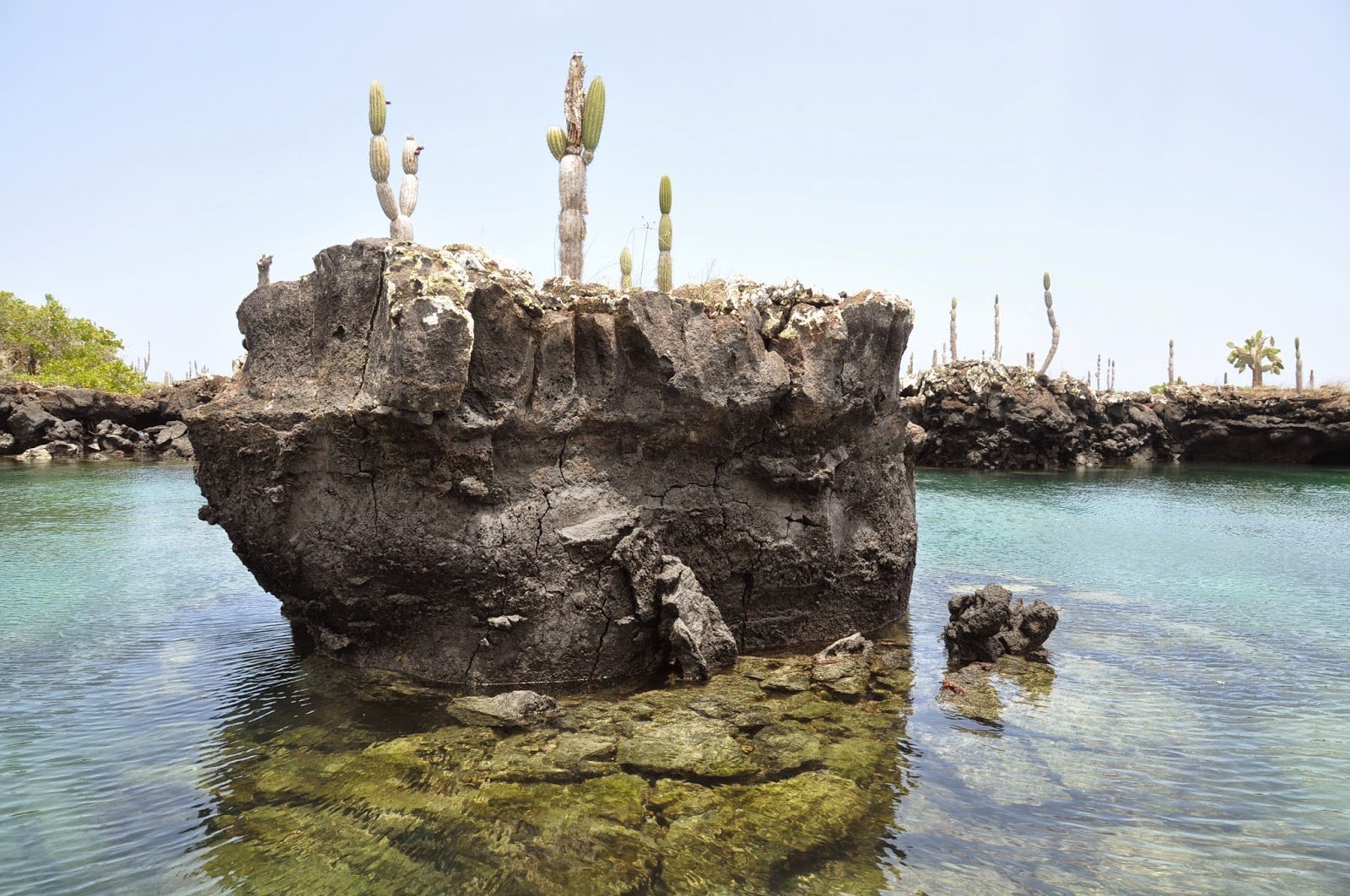
While backpacking in South America, we had no intention of visiting the Galápagos. From everything I had read, I knew it was hella expensive, and that was enough to keep us away. We had a pretty tight budget to stick to, after all. But after countless travelers we met along the way recounted stories of this magical place, we finally convinced ourselves that since we were already in Ecuador , going to the Galápagos would never be cheaper.
We thought of it this way: Sure, in 10 years we will (hopefully) have more dough in our savings account, but it’s highly likely that the ecological wonder will no longer be the same. The ecosystem on the islands is already being damaged in large part due to tourism .
Side note: When you do visit the Galápagos, please travel consciously . Don’t litter (go the extra mile and pick up a few pieces of trash while you’re there!), choose companies that treat the environment with respect, and don’t harm the animals!
Once we realized that there’s no better time to visit the Galápagos than the present, we bit the bullet and bought a last minute flight. We were fully aware that this excursion would break the budget we’d set for our 3-month trip , but we were determined to do our best of keeping our costs as low as possible. And we did a pretty good job of it!
So are you thinking of packing your bags?
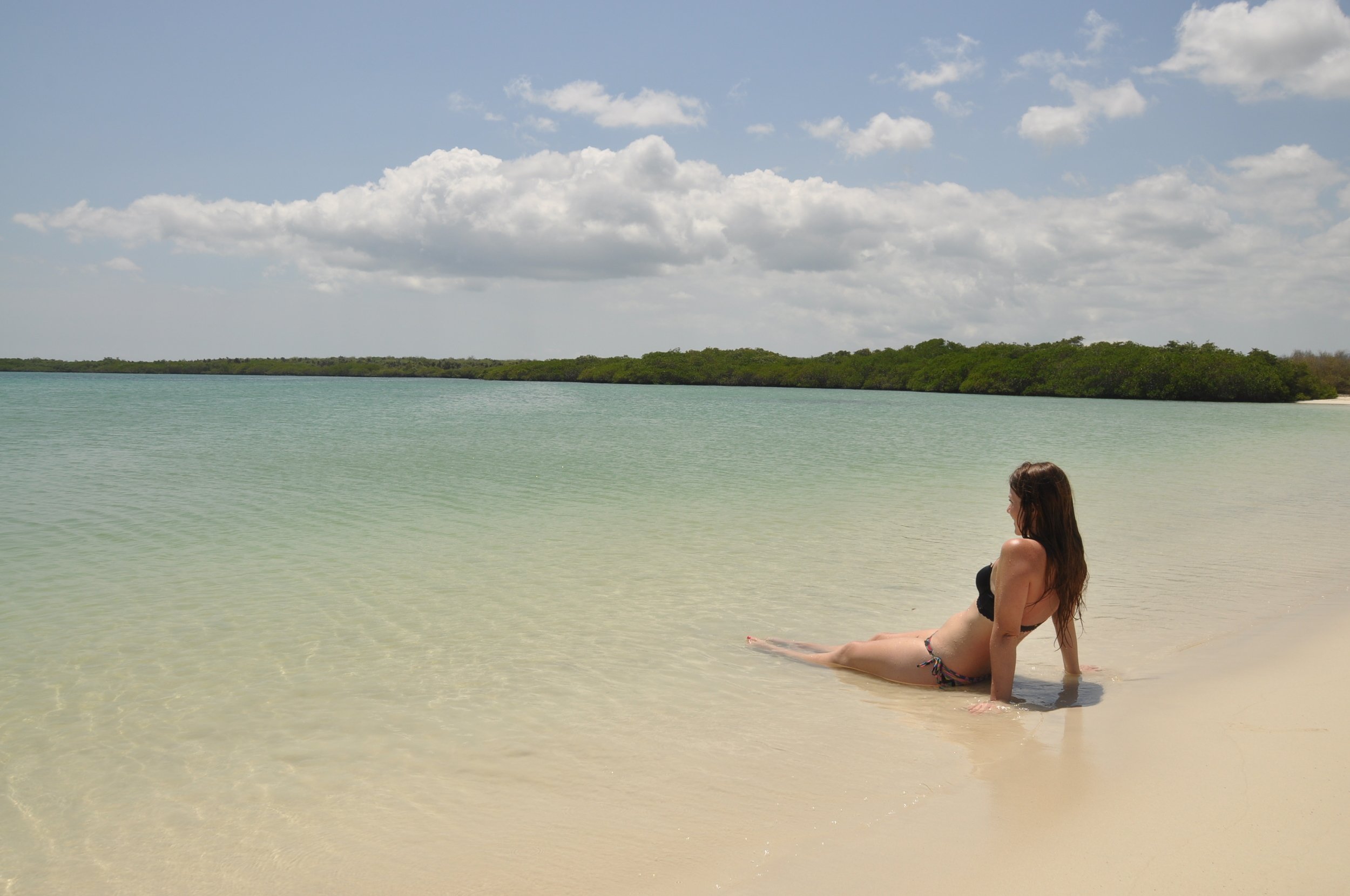
Great! I promise this is a trip of a lifetime that you won’t regret. There are so many things to do on the Galápagos Islands , and you will be talking about this experience for years to come.
And we’re here to help you plan! We learned a lot along the way and are excited to share all we know about traveling to the Galápagos on a budget so you’ll be able to maximize each dollar!
And this includes having the right travel gear. Our friends at Practical Wanderlust have a great Galapagos Islands packing list to get you ready for any adventure on the islands.
Okay, let’s get started…

Come with a plan
I’m about to divulge all of our best tips for traveling the Galápagos on a budget, but first I’m going to get the bad news out of the way… Even if you follow these tips exactly, you will still spend a good chunk of money while visiting these islands. Yes, these tips will save you money (hopefully lots of it!), but it is still a very expensive place to travel. There’s no way around it.
What you can do, though, is come with a solid budget plan. This way, you’ll be prepared and will find it much more enjoyable than if you come with unrealistic expectations.
So let’s talk numbers:
First things first: you’ll need to book a flight . There are only a few airlines that fly to the Galápagos, and prices typically hover between $350 – $450 (round trip from mainland Ecuador) depending on how far in advance you book.
Tip # 1: The cheapest city to fly from is usually Guayaquil. And yes, this means you need to first account for the cost of getting to Ecuador.
Tip #2: If you can be flexible with your time, use Skyscanner’s “whole month” function to find the cheapest dates to fly. (When selecting departure and return dates, click on “whole month” instead of a specific date.)
Once you have accounted for the cost of the flight, add $110 per person. This is a conservation fee that each visitor must pay before stepping foot out of the airport. No bargaining here!
Now, add to this the cost of getting from island to island via ferry – $30 each way, which adds up fast. So if you’re like us and want to see the 3 main islands, you’re looking at $120 per person just in ferry costs.
I know you’re not going to want to hear this, but the cost of accommodation, food, and entertainment in the Galápagos is much more comparable to the United States than it is to the rest of Ecuador. Be prepared to spend at least 3 times what you would in the rest of the country.
If you already know that’s going to break your budget, consider a cheaper alternative: visiting Isla de la Plata (also known as the “poor man’s Galapagos”).
1. Rethink the cruise
The absolute cheapest way to explore the Galápagos is by basing yourself on land. You can take day trips to the ocean and hop from island to island. If you are on a tight budget, this is definitely the way to go!
Another way of seeing the islands is on a cruise. Though I don’t have personal experience with seeing the islands this way, we met both travelers who had great experiences and terrible ones. If cruising seems more your style, there are a few things you’ll want to consider.
Sure there are “budget cruises” advertised, but remember, you get what you pay for. Why come to one of the most spectacular places in the world, only to have your experience tainted by staying in a stuffy boat with subpar staff and sketchy food. There are some great medium-priced companies out there and there are some pros to traveling this way, but make for sure you’re going with a quality, ethical company before you make a reservation.
Be sure to look at reviews and rankings for any cruise you take. We’ve done a little research for you and we really like Liveaboard.com . They have quality boats from all over the world in their network and can hook you up with the best trip in the Galapagos. They specialize in scuba diving trips so if you want to see this magical place underwater, look no further.
Remember that you can see everything you would on a boat, by basing yourself on the islands and taking day trips to sea. This way, even if you wind up staying in a bad hotel, you only need to sleep there. If you are on a cruise, you’re stuck.
2. Book accommodation in advance
We found that there were many luxury and mid-range options for accommodation, but inexpensive hotels were seriously lacking.
If you’re looking only for budget rooms, you will have a limited number of places you can stay. I will tell you, some of these budget places are absolutely disgusting. Think rude owners, rooms with stained sheets and rotting ceilings… oh, and waking up in the middle of the night with a cockroach scurrying across your face is not enjoyable either.
We stayed in two such places when we first arrived on the islands because we hadn’t done our research.
The good news for you is that you can avoid the duds. The bad news is that decent, inexpensive hotels book up quickly. Plus, the Internet in the Galápagos is terribly slow, so doing your research ahead of time really is a must.
Below is one hostel we recommend from personal experience:
Galapagos Best Homestay (Santa Cruz Island)
An all-around great place to stay, each room has a kitchenette and an unlimited supply of purified drinking water. This place is it is a bit out of the way – about a twenty-minute walk to the town center. Taxis on the island are cheap though, and it will only cost you $1 to get downtown if you really don’t want to walk.
Here’s how we find other affordable accommodation on the Galapagos Islands .
3. Time your trip right
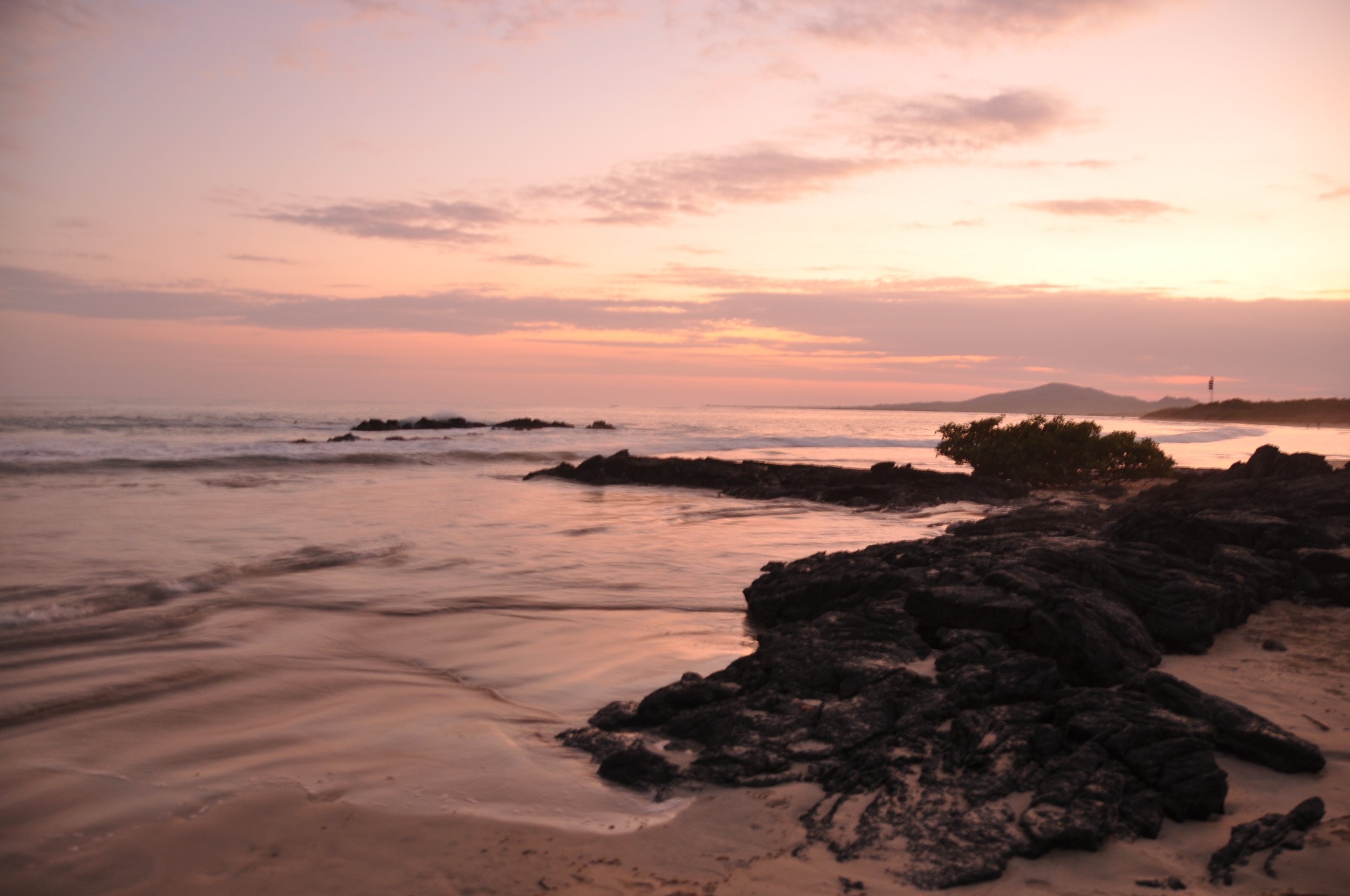
You may not always have control over the time of year you visit, but obviously peak season (June – September, and December – January) will cost more than off-season.
In addition to the time of year, consider how many days you will spend in the Galápagos. Visiting for a short amount of time does not always mean you will save money. Generally speaking, the longer you stay, the less you will actually spend per day.
It goes without being said that a month in the Galápagos will cost you a small fortune. You’ve got to find that sweet spot where you have enough days to travel slowly, but not so many that you spend unnecessary money.
We spent one week in the Galápagos, which was enough to see the three main islands. We did have to rush around a bit in our last couple of days though, costing us more money than we would have spent otherwise. In my opinion, 10 days would be ideal.
4. You need to search, but there is cheap food
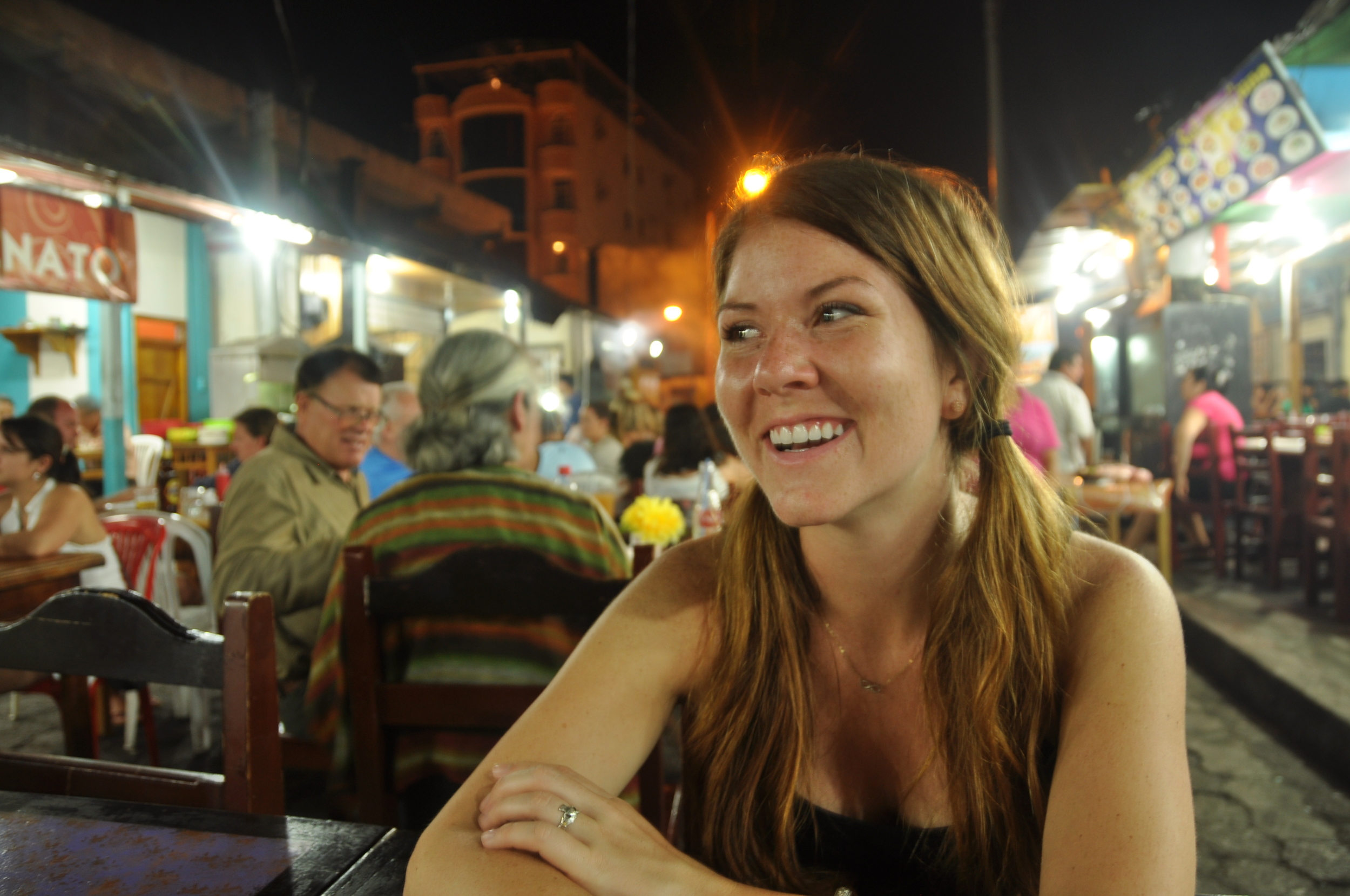
While most tourists flock to the Italian pizzerias and Western joints, follow the locals for some cheap, Ecuadorian cuisine.
On Santa Cruz Island: At night, look no further than Binford Street for great people watching and even better food. The seafood looks delicious and is no doubt very fresh, but it is still expensive. Instead, sit at one of the many open-air restaurants and order the Cazuela de Camarones – a traditional “stew” of plantains, spices and shrimp. This $12 dish was delicious and more than enough for two of us to share.
On Isabela Island: Head outside the main drag to Restaurante el Tropical where the locals gather.
5. Buy (most of) your drinks at the supermarket
As with most of our travels, we bought our drinks at a market to avoid paying top dollar at bars.
There are countless restaurants that advertise “happy hours” that last nearly all day. Despite being discounted, the drinks are still not cheap. Too rich for our backpacking blood!
So grab a box of wine or a bottle of rum, head to the beach, and enjoy the sunset with class!
6. Choose your tours wisely
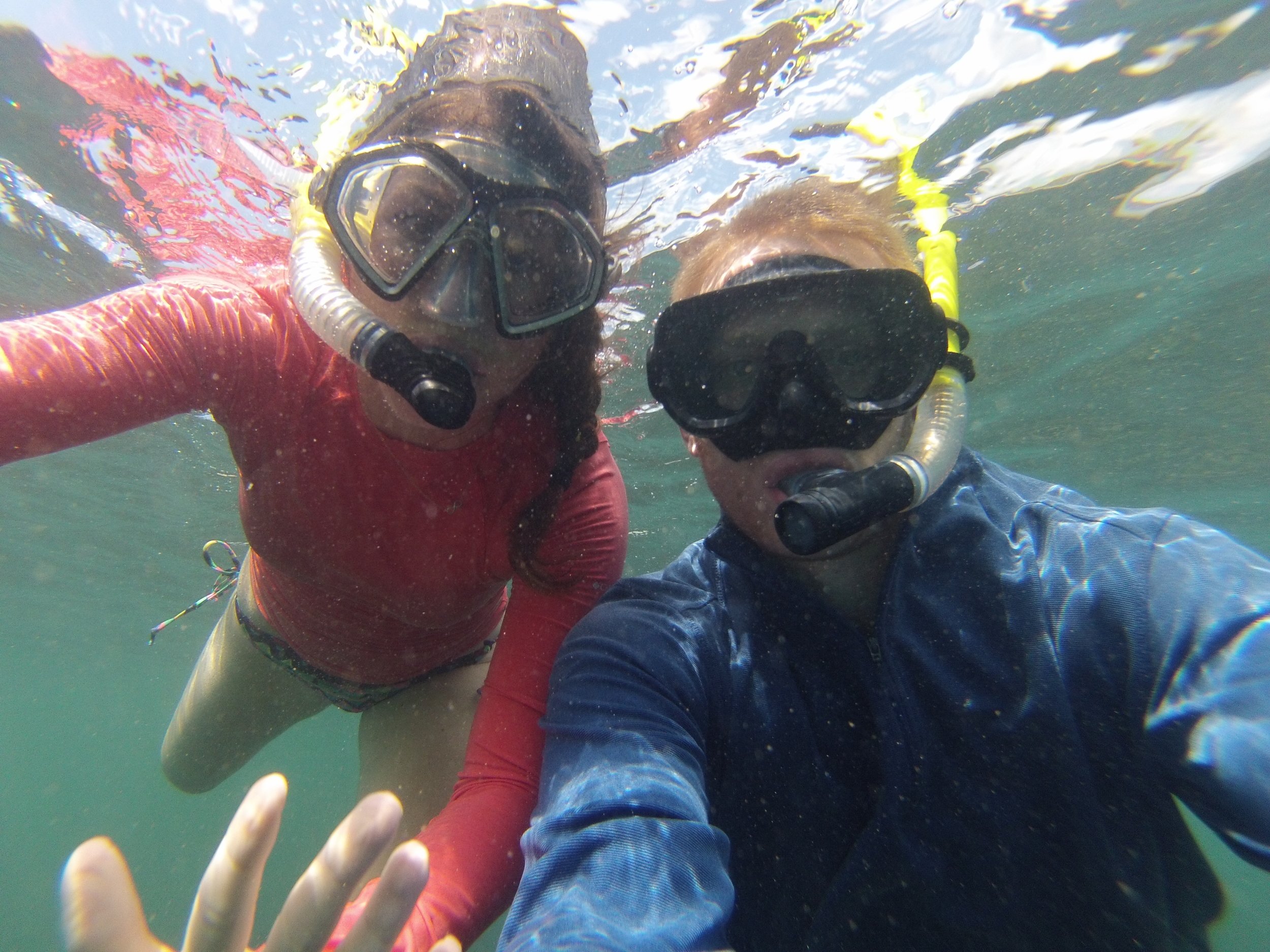
You could easily spend a month on the islands, taking a new excursion every day. But eventually they will start to blend together… and take a toll on your budget because they ain’t cheap!
Do your research and pick a few tours that interest you and stick with those. Hiking, SCUBA diving, snorkeling, sunset cruise, sailing… pick your poison. Expect to splurge, but go in knowing that you can’t do it all if you’re trying to stay on budget.
Our top tour pick: If you are on Isabela Island, the Los Túneles tour is a must! At $95 per person, it is a splurge, yes, but totally worth it.
Tip: Ask the tour agency if they will give you a discount for booking multiple tours with them. Sometimes it pays off to be loyal to one company instead of booking each excursion through a different operator.
7. Bring cold, hard cash to Isabela Island
Although the Galápagos thrives on tourism, it is less developed as a whole than we were expecting. This was a pleasant surprise after having traveled to many places that have lost their luster due to a surplus of visitors.
The island of Isabela, with its sandy streets and lack of infrastructure, is seriously charming. It was my favorite place in the Galápagos, but there was one tiny – well, actually huge – problem.
There is not a single ATM on the island. And apart from one crazy expensive restaurant, no place on the island accepts credit cards.
So there we were, stuck on the island without any money. So there I am thinking, The only way I’m going to be able to eat is to shell out $25 per meal at this Western restaurant that also charges a 7% credit card fee. Holy sh*t… there goes all of my money!
And then there was the issue of getting off the island. Turns out we didn’t even have enough cash on us for us for a ferry ticket back.
If it weren’t for the generosity of the manager at our hostel (and the wonders of PayPal), I don’t know how we would have gotten off the island. One of us may have had to stay. Which wouldn’t have been too bad, after all…
Don’t get yourself in this situation. Learn from our mistake and bring plenty of US dollas to Islabela!
8. Take advantage of free activities
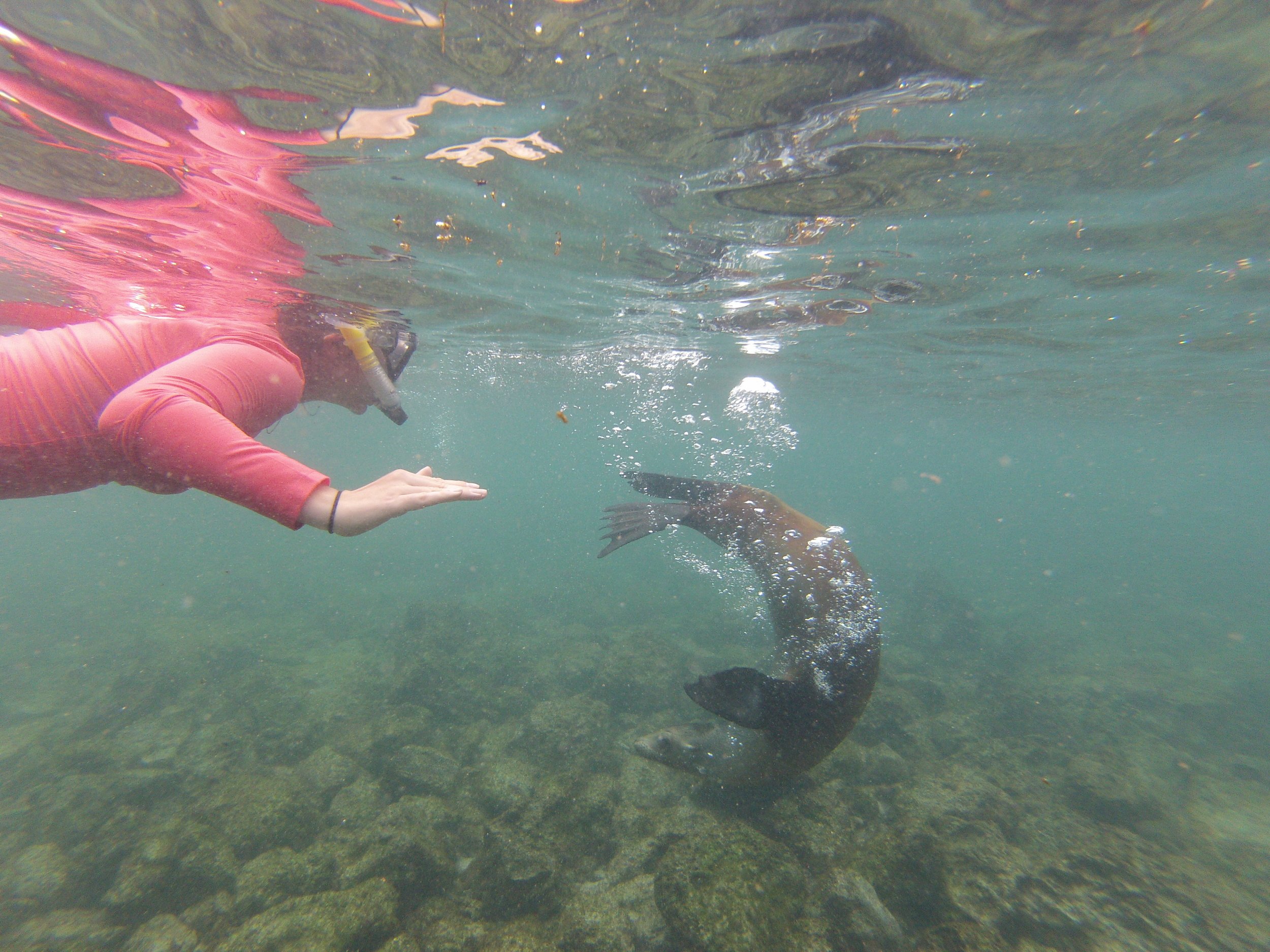
On Santa Cruz Island:
Las Grietas: More popular with locals than tourists, Las Grietas is a unique place to spend an afternoon. Observe teenagers jumping off the jagged cliffs into the crevice filled with crystal water below. Better yet, join in the fun and take the plunge yourself!
Tortuga Bay: It’s a bit of a walk to reach this secluded beach, but you’ll be glad you made the trip. Head out in the morning to avoid the scorching afternoon sun. If you’re lucky, you might even see baby sea turtles scurrying away from their nest and out to sea!
Fish Market: Watch as fishermen bring in their fresh catch to be fried up for a long line of hungry customers. A crowd of pelicans will likely be waiting for scraps to be thrown in their direction, making for a great photo opportunity. The nearby dock is usually crowded with local children pushing each other into the water, which is a sight in itself!
On Isabela Island:
Concha de Perla: This wooden boardwalk is home to many lazy sea lions getting their tan on! Be careful not to step on any of them as you make your way to the end of the boardwalk, where you will find a shallow bay. Put on a snorkel and fins, and swim with schools of fish, sea turtles, and manta rays.
Enjoy a sunset: Yes, the token “free sunset” tip. But seriously, the sunsets on Isabela are spectacular. They are made even better with some boxed wine. I’m classy, I know.
On San Cristobal Island:
Swimming with sea lions: Totally free! Just bring a snorkel and mask so you can see these friendly creatures up close. (Many hotels or tour agencies rent them out for $5.)
How much did we spend?
To give you an idea of what to expect, we spent $1,000 each for one week. This includes our flights, ferries, tours, accommodation, food and drinks. We did it just about the cheapest way possible, so expect to spend at least this much per person per week!
You might also like…
Galapagos Islands Ecuador
One Action-Packed Week in Baños
Border Crossing: Colombia to Ecuador
7 Best Hostels in South America
Planning a trip to Galapagos? Save this article for later!
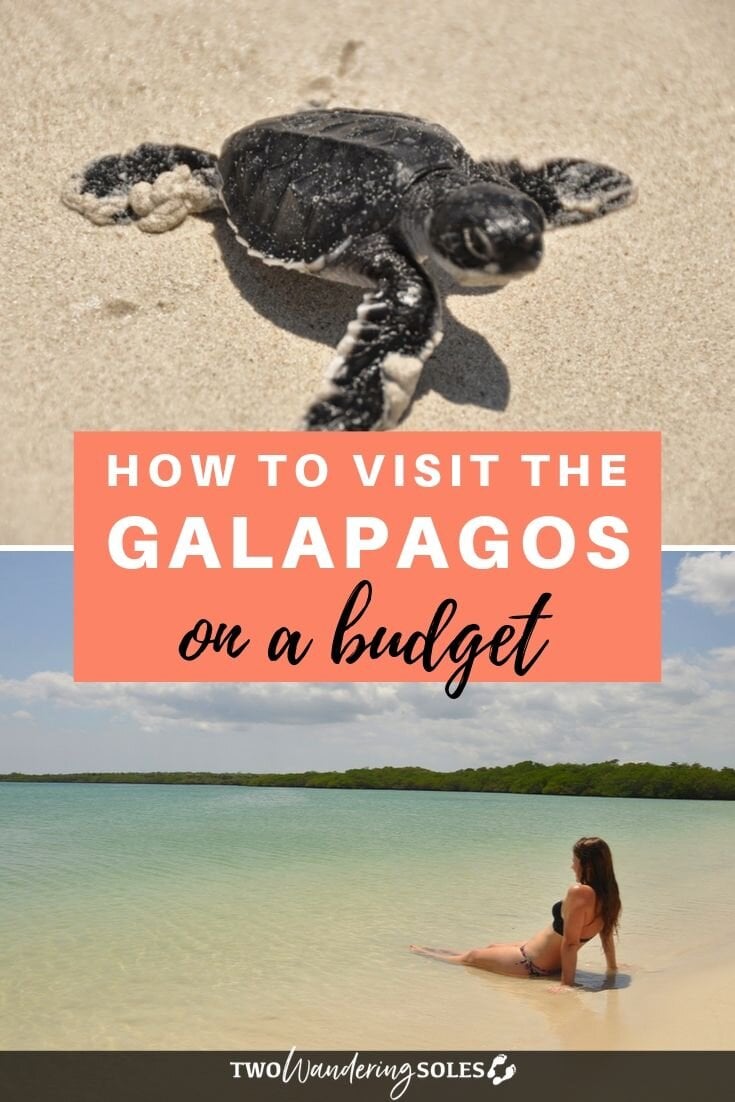
We want to hear from you!
Have you traveled to the Galapagos? Did you find it hard to stick to a budget? What are your best money saving tips? Comment below!
Comments (39) on “ How to Travel the Galápagos Islands on a Budget ”
great article….
great article.. thanks for the information…
Thank you so much for your insight! I have always wanted to go to the Galapagos, but didn’t think we could ever afford it. You have given me great hope!
What a great blog, thank you for the tips. Do you have any recommended hotels/hostels in Santa Cruz and San Cristobal? Thanks!
Hi Jade, we recommend Galapagos Best Homestay for Santa Cruz (link in the article). It’s a nice hostel/guesthouse but it’s a bit far and you’ll need to take a taxi there or a 20-30 minute walk from the city center. Unfortunately, we did not stay on San Cristobal Island, so I can’t personally recommend anything. Hope this helps!
I am traveling with my 15 year old son. We are vegetarian and looking forward to going in July or August. Any advice or great places to sleep, eat, and see. We hope to be on the islands for 8-10 days and would love to know if you can recommend days and which islands would be best. We love snorkeling, wildlife and sunsets. 🙂 We are planning to stay in Quito for a few days prior so also looking for central affordable places to stay before flying to Galápagos. Look forward to your advice!
Hi Bina. What a great trip you have planned with you son. As you can see from this article, we recommend Santa Cruz Island because there are many things to do there. We also recommend Isla Isabella, because it has an untouched feel in certain places. We also like the Los Tuneles Tour because you get to snorkel around underwater arches that were formed by lava. Please check out our details in this article and our other Galapagos articles to see what places we recommend on each island.
We also have a Quito article where we show you what we did in the city and where to stay. Feel free to check it out.
I was curious if you stayed on one island the whole time and did day trips from there, or did you stay in a few different places? If you were to do the trip again (as a first timer), would you stay in the spots? Not meaning the same hostels or hotels, but the same towns?
Hey Laura. We stayed in two hotels on Isla Santa Cruz and two hotels on Isla Isabela. Day trips can become very long days if you base yourself on Santa Cruz. I would recommend, if you have time, to choose an island in addition to Santa Cruz, and stay there for a few nights. That way you are able to explore around that island easier.
I am planning 2 weeks trip to ecuador in July with a 12 yr old. Thinking of going to Quito, Guayaqil, and the Galapagos islands. How shall I divide the days of our trip? How many on the islands? We want to connect local people, expand on our Spanish speaking, food, soccer etc.
I am going to Galapagos in February so this was useful. Thanks!
Wonderful read, so glad I came across your blog. Wondering how one travels within the island? taxi cabs? tuck-tucks?
Hey Angela! There are tuk tuks throughout the entire island and they are easy to flag down. They typically cost about $1 per ride anywhere within the city. Happy planning!
Thank you very much for this review and we have found it most helpful. We are planning a trop to the Galapagos within the year 2018. thank you. the Lacy’s
Hey Stephanie. You’re welcome! Happy planning!
Just want to say, what a great guide!! I am planning on doing a month in every country in south america starting in March, never been travelling before and I am from Northern Ireland so I am going to stick out like a MASSIVE sore thumb, think it might have something to do with the ginger hair and freckly skin, I will be using this guide religiously!! it just seems like one of them places whilst expensive….I JUST CANT MISS IT!! thats the problem I’m having at the moment when trying to plan my trip is seeing everything at the right time, because i want to do EVERYTHING in south america from iguazu falls to seeing Patagonia to taking samba lessons in brazil haha so this sort of guide is tremendously helpful!! 🙂
Thank you!!
I’m glad you found our guide helpful. It is super tempting to do everything when traveling in South America, but remember it is a HUGE continent. So if you don’t do everything that is okay. It sounds like you have an incredible trip planned and I wish you the best of luck. Take in every moment.
Hi Katie i was just wondering if you went on your travels I am planning to go to Columbia and Ecuador in November 2018 I am also from Northern Ireland so would be grateful of your advice
Hey Mary, we first traveled to Colombia and Ecuador in February and March, and we have been back to Colombia in Dec and July and have had great weather. For more information check out our Colombia and Ecuador pages in our Destinations Page.
Sorry meant to say Lee
Hi Lee I assume you completed your trip – i am from NI too and heading off next month for a month – did you have an itinerary or any tips
Hey Mary! Sounds like you have some fun travel plans coming up. Most of our tips are in this blog article so feel free to have a look. We would recommend to have a few days on at least two different islands. We spent about a week in total and spent 4 days in Santa Cruz and 3 days in Isla Isabella. We also took a day trip to San Cristobal. Hopefully this gives you a start. Let us know if you have any more questions!
Whilst it’s great to save money by staying on land and "rethinking the cruise", just be aware that by doing this you are limiting where you can go and what you can see.
Some of the more out of the way islands (Genovesa and Espanola to be specific) which are also some of the most amazing islands can only be reached on a small ship cruise (large cruise ships are too big to reach them and it’s illegal/not possible for day trips from the main islands to go here).
One company that is really big on environmental sustainability AND giving back to local communities of the countries it goes to (pretty much any country you’d want to visit) is INTREPID! They have a great range of Galapagos tours, most of which are on board the Daphne which is a really good, small ship (8 rooms total).
this is such an awesome blog, i am planning our trip and this is very helpful
Thanks Jane for the kind words! Happy planning!
Thanks for these great tips! There are so many options that it is important to investigate a lot before choosing the best option for you! if you decide to book a cruise, ask if you will have different activities to choose, so that you won’t have to stick with the same group all the time, and be able to choose depending on your interestes.
Thanks so much for writing this great blog! I am planning a trip to the Galapagos and was wondering which day tours you used for your activities? It seems to me like most of the tours are several days long. Thanks in advance!
Hey Victoria, we actually only did day tours while we were in the Galapagos. We asked out hotels/hostels for recommendations, and shopped around a bit. There’s no need to book in advance unless you’re really limited on time. We usually just booked each tour the day before and didn’t have a problem. Hope this helps!
Thanks for the great info! You didn’t mention which tour company you used for your snorkel tour, I would love to know! Thanks!
Hey Catlin, good question… We actually can’t remember the name of the company. Our hostel recommended them and booked it for us. And we can’t for the life of us find the name. Sorry! But it didn’t seem like you needed to book far in advance. We just arranged the tour for the next day, so I’m sure you could do the same and get recommendations from the hotel you’re staying at. Sorry we couldn’t be more help! Best of luck!
I hope this post will inspire more people to explore Galapagos on their own. I just was there for three month and I know from the locals how much they hate the cruises. Most of the money will go the the cruises operators based in Quito. But the Galapagos are so safe and easy to travel. Never really cheap but also not that horrendously expensive as the agencies are trying to sell it to you.
People listen to this and explore the Galapagos independently!
Thanks Céline for your thoughtful comment. We are big advocates for traveling independently because not only do you get to support local people financially (instead of large tour operators), but you also get a much more authentic experience. It’s fun connecting with like-minded people like you 🙂 I’m so glad you had a great experience in the Galapagos!
Thanks for all these tips and for a well designed, easy to read site. We are heading to the Galapagos on Friday so will take your tips in my back pocket. 😉 I am also reading your Philippines section as we will be there in Dec / Jan. Nice work! Keep it up.
Hey Astrid, thanks so much for the kind words. Have an amazing time in the Galapgos – threes no other place quite like it! Let us know how your trip goes. And how exciting to be going to the Philippines too! It’s one of our favorites 🙂
I booked my accommodation by AirBnB and it was great! Half the price and excellent local free advice. Highly recommend to do the same, check for reviews and prices
Yeah, we love AirBnB too, Flor! And if you sign up through our site, you’ll get $25 free toward your first stay! Such a fun way to see a "local" side of a new place!
Any specific AirBnB recommendations?
I will strongly recommend your readers to really pay attention while selecting your day tour operator. They lack safety control from any entity and it shows. Be careful!
Hi Manuel, Thank you for taking the time to comment. I think it’s good to shop around and read reviews online to help you choose tour companies, and by doing this we were very pleased in our choice in tour companies.
The company we went with for the Los Tuneles tour on Isabela Island was 100% safe, reliable and had great service. They have top ratings on TripAdvisor, and we were very pleased in our experience.
Leave a Reply Cancel reply
Your email address will not be published. Required fields are marked *
Save my name, email, and website in this browser for the next time I comment.

🐢 ON CHOKOHOST YOU’LL FIND ACCOMMODATION THAT I RECOMMEND IN THE GALAPAGOS AND SAVE UP TO USD 40 ON YOUR FIRST RESERVATION USING THIS DISCOUNT CODE: "CHOKOTRIP"

Where do you want to travel ?
Galapagos travel guide: cruise, tours, last minute deals.
- Galapagos Islands
- Travel Guide
Galapagos Islands | Travel Blog By ChokoTrip

Christian Echeverria
The Galapagos Islands; As an Ecuadorian blogger, I wrote this guide to traveling cheap (Low cost) with first-hand and updated information to explore it on your own, know what tours you can take on each Island and create a budget according to what you want to know.
Every year, I travel to the Galapagos Islands (Ecuador) and everything you are going to read in the ChokoTrip and ChokoTours blog, is own and updated content. Above all, it is very objective so that your experience touring the islands is satisfactory. I know most of the islands in Galapagos, I have traveled on cruises and day tours .
Chokotrip unlike Viator and other websites
Reserves your tour directly with the boat operators when you send your first payment. This is why our prices are not inflated and why when you reserve with us you recieve, the name and information of your tour operator so you can follow up directly with the tour operator and have the security of knowing that the tour is confirmed the moment you pay for it.
This low cost guide to Galapagos , you will find information that will help you plan your trip on your own, and below is the menu of the Galapagos travel guide.
What are the requirements to travel to the Galapagos?
How to get to the galapagos.
- How much does it cost to travel?
SANTA CRUZ ISLAND
Isabela island, san cristobal island, what is the best season to go to the galapagos, what to take to the galapagos.
- How to travel between the islands?
- Galápagos Time zone
- Galapagos Cruise
- Travel safe through the Galapagos
ES: Islas Galapagos
POLITICAS DE USO
- Al reservar hospedaje en cada isla, obtendras 10 dolares por isla, es decir si reservas en las 3 islas hospedajes obtendrias 30 dolares de descuento por persona al contratar tours diarios en las 3 islas.
- Al usar el descuento en los tours contratados con ChokoTrip, las reservas de hospedajes no podran ser canceladas ni se aplicaria ninguna politica de cancelacion ni cambio de fecha de los hoteles.
- Para acceder al descuento, la compra de los tours debe ser realizar por la misma persona que reservó en el siguiente formulario de la pagina de ChokoTrip
- Solo para reservas del 2024
GALAPAGOS ISLANDS VIDEO – PLAYLIST
There are a few requirements to enter the Galapagos Islands . Regardless of whether you’re Ecuadorian or a foreigner, you must carry the below documents, pay migration fees and park entrance fees:
» Coronavirus protocol :
» documents :.
- Carry your passport if you’re a foreigners (it should be the one stamped upon entering the country) or national ID, if you’re Ecuadorian or part of Mercosur.
- Return tickets to and from the Galapagos.
- USD 20: Pay for the transit control card (TCT) in the Guayaquil or Quito airport
- USD 100 (Foreigner), USD 50 (Mercosur) or USD 6 (Ecuadorian or resident) Entry tax for the Galapagos National Park
*You should also know what the process is to enter with online pre-registration of the TCT and what you have to do at the Guayaquil or Quito airport to avoid delays.
First, the Galapagos Islands is a province of Ecuador, the island region of the country. It is located approximately 1,000 km off the west coast of the continent.
» Galapagos airports
There are two airports in the Galapagos. One is on San Cristóbal Island (airport code SCY) and the other is on Baltra Island (airport code GPS) , located near Santa Cruz Island.
» Galapagos Flights
For flights to the Galapagos , it’s better if your entry flight is to the island of Baltra and your departure airport is from San Cristobal Island. This is especially true if you have an itinerary of 7 or more days, total .
» Tickets to the Galapagos
Flights to the Galapagos can be purchased directly online on airline websites like Latam and Avianca, which offer national flights from Guayaquil or Quito and fly to the Galapagos airports .
Flight prices to the Galapagos, vary depending on nationality:
- The price of domestic flights for nationals or residents of Ecuador: USD 200 to USD 350
- The price of domestic flights for foreigners: USD 300 to USD 500
*Keep in mind that all airlines may confront delays and cancelations, which can complicate your trip/itinerary or cruise dates. Review your rights here: problems with your flight in Ecuador

Galapagos penguins in Bartolome

Galapagos penguins
How to get to the Galapagos Islands from Guayaquil by boat?
Those of you that seek to travel by boat to the Galapagos Islands from Guayaquil should know that the trip takes 3 days and departs from a commercial port, located in the neighborhood called Pradera 3, next to the Store Ocean dock. However, transporting people that don’t work for a given vessel is prohibited.
How to travel between the islands of Santa Cruz, Isabela and San Cristobal?
The inter-island modes of transport you can use to travel between Santa Cruz, Isabela and San Cristobal are: inter-island boats in the Galapagos y inter-island flights in the Galapagos.
» Inter-island boats
Inter-island boats are also known as Ferries or speedboats.
Schedule for inter-island boats in the Galapagos:
⁃ Santa Cruz – Isabela: 07h00 and return 15h00 ⁃ Isabela – Santa Cruz: 06h00 and return 15h00 ⁃ Santa Cruz – San Cristóbal: 07h00 and return 15h00 ⁃ San Cristóbal – Santa Cruz: 07h00 and return 15h00 Price for inter-island boats in the Galapagos: USD 40 one way and USD 1.50 cost for marine taxis. Travel time on any of these routes is 2 hours
Recommendations before traveling on inter-islands boats: › You can’t travel by boat from San Cristobal Island to Isabela Island or vice versa. You must pass through Santa Cruz and then take another boat. › You should arrive 45 minutes before departure times at any given dock/port to check in your luggage and identify the boat you must board. › Take sea sickness or motion sickness pills and try to sit in the back of the vessel, or above. Remember that these are called speedboats and when there are swells, it can be nauseating.
» Inter-island flights
Currently, there are 2 airlines that offer local, or inter-island, flights between Isabela, Santa Cruz and San Cristobal islands. These are: Fly Galápagos and Emetebe .
Flights can save you time on your trip through the Galapagos. If you want to travel from San Cristobal to Isabela or vice versa, I recommend you fly. However, if there isn’t enough fuel, your flight will be cancelled and you’ll have to travel on inter-island boats. This is also why I recommend reading the fine print regarding cancellation policies for both local airlines.
How much does it cost to travel to the Galapagos?
The budget to travel to the Galapagos Islands depends on the number of days in your trip, the islands you want to see and where you will be staying overnight.
» Budget to visit the Galapagos
Here are the average expenses, so you can calculate how much money you need to travel through the Galapagos Islands. I also have a budget + itinerary for the following islands: Santa Cruz Island , Isabela Island e San Cristobal Island . USD 20 : TCT Migration Card. You must pay this at the Guayaquil or Quito airport before checking in with your airline. USD 6 : Ecuadorian entrance fee to Galapagos National Park. This payment is made as soon as you get off the plane at either Baltra or San Cristobal airport. USD 50 : Entrance fee to Galapagos National Park for members of Mercosur or the Andean community. This is paid as soon as you get off the plane as well. USD 100 : Entrance fee to Galapagos National Park for foreign tourists. Similarly, you pay this as soon as you get off the plane at the airport. *Minors from 0 to 2 don’t pay and from 2 to 12 pay half the National Park entrance fee. USD 5 : Entry tax for Ecuadorians if traveling to Isabela USD 10 : Entry tax for foreigners if traveling to Isabela USD 5 : Bus from Baltra airport to dock. “Lobitos” buses can be found outside the airport. As soon as these are filled, they depart to the port where you can cross over to Santa Cruz. USD 1 : Barge. It will take you from the dock on Baltra to Santa Cruz. Try to board last so that you are the first to get off. USD 5 : Bus from the dock in Santa Cruz to Puerto Ayora. The bus ride takes about 45 minutes and, on the way back, you need to take it from the bus station (terminal terrestre), located near the town of Puerto Ayora. Buses depart at 07h00, 07h40, 08h00 and 08h40. USD 25 : Taxi from Itabaca dock in Santa CRuz to your hotel in Puerto Ayora. You can share this taxi with up to 4 people. USD 2 : Taxi from the airport in San Cristobal to your hotel in Puerto Baquerizo Moreno. USD 25 : Total cost of food per day in the Galapagos. Breakfast USD 5 – Lunch USD 5 – Dinner USD 15 *Oftentimes you won’t need to pay for lunch as this is included in the tours and is enough to go on until dinner. USD 4 : One bottle of Pilsner beer in the Galapagos. You can also try artesanal beer made in the Galapagos. USD 30 : Accommodation – always ask for the simplest set up, if you’re on a budget. Even a room with AC increases the price. *You may need a room with AC during the months between December and May when the heat can get unbearable.
» Financial advice about your trip to the Galapagos
Currency and exchange rate Take 20, 10, 5, 1 dollar bills. The majority of businesses and establishments won’t accept 100 and 50 dollar bills. Ecuador uses the dollars and all ATMs will provide dollars.
ATMs It’s better to take cash because many touristic establishments don’t accept credit card payments . On Santa Cruz Island and San Cristobal Island you’ll find ATMs belonging to the following banks: Banco del Pacífico, Bolivariano and Banco Pichincha. On Isabela Island there’s another ATM belonging to Banco del Pacífico, but it is often out of service.
Credit cards If you still want to take your credit card, you should ask your hotel if they offer a safe/security box where you can store your credit cards and cash . Unfortunately, there have been cases of credit card fraud on the Galapagos, as well as petty theft of cards, that are still being investigated. This doesn’t mean it’s unsafe on the Islands, in fact the Galapagos Islands are Ecuador’s safest destinations.
What to do in Santa Cruz Island?
Santa Cruz Island in the Galapagos has the most touristic activity because the majority of tours and cruises depart from this island.
I recommend staying for 5 days in Santa Cruz so that you have enough time to visit a number of islands on day tours, like: Pinzón Island, Santa Fe Island, North Seymour, Floreana Island, South Plazas Island, Bartolome Island; and also visit other destinations on your own, such as: tour through the high region of the island , el garrapatero beach , tour of the bay , tortuga bay beach , Alemanes beach and las Grietas .
» Touristic destinations in Santa Cruz Island

Tortuga Bay mansa beach on Santa Cruz Island

Road to Tortuga Bay, in Playa Brava
Tour through the high region of the island The tour through the high region of Santa Cruz can be done in a taxi pickup truck. Most taxi drivers already know the stops and sights along this route. In summary, visit: Los Gemelos, lava tunnels and las Primicias ranch or al Chato , where you’ll find gigantic tortoises.
The entire tour takes about 2 hours and if you’re traveling with a few others, you can split the cost of the taxi, which is USD 50, total. Entry to el Chato or las Primicias ranches is USD 5 per person.
*I strongly suggest hiring a local naturalist guide for this tour and, since you’ve hired them for the entire day, they may also take you to other spots.
El Garrapatero Beach This is one of the few beaches where camping is permitted in the Galapagos. To reach Garrapatero you need to take a taxi for USD 40 or rent a bicycle, which costs USD 20, per day. The beach is located about 25 km from Puerto Ayora. There’s a space for BBQs available to visitors, just make sure you leave everything as clean as you found it. *There are a lot of annoying horseflies here and they’re worse after you’ve gone for a swim!
Bay tour The tour around Santa Cruz bay is a short 3 hour boat trip. To summarize it, you visit spots around Puerto Ayora like: dog beach (playa de los perros), the love crevice (la grieta del amor), you can snorkel in the crevices (las Grietas) , where the water isn’t as cold as in other areas of the island.
Tortuga Bay Beach Tortuga Bay beach or Tortuga Bay is considered one of the best beaches across the Galapagos Islands, according to most travelers. To get to Tortuga Bay, you can hike along a trail for 45 minutes. First, find a white sand beach where people are surfing, then take a right and walk along the beach for 10 minutes. You’ll find a little trail in the mangroves and then see a beach, which is Tortuga Bay. It has calm, shallow and transparent waters – ideal for children. It closes at 5pm.
Los Alemanes Beach Your visit to los Alemanes beach can (and should) be combined with a visit to las Grietas (below). First, take an aquatic taxi in Puerto Ayora (cost of $0.50) which will cross you to the dock at los Alemanes Beach. When you arrive, first head to las Grietas and try to make it back to los Alemanes beach when it’s low tide for the best snorkeling.
Las Grietas Visit las Grietas before or after your visit to los Alemanes Beach. These deep, water filled crevices were formed as a result of a volcanic fracture. The trail to las Grietas is rocky, like most trails in the Galapagos, and passes through residential areas , where the first colonizers to Santa Cruz settled. They run along the salt mines where salt was once extracted using traditional methods.
» Day tours from Santa Cruz Island
I can help you find availability on the following day tours in Santa Cruz Galapagos and reserve your spot in advance: Bartolome Island tour , Santa Fe Island Tour , North Seymour Island Tour , Pinzon Island Tour , South Plaza Island Tour , Floreana Island Tour y Chinese Hat Island Tour
BARTOLOME ISLAND

Bartolome Island viewpoint in Galapagos

The most spectacular view of the Galapagos
This is considered to be one of the most beautiful islands in the Galapagos by most travelers. You’re required to visit the island on a day tour. There are incredible, other worldly landscapes. Read more about Bartolome Island and book a tour in advance.
SANTA FE ISLAND
There are two different day tours to Santa Fe. One lands on the island and the other doesn’t, but offers a fishing experience. The tour that doesn’t make a landing in Santa Fe Island offers snorkeling in one of the island’s bays and then lands on Playa Escondida, which is in Santa Cruz Island. The tour with landing in Santa Fe provides the opportunity to observe some of the Galapagos Islands’ most famous land iguanas. Read more about Santa Fe Island and Book a tour in advance.
NORTH SEYMOUR ISLAND
This tour includes a hike through North Seymour along a trail with many blue-footed boobies, frigates, land iguanas and sea lions. This is ideal for travelers who only have a few days on the Islands but want to prioritize wildlife sightings on one island. Read more about North Seymour Island and Book a tour in advance.
PINZON ISLAND
You’ll snorkel among sea lions, reef sharks known as Tintorera sharks, manta rays and, occasionally, Galapagos penguins. I think this is one of the best snorkeling spots in the Galapagos. Read more about Pinzon Island and Book a tour in advance.
SOUTH PLAZA ISLAND
You’ll hike and observe birdlife, sea lions and land iguanas. You can snorkel in the turquoise waters of Punta Carrión and, if you’re lucky, you’ll see sharks and tropical fish. Read more about South Plaza Island and Book a tour in advance.
FLOREANA ISLAND
This island has the most history in the Galapagos. It’s also one of only two islands with its own fresh water spring. It has a “galapaguera” where you can observe the giant tortoises up close. You’ll snorkel and, with a bit of luck, you’ll see penguins, manta rays and sea lions frolicking nearby. Read more about Floreana Island and Book a tour in advance.
CHINESE HAT ISLAND
It’s geological formation gives it a unique landscape, not to mention the contrast of colors between the black lava stones, white sand beach and blue ocean. You’ll see various marine iguanas and sea lions and will snorkel in Sullivan Bay, where you might see penguins, sharks and tropical fish. Read more about Chinese Hat Island and Book a tour in advance.
What to do on Isabela Galapagos?
Isabela Island in the Galapagos is one of the largest of all the islands and is known globally due to its immense crater, one of the largest in the world following Yellowstone’s.
I recommend staying on Isabela for 3 days so that you have time to visit a few islands on day tours, like: Cabo Rosa, Sierra Negra Volcano and Tintoreras; and visit other touristic destinations on your own, like: bicycle route to the wall of tears , concha perla , breeding center and flamingo pond and its beaches .
» Touristic destinations on Isabela Island

Concha Perla natural pool in Isbela

Sunset on Isabela Island
Bicycle route to the wall of tears The cycling route to the wall of tears is, by far, the most famous one across the Islands. You can rent a bicycle for USD 20 per day. Start in the morning and travel through: La playita (little beach), playa del amor (love beach), the look out Cerro Orchilla and finally, the wall of tears.
Breeding Center and flamingo pond Make the most of your bicycle route and, on the way back, stop by the tortoise breeding center which is open until 5pm and is only meters from the flamingo pool.
Concha Perla A spot on Isabela where you can snorkel among many fish species and sea lions. The water is clear and make sure to take your own snorkel gear or rent it beforehand.
» Tours from Isabela Island
I can help you find availability on the following day tours in Isabela Galapagos and reserve your spot in advance: Cabo Rosa Tunnels , Sierra Negra Volcano and Tintoreras .
CABO ROSA TUNNELS

Blue Footed Booby in Cabo Rosa Tunnels

PBoobies in Isabela
The tour is awesome – first you’ll visit a rock called Union Rock where you’ll see blue-footed boobies. Then you’ll go to the tunnels for a tour where you’ll see more boobies and experience some top-notch snorkleing. If you’re lucky, you might even end up swimming among tintorera sharks! Read more about Cabo Rosa Tunnels and Book a tour in advance.
SIERRA NEGRA VOLCANO
This is one of the few treks that you can do in the Galapagos Islands. It’s a trek that lasts 5 hours to reach one of the largest volcano craters in the world , and part of the route passes by Chico Volcano – an otherworldly place. Read more about Sierra Negra Volcano and Book a tour in advance.
This tour lasts a couple of hours. It begins on an Islet where you’ll see marine iguanas, sea lions and Tintorera sharks. Afterwards, you go snorkeling.
What to do in San Cristobal Island?
San Cristobal Island in the Galapagos is the capital island of the Galapagos. An advantage of this island is that the majority of its beaches are close to the port and you’ll see many sea lions everywhere.
I recommend staying in San Cristobal for about 4 days so that you have enough time to visit a few islands and places on day tours, like: Española Island, Lobos Island, Punta Pitt, Kicker Rock / Leon dormido; and other touristic destinations you can get to on your own, like: Laguna del junco , Galapaguera , Puerto Chino Beach , Interpretation Center , Las Tijeretas , Punta Carola Beach and La Lobería .
» Touristic destinations in San Cristobal Island

Playa Punta Carola en Isla San Cristobal

Lobos marinos en San Cristobal
Interpretation center, las Tijeretas hill and Punta Carola Beach The tour along this trail begins once you traverse the Interpretation Center (a place to learn about the history and formation of the Islands). Along this route, heading toward Tijeretas Hill (Cerro Tijeretas), you’ll visit Mann Beach and Punta Carola Beach.
La Loberia Beach You should take a taxi that costs USD 3 and talk to your taxi driver so that they come and pick you up as well. If you do this, only pay after the ride is completed, which would cost you around USD 10. You can also return on foot, but it’s a 45 minute hike without any shade.
Tour around high region of San Cristobal This is a half day tour during which you can explore the high region of the island on your own. You can visit: Ceibo house (la casa del Ceibo), El Juncolagoon, La Galapaguera and Puerto Chino beach *I strongly recommend hiring a naturalist guide for this tour. Since they’re hired for the full day, they may also take you to additional spots.
» Day tours from San Cristobal Island
I can help you find availability on the following day tours in San Cristobal Galapagos and reserve your spot in advance: Espanola Island , Kicker Rock / Leon dormido , Pitt Point , Lobos Island and 360 Tour .
ESPANOLA ISLAND

Albatross mating on Espanola Island

“Albatross on Española Island
Española Island is where the majority of the world’s 12,000 albatross couples reproduce. Due to its arid climate and lack of fresh water, this is paradise for sea birds. Read more about Espanola Island and Book a tour in advance.
Punta Pitt or Pitt Point is located in the north corner of the Island. It’s a group of conical Está ubicada en el extremo norte de la Isla. It is a group of eroded volcanic cones sparsely populated by vegetation that is endemic to the Islands. This is an ideal place to observe where a variety of sea birds nest, such as the blue-footed boobies, masked boobies, red-footed boobies and frigates. Read more about Pitt Point and Book a tour in advance.
KICKER ROCK
Kicker Rock, known in Spanish as “Leon Dormido”, is an uninhabited islet located 30 minutes from Puerto Baquerizo Moreno. It’s a refuge for many sea birds like the blue-footed boobies, as well as sea lions. The tour combines with a landing at one of the following beaches: Manglecito, Tortuga, Cerro brujo (Witch Hill) or Puerto grande Roca. Read more about Kicker Rock and Book a tour in advance.
360 TOUR SAN CRISTOBAL
This tour involves a complete loop around San Cristobal Island. It begins with a landing on Rosa Blanca where you visit the Rosa Blanca lagoon, then you’ll fish on Punta Pitt/ After lunch there’s a landing in Sardina Bay here you can photograph Witch Hill (Cerro Brujo) and the tour ends with some snorkeling in the canal at Kicker Rock. Read more about 360 Tour and Book a tour in advance.
LOBOS ISLAND
Every island has its bay tour and this island has a lot to offer. It’s an ideal place to experience, close up, the animals in their natural habitat after only 25 minutes of sea travel. At Isla Lobos you’ll have a dry landing and a 1km walk where you can observe blue-footed boobies nesting and two types of frigates (common and royal). Read more about Lobos Island and Book a tour in advance.
High season in the Galapagos : The months of June, July, August and from December 20th until January 5th are considered high season in the Galapagos. If you’re planning to go on those dates, I would recommend reserving day tours and accommodation 4 months in advance.
Low season : September is the only month considered low season since the weather and ocean currents aren’t ideal. However, it’s one of the best months to spot wildlife.
Climatic seasons : There are two seasons in the Galapagos Islands, cold (known as “garúa” season due to the constant light drizzle) and warm.
Consider the possibility of taking long hikes through wet and dry terrain, as well as other physical activities. This is what I would pack:
SIM CARD – Pre-paid chip
Quick dry towel
Cap or hat
USB stick
Reusable bottles to stay hydrated
Sunglasses
Snorkel mask Anti Fog
Bathing suit
Close-toed shoes with good grip
Comfortable clothes
Sea sickness/motion sickness pills (Anautin or Mareol)
Dry Bag Waterproof Backpack: water, camera, personal items
Sweater/jacket for the cold months between September and November
Camara with a zoom lens (75-300) to capture animal sigtings
What can’t you take to the Galapagos?
Tourists cannot take pets, seeds, or drones to any of the islands. If you want to see a complete list of things you can and cannot take to the Galapagos, download images 1 – 2
Galapagos Time zone
It’s important to know the time difference between your country of origin and the Galapagos Islands (GMT-6) so that you reprogram your watch and cellphone while traveling.
DON’T MISS OUT ON A GALAPAGOS CRUISE!
If you’re searching for a cruise on the Galapagos, I can help you by finding availability for the dates you’re planning to travel on the following ships: Angelito, Aqua, Archipel I, Archipel II, Camila, Fragata, Golondrina, Seaman Journey, Solaris and Treasure of Galapagos.
- CHECK AVAILABILITY
*We work directly with boat owners and tour operators in the Galapagos, thereby avoiding additional costs, unlike travel operators like Viator, Get Your Guide and Civitatis which rely on third-party local operators.
TRAVEL SAFE THROUGH THE GALAPAGOS
After a lot of research, I found a travel assistance service that really works and helps in difficult moments. Good travel insurance that covers flight cancellations is key and, in purchasing this, travelers that visit my blog also get a 5% discount.
- GO FOR YOUR INSURANCE 🎯
Would you like that
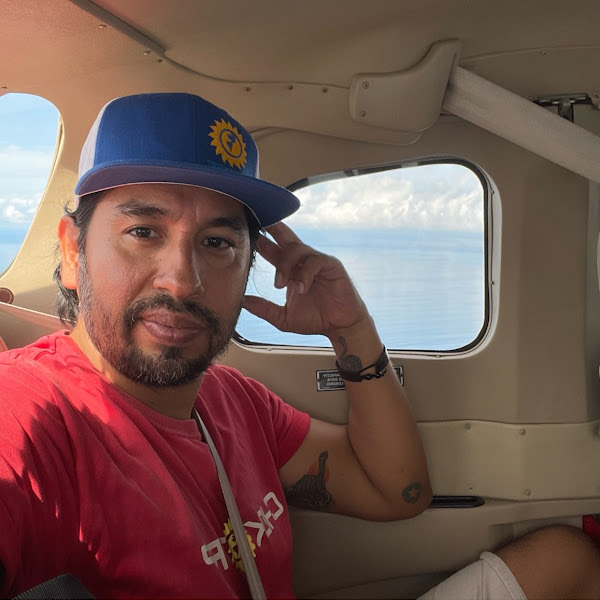
My name is Christian but you came call me Choko. Together with my wife we have created this blog to help all travelers going to Galapagos. I am from Ecuador, born in Guayaquil. Passionate about traveling and everything related to social media. In my free time I travel the americas. I have given conferences and workshops revolving around my work and tourism 2.0 // WRITE ME USING WHATSAPP: +593978990910 - BLOG EN ESPAÑOL ChokoTrip
Cancel reply
Follow me on my travels on social media:.
I Toured The Galápagos Islands On A Luxury Yacht
It’s the only way to go.

Located 600 miles away from the Ecuadorian coastline, the remote, volcanic Galápagos archipelago is often called a living laboratory of evolution. As Charles Darwin discovered nearly 200 years ago, natural oddities like cormorants that forgot how to fly and iguanas that learned how to swim have successfully adapted to their individual — and often inhospitable — habitats in order to thrive in a place where islands are constantly eroding and expanding. Here, what doesn’t kill you makes you more diverse. You might think such an environment would prove harsh for human visitors (and historically , it has). But we, too, have learned to adapt — thanks to a little help from luxury expedition yachts .
In the case of Ecoventura ’s vessels, the only ones in the Galápagos that are members of Relais & Châteaux, travelers can enjoy the lowest guest-per-guide ratio in the islands, hotel-worthy amenities , and a decadent, sustainable menu with local dishes. Because the Galápagos are one of the largest marine reserves in the world, touring the park’s riches by sea is undoubtedly the way to go. Sailing with Ecoventura also offers you the chance to go deeper — literally. Certified scuba divers can extend their trip on the company’s sophisticated live-aboard Galápagos Sky , which anchors at the bucket list dive sites of Darwin and Wolf, considered by many to be among the best in the world for their schooling hammerheads and other prolific pelagic life. This is what it was like to spend two weeks cruising around paradise.
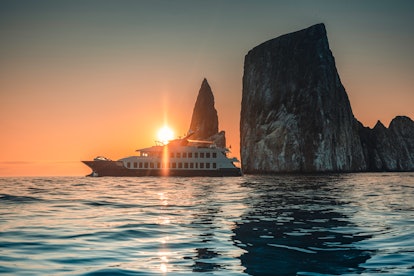
Exploring A Priceless Natural Treasure
With land-based excursions limited to the five islands that can be reached within one day, boat-based routes provide travelers the opportunity to uncover the most remote and exclusive parts of the Galápagos, where few humans have ever set foot and every moment of isolation feels like a true privilege. On Ecoventura, alternating itineraries last eight nights and seven days, with a choice of the younger, volcanically active islands in the west or the older, eroded islands in the east. Not only are these cruises the more luxurious option, it’s the best choice for the environment; routes are strictly dictated by Galápagos National Park officials to mitigate crowding and environmental stress, and Ecoventura is especially renowned for its numerous sustainable certifications.
On board the intimate 20-passenger Evolve, Ecoventura’s newest vessel, I set sail from San Cristóbal through the beaches and bays of the wondrous eastern islands and enjoyed a week of unforgettable experiences. At Floreana, I watched Galápagos green sea turtles mating in the surf and rode a panga (or zodiac) alongside a flock of flamingos. On Santa Cruz, I visited the Charles Darwin Research Station , where giant tortoise hatchlings are reared from birth before being repatriated to their native islands. At Bartolomé, I snorkeled with Galápagos penguins, the only species found north of the Equator. On North Seymour, I never quite knew where to look, as blue-footed boobies and frigates simultaneously flaunted their brightly-colored feet and scarlet gular pouches, respectively, trying to attract mates. In the Galápagos, wildlife is constantly putting on a show.
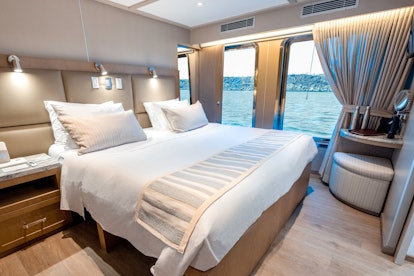
When I had to pull myself away, Evolve was the best possible place to rest and recharge. Equipped with an outdoor rain shower, beds worthy of a five-star resort, and a jacuzzi, the entire vessel felt spa-like, and it was easy to make myself at home (if my home was a glamorous yacht, that is). Each evening I had a ritual of settling in on the deck with a spritz to watch an epic sunset before heading down to the dining room for a five-course plated dinner featuring local specialties like pancetta in a guava and pineapple BBQ sauce and Galápagos prawns poached in citrus butter. By the time the first half of my trip had ended, I had seen and done more than on 99% of my vacations, while also managing to totally spoil myself.
Diving Into Adventure At Darwin, Wolf, & Beyond
Your typical dive boat is more about function than form — but scuba has its indulgent moments, too. On the Galápagos Sky, a 16-passenger yacht, divers swim in the shadow of giant manta rays, go fin-to-fin with impish sea lions, and explore the eroded, subsurface volcanoes of Darwin and Wolf where whale sharks migrate every year; all without leaving creature comforts like turn-down service, a full-service bar, Apple TVs, and made-to-order omelets.
Our cozy cabins were meticulously cleaned up in between dives (a lifesaver when you’re in and out of swimsuits and tracking water everywhere) and coffee delivered to us with the early morning wakeup call, exactly the way we requested it. But the real magic happened on the dive deck, where the entire crew pitched in to prep our gear, dress us, and wash everything after welcoming us back. (As a fellow passenger put it, “You know it’s good service when the captain himself helps you with your wetsuit.”) Every dive ended with a warm outdoor shower, a cup of tea or cinnamon hot chocolate, a homemade snack, a fresh towel wrapped around you, and best of all, lively conversation with everyone onboard about what we had spotted beneath the waves.
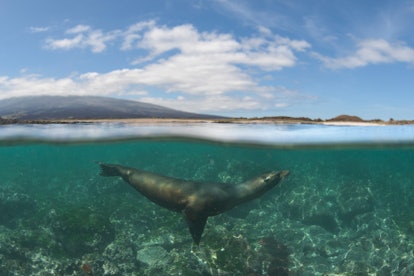
Naturally, a top scuba live-aboard should be filled with the greatest extravagance of all: life-changing, soul-shaking diving. Our brilliant instructors gifted us with 18 dives around the archipelago, focusing on the little-visited outlying islands of Darwin and Wolf where a confluence of nutrient-rich, sweeping currents deliver breathless encounters with pelagic megafauna. Clinging to underwater boulders, we marveled as a school of nearly 100 hammerheads — some heavily pregnant — gently undulated past us. Enormous, shimmering bait balls became mazes that we gently finned through. During safety stops, we played with sea lions and dolphins. At the western island of Fernandina, we dove with endemic marine iguanas — the world’s only seagoing lizards — as they fiercely clung to rocks foraging on algae.
Each dive was totally unique, and yet each time we emerged more in awe of — and in love with — this wild stretch of pristine ocean.
This article was originally published on April 10, 2023
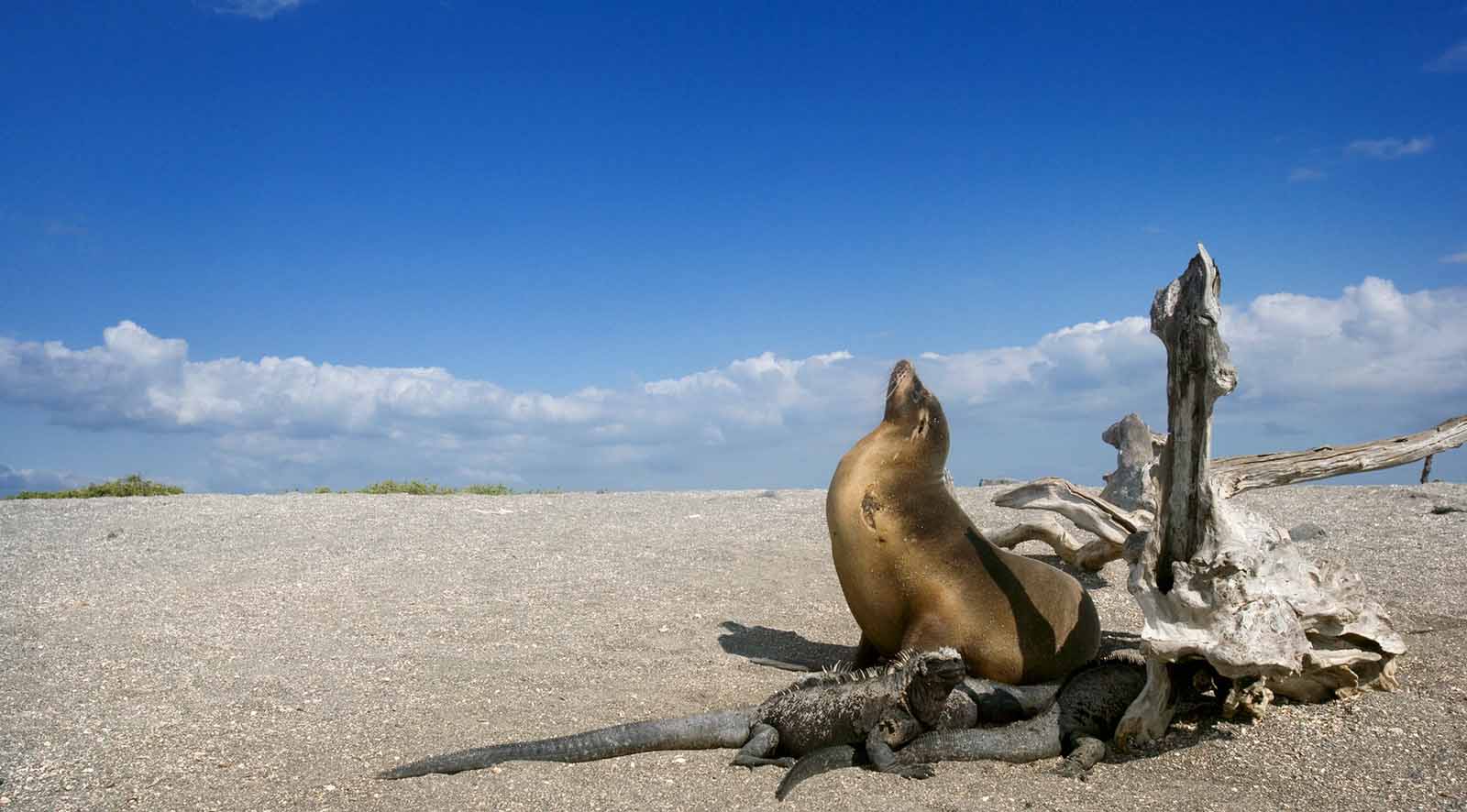
Explore Galapagos Islands: 10 Hidden Gems Off the Beaten Path
Read to explore Galapagos islands?
When you think of the Galapagos Islands , your mind might conjure images of iconic giant tortoises , blue-footed boobies, and pristine beaches.
While these are undoubtedly the archipelago's stars, the Galapagos offer far more than meets the eye. It's time to explore Galapagos Islands beyond the well-trodden trails and discover ten hidden gems that will unveil a side of these enchanted islands few get to witness.
- Santa Fe Island - The hidden jewel
- Genovesa Island - The birdwatcher's paradise
- South Plaza Island - The land of iguanas
- Floreana Island - Post office bay's secrets
- Bartolome Island - An otherworldly landscape
- Chinese Hat Islet - The geological anomaly
- Rabida Island - A red beach paradise
- Santiago Island - The enigmatic sullivan bay
- North Seymour Island - A wildlife wonderland
- Española Island - The albatross sanctuary
Frequently asked questions
What are the must-visit islands when exploring the galapagos.
How can I explore the Galapagos Islands responsibly?
Are there hidden gems in the Galapagos not commonly known to tourists?
What's the best way to plan an exploration of the galapagos islands, how can i ensure my galapagos exploration benefits local conservation efforts, 1. santa fe island - the hidden jewel.
Starting our journey of hidden gems is Santa Fe Island , a haven of biodiversity. With its turquoise bay, endemic land iguanas , and opuntia cactus forest, it's an untouched paradise for those who seek solitude and unique wildlife encounters.
The crystal-clear waters surrounding the island are ideal for snorkeling, offering glimpses of colorful fish and marine life.
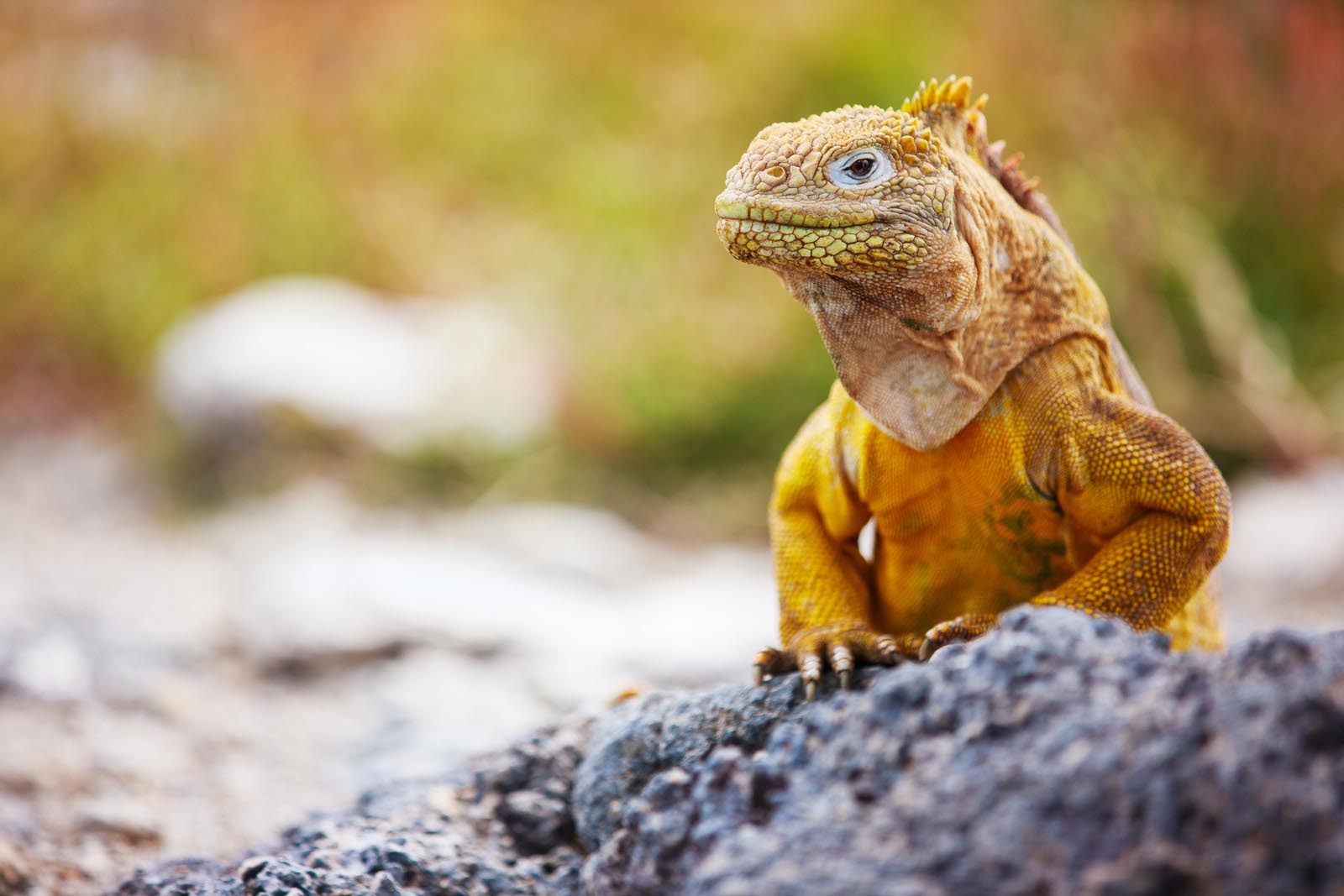
2. Genovesa Island - The birdwatcher's paradise
Genovesa Island , often dubbed "Bird Island," is a paradise for avian enthusiasts. You can observe red-footed boobies, swallow-tailed gulls, and frigatebirds in their natural habitat without the crowds found on more popular islands.
The island's Prince Philip's Steps trail takes you through a seabird nesting area where you can witness their intricate mating dances.
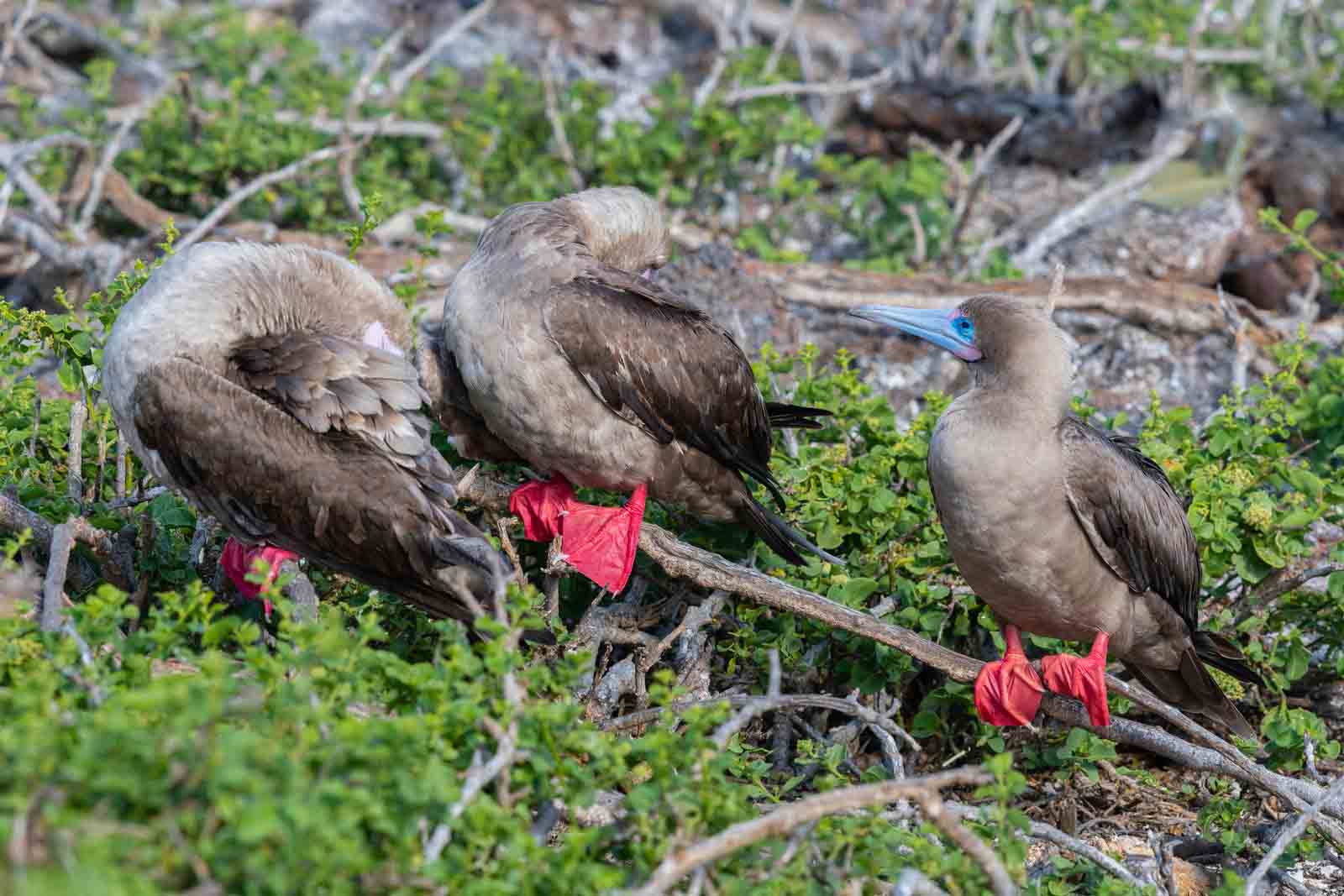
3. South Plaza Island - The land of iguanas
South Plaza Island is teeming with wildlife , including a large population of land iguanas. Its dramatic cliffs and vibrant flora make it a photographer's dream and an excellent spot for hiking.
Explore the unique vegetation, including the distinctive Sesuvium plants that turn bright red during the dry season, adding a surreal touch to the landscape.
4. Floreana Island - Post office bay's secrets
Floreana Island holds more than its renowned Post Office Bay. Delve deeper to find the enigmatic caves of Las Cuevas, where pirates once sought refuge. Explore lava tubes and discover the island's history.
Don't forget to visit the pristine beaches of Cormorant Point, where you can spot flamingos wading in brackish lagoons.
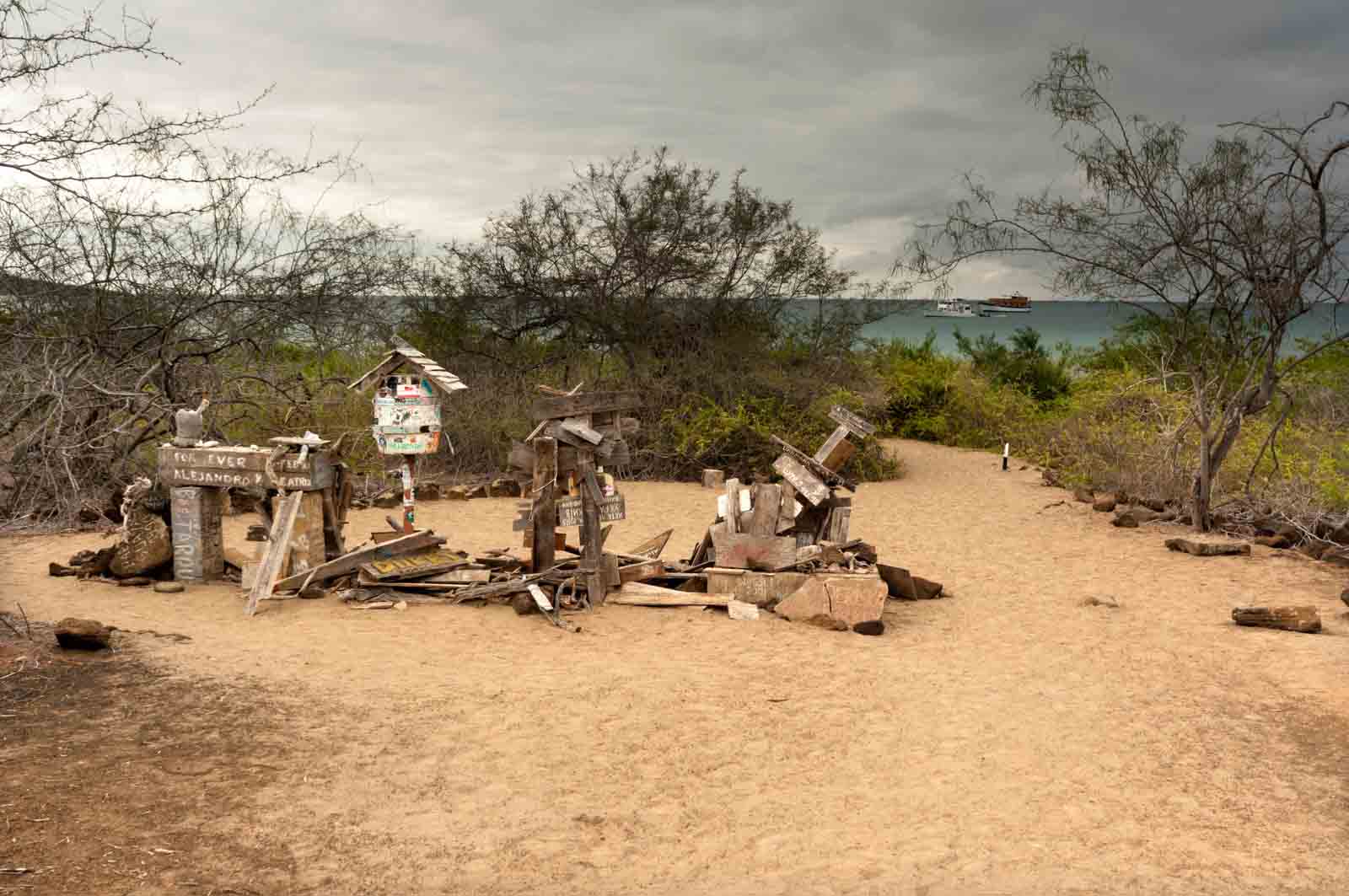
5. Bartolome Island - An otherworldly landscape
While Bartolome Island isn't exactly unknown, the striking lunar landscape of Pinnacle Rock and the mesmerizing views from its summit make it an essential stop for anyone who wants to explore Galapagos Islands' geological wonders.
Snorkel at the base of Pinnacle Rock, where you'll encounter playful sea lions and an array of colorful fish.
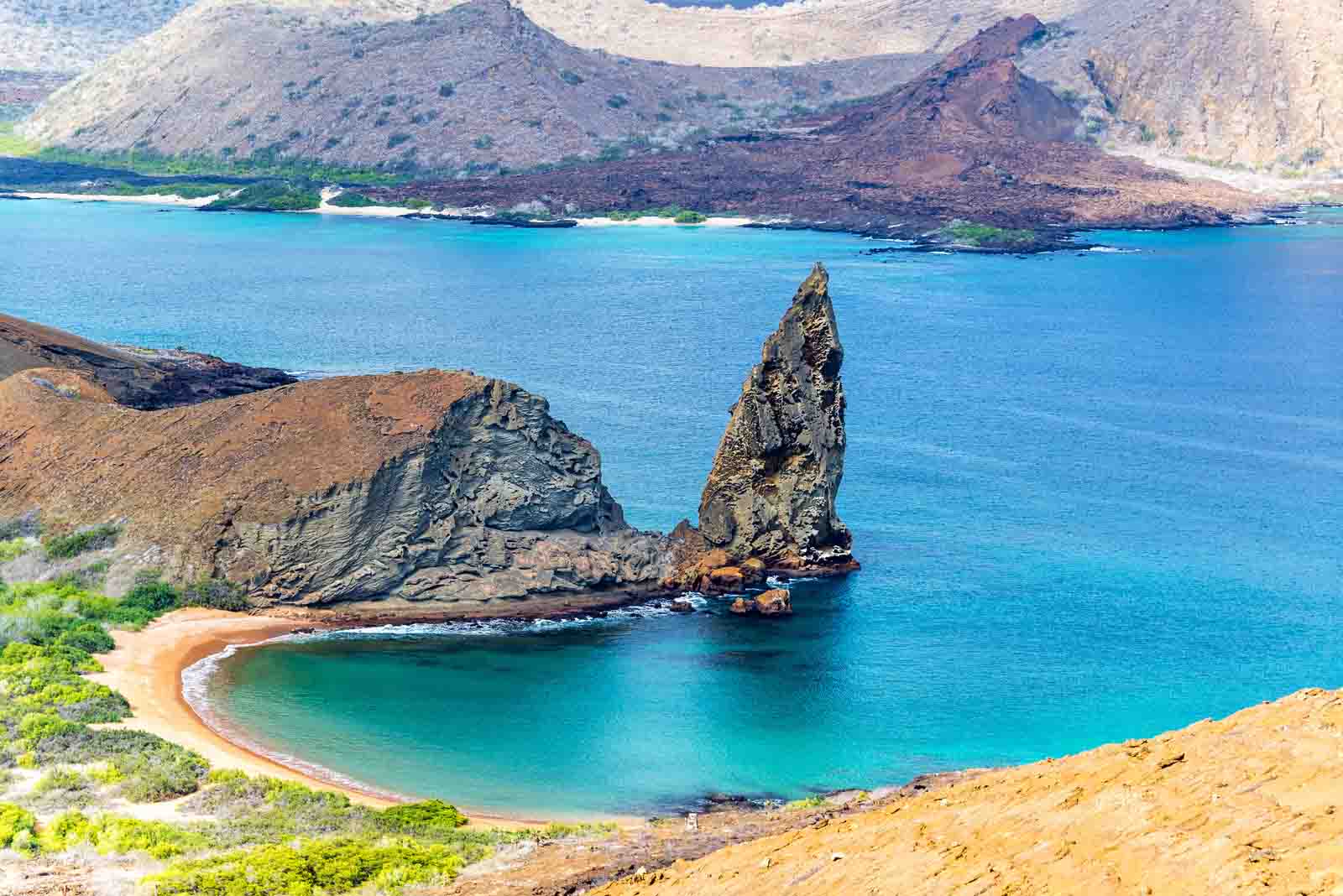
6. Chinese Hat Islet - The geological anomaly
This tiny islet is a geological treasure. Formed by a volcanic cone, its unique shape and pristine beaches are home to sea lions and marine life. It's a fantastic spot for snorkeling and underwater exploration.
Keep an eye out for Galapagos penguins, one of the few penguin species found in the tropics.

7. Rabida Island - A red beach paradise
Rabida Island's red-sand beaches and rugged landscapes set it apart. This hidden gem is less frequented, offering tranquility amidst sea lions , pelicans, and flamingos.
Hike its trails for breathtaking views and the chance to spot the elusive Galapagos hawk.

8. Santiago Island - The enigmatic sullivan bay
Santiago Island boasts the surreal Sullivan Bay, where you can walk on recent lava flows and witness the forces that shape the Galapagos. It's an extraordinary geological spectacle, with its barren landscapes and unique lava formations.
Snorkel along the coast to encounter green sea turtles and rays.
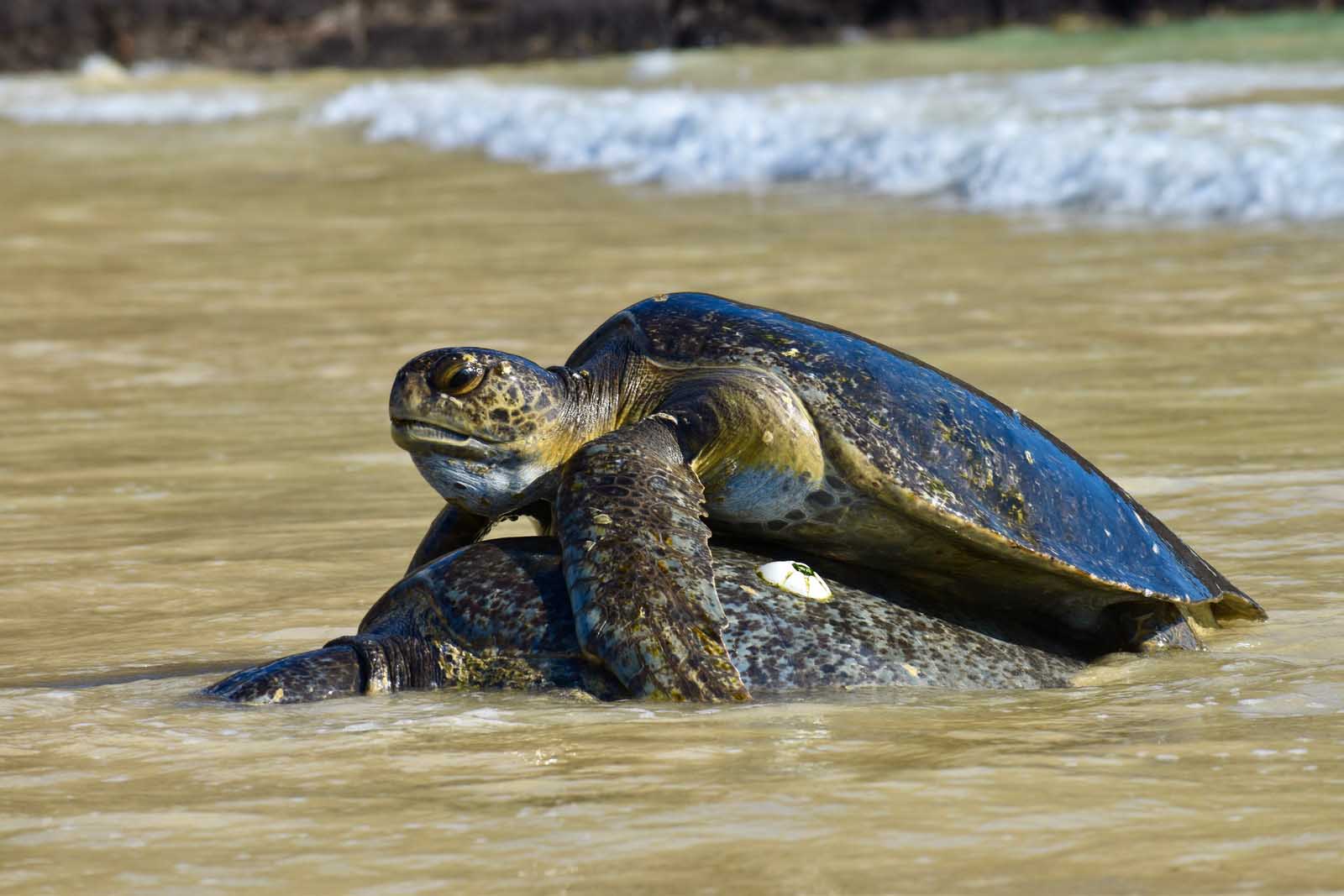
9. North Seymour Island - A wildlife wonderland
North Seymour Island may not be entirely off the beaten path, but its thriving wildlife, including nesting blue-footed boobies and frigatebirds, make it an essential stop for wildlife enthusiasts.
Stroll along the island's trails to witness these charismatic birds in their natural habitat.
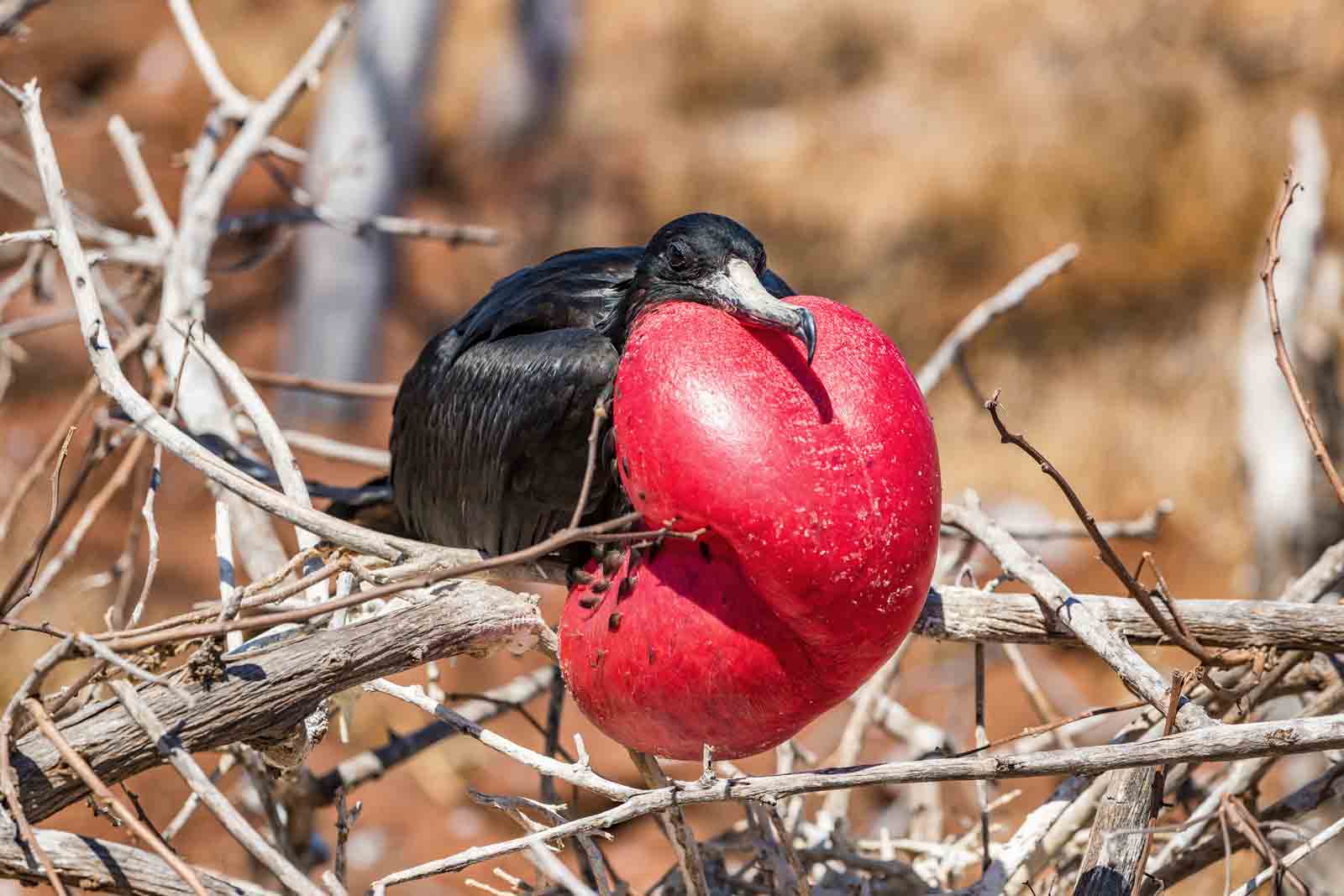
10. Española Island - The albatross sanctuary
Española Island is home to the world's largest colony of waved albatrosses. Visit Punta Suarez to witness these magnificent birds in their intricate courtship dances.
This hidden gem also offers opportunities to spot colorful marine iguanas , Galapagos hawks, and sea lions basking in the sun.
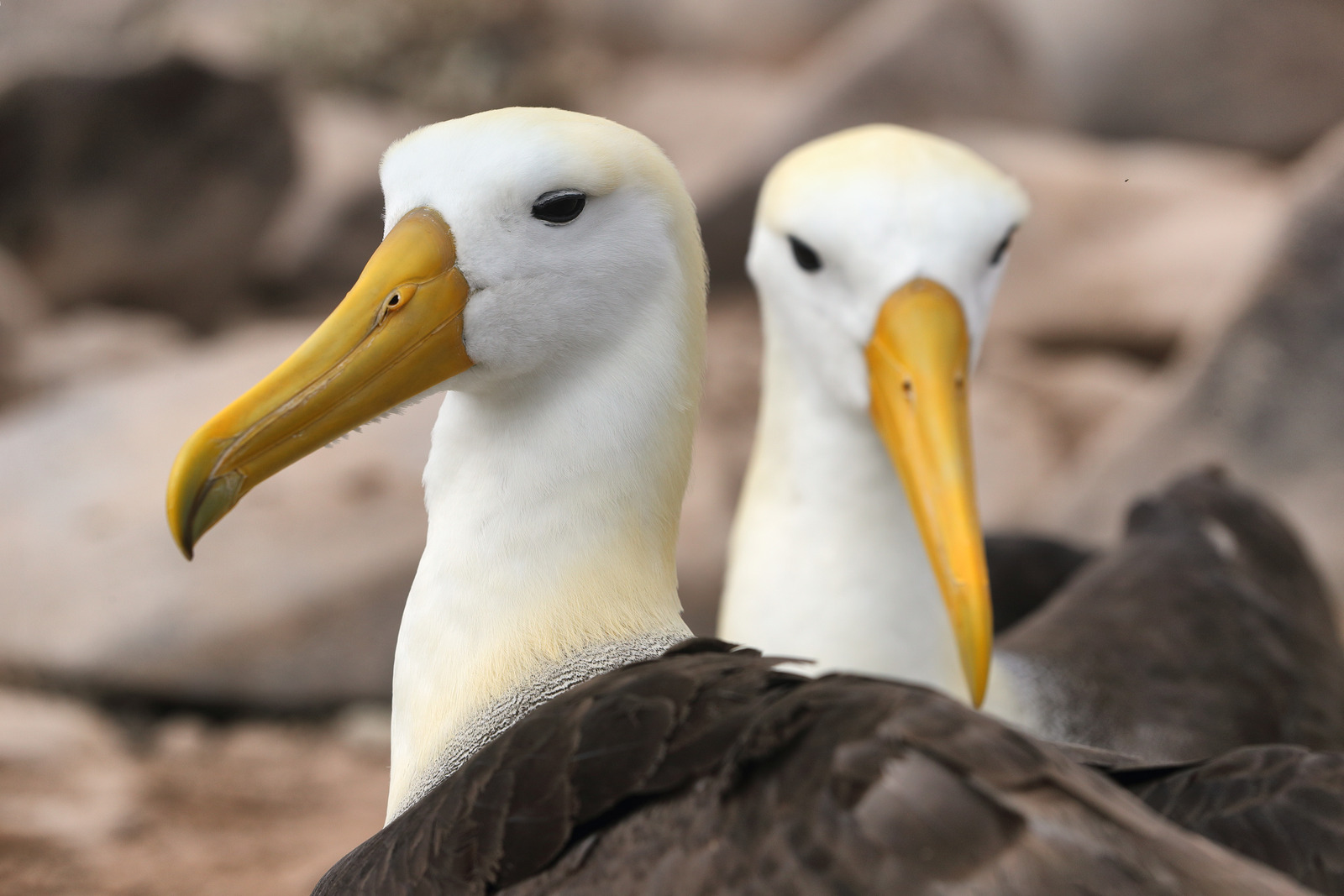
The Galapagos Islands are a diverse archipelago, and the must-visit islands can vary depending on your interests. Santa Cruz is often a central hub due to its amenities and the Charles Darwin Research Station. Isabela is a favorite for its volcanic landscapes and marine life. San Cristobal is great for birdwatching . Floreana has historical significance. Genovesa is a birdwatcher's paradise. Ultimately, the best islands for you to visit depend on your interests, and it's worth exploring a mix of them to experience the full range of Galapagos wonders.
How can I explore Galapagos Islands responsibly?
Responsible exploration of the Galapagos Islands is crucial for preserving their unique ecosystems. First, choose tour operators that are committed to sustainability and follow park regulations. While visiting, maintain a respectful distance from wildlife, stay on designated trails, and avoid disturbing the fragile environment. Minimize single-use plastics, dispose of waste properly, and use reef-safe sunscreen to protect marine life. By following these practices, you can help ensure the Galapagos Islands remain a pristine paradise for future generations.
Absolutely, the Galapagos Islands are full of hidden gems that often escape the typical tourist itineraries . For example, Santa Fe offers a serene escape with unique wildlife. South Plaza is an underrated gem with stunning landscapes and land iguanas. Chinese Hat Islet provides a geological wonderland for snorkelers. These lesser-visited spots let you experience the Galapagos in a more intimate way, away from the crowds.
Planning your Galapagos exploration involves several steps. Start with thorough research to understand the islands' attractions and your interests. Create an itinerary that aligns with your preferences, whether it's wildlife encounters, hiking , snorkeling, or all of the above. Booking tours or cruises in advance is advisable, especially during peak seasons. Consider your budget and choose accommodations that suit your needs. Finally, ensure you have all necessary permits and follow any travel advisories for the region.
Supporting local conservation efforts in the Galapagos is essential. Choose tour operators and accommodations that actively contribute to conservation and sustainability. Purchase souvenirs from local artisans and markets to support the island's economy directly. Participate in guided tours that educate you about the delicate ecosystems and ongoing conservation initiatives. Lastly, respect all park regulations and guidelines to minimize your environmental impact and ensure that your exploration leaves a positive mark on the Galapagos Islands.

The Galapagos Islands are like a treasure chest waiting to be explored. Beyond the well-known attractions, these hidden gems offer a more intimate, unique, and personal connection to the archipelago's unparalleled natural beauty.
As you explore Galapagos Islands off the beaten path, you'll not only witness rare wildlife and breathtaking landscapes but also forge memories of a lifetime, all while contributing to the conservation of this pristine paradise.
So, venture beyond the obvious, and let the hidden gems of the Galapagos Islands reveal their secrets to you. These lesser-visited islands promise an immersive and authentic Galapagos experience that will forever hold a special place in your travel memories.
Check our galapagos cruises:

The Ultimate Isla Isabela Galápagos Guide
11/26/2019 by Kristin Addis Leave a Comment

Isla Isabela in the Galápagos is the biggest island in the group, as well as the only one that is shaped exactly like a seahorse. IIt’s like it was written in the stars that it would have amazing sea life, because it just so happens that there are seahorses on Isabela, as well as sea lions, turtles, manta rays, and sharks galore.
Of all of the islands in the Galápagos, Isabela just might have the best snorkeling. In few other places have I seen so many animals in the water at once. The Galápagos is simply amazing, and Isabela is the perfect combination of the best that the islands have to offer.
If you’re visiting Isabela independently, you’ll have different options than the cruise ships do as they move around the island. Since you’re probably here to get info on traveling there independently, allow me to share some of the best things to do on Isla Isabela:
Table of Contents
Los Túneles
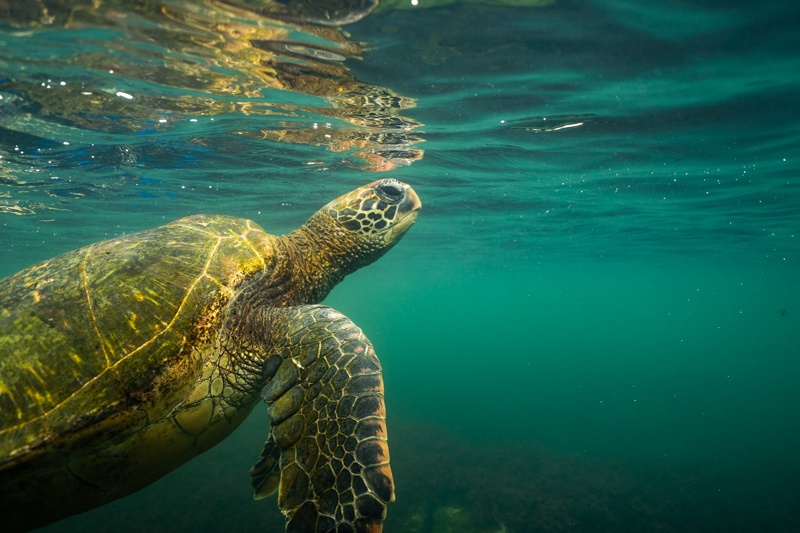
I’m just going to start right at the top. If you visit Isabela, you MUST take a day trip to Los Túneles. Book this as soon as you know you’ll be heading there, as permits are very limited and thus, so are spaces on the tours.
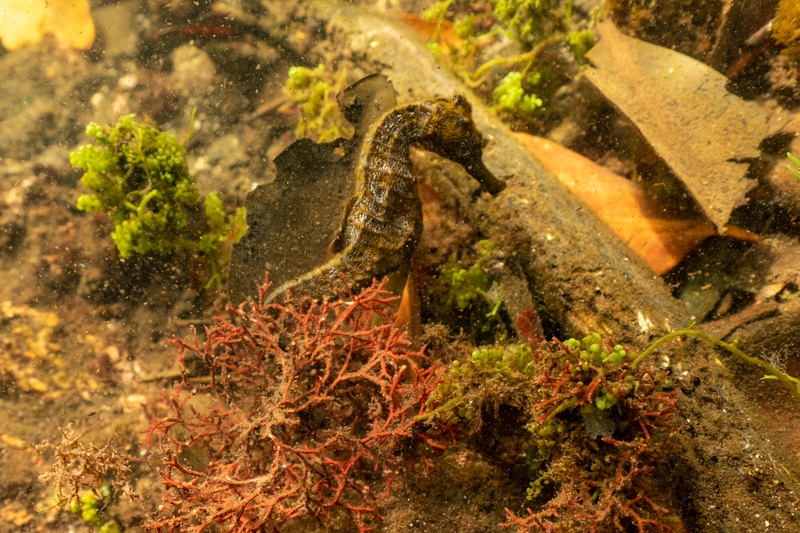
It’s worth moving things around in your itinerary to accommodate this trip. We saw manta rays gliding through the ocean on our way, swam with tons of sea turtles, multiple white-tipped reef sharks, and of course, saw a couple of seahorses.
Concha Perla
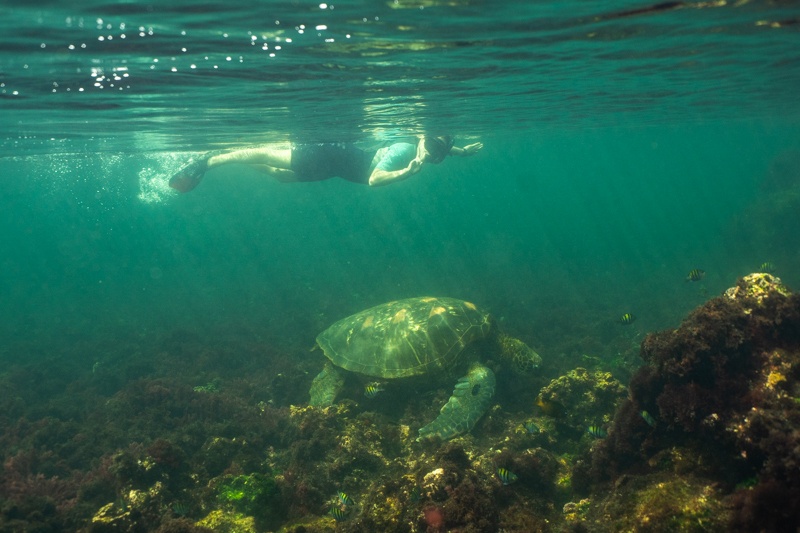
Let’s be honest, this is not the best snorkeling you will experience on the island, but it’s easily accessible in town and the boardwalk to get there is nice. You’re almost guaranteed to see marine iguanas as well as sea lions, and I did spot a couple of sea turtles near the mangroves.
Surfing Lessons
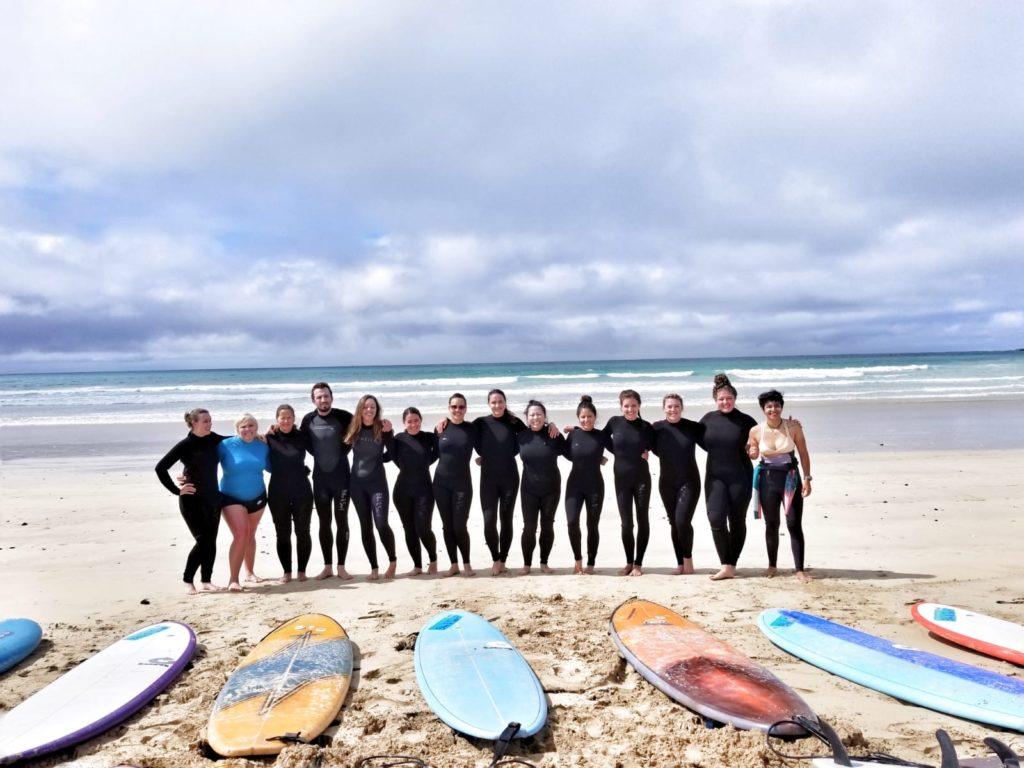
I took my BMTM Adventures group surfing on our last day on Isabela and it was tons of fun. Some of the women in the group were able to stand up multiple times!
I stood up for a few milliseconds three times and I also got nailed in the eye by my board and got a mini bruise, so I’m going to go ahead and call it even.
Bike the Wall of Tears
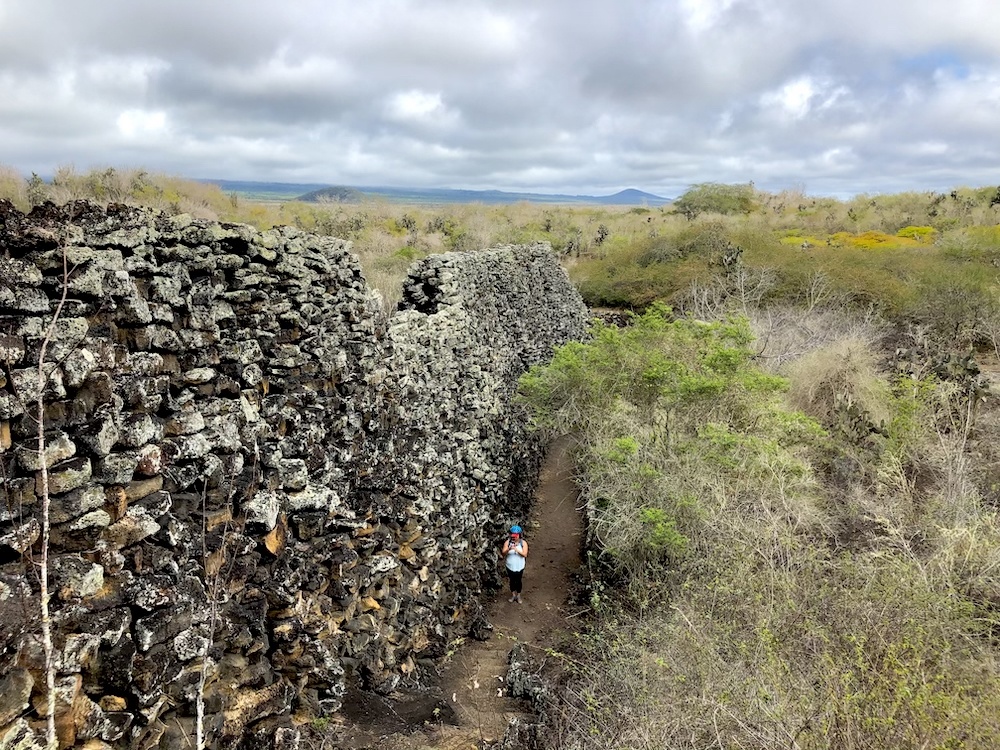
Biking the Wall of Tears gives you a peek into the past of Isabela, a former penal colony.
The wall itself is a somber ending point, as many people lost their lives building and re-building a wall for no apparent reason other than punishment. However the bike ride there will take you past several lovely beaches including Playa del Amor, and you’ll probably see several tortoises on the way as well. Once you reach the wall, it’s worth doing the hike up to the viewpoint to see a beautiful view over Puerto Villamil and beyond.
Though I reached it in the late morning, I could see this being an amazing spot for sunrise if you’re willing to bike in the dark. Obviously, take a headlamp.
The biking trail can get pretty hot, and it’s not entirely flat so I recommend starting in the morning.
Sierra Negra Volcano Hike
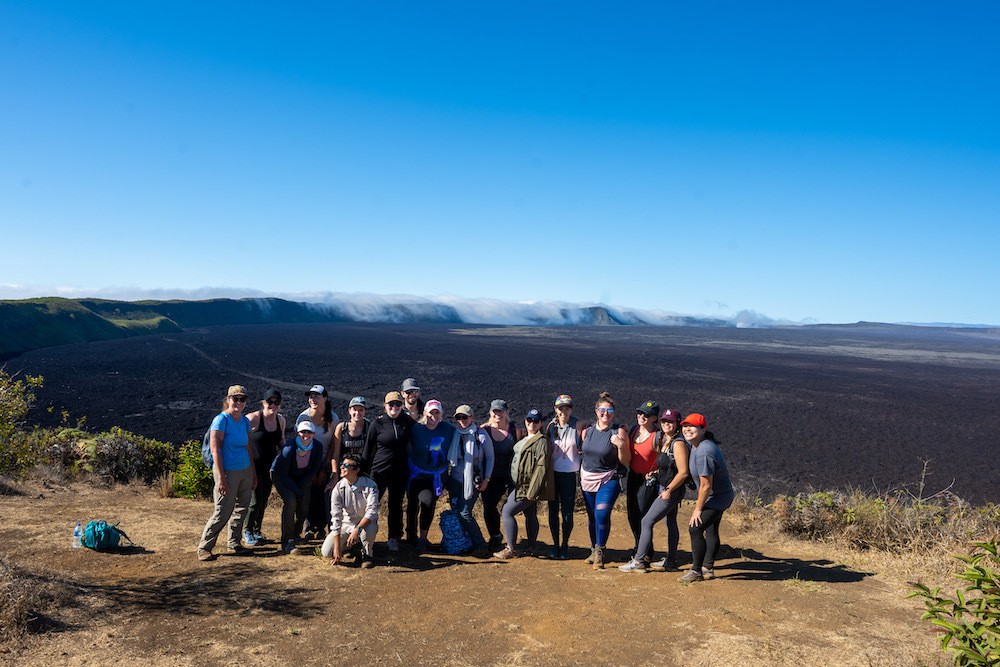
Sierra Negra is one of many active volcanoes on the island and a fantastic trip to take in the morning. The hike is pretty easy and gradual, and not too long.
That said, consider the weather, as you will have no shade and you are hiking along volcanic lava rock, which gets blistering hot in the sun. I’m not sure this is always possible, but my group started an hour before all of the other tour groups usually begin, at 7 AM. This allowed us to have the volcano all to ourselves.
Since the Galápagos is tightly regulated, you will have to do this as part of a tour. You can find them all over town for around $30. We used Pahoehoe for my BMTM Adventures trip and they were amazing.
Tintoreras Snorkeling
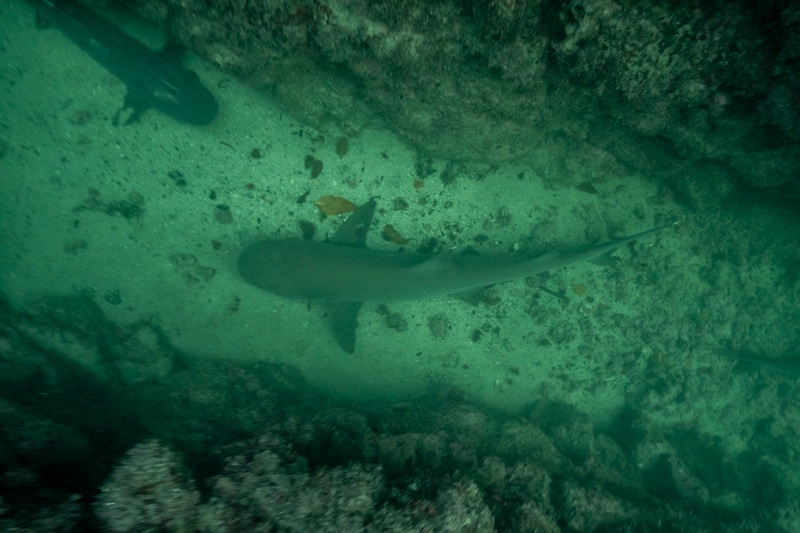
Although nothing can rival Los Túneles, I highly recommend spending as much time as you can on Isabela under the sea.
Las Tintoreras Islet has plenty of marine iguanas and the snorkeling will provide opportunities to swim with sea lions, sea turtles, rays, and my favorite, a little alleyway created by lava rock that was full of white-tipped reef sharks! I’ve never seen that many all at once!
This also must be done as a tour but it’s much closer to town than Los Túneles and can be done as an afternoon excursion, potentially after Sierra Negra. If you’re lucky, you might see penguins on the way as well – we did!
Villamil Lagoon and Tortoise Breeding Center
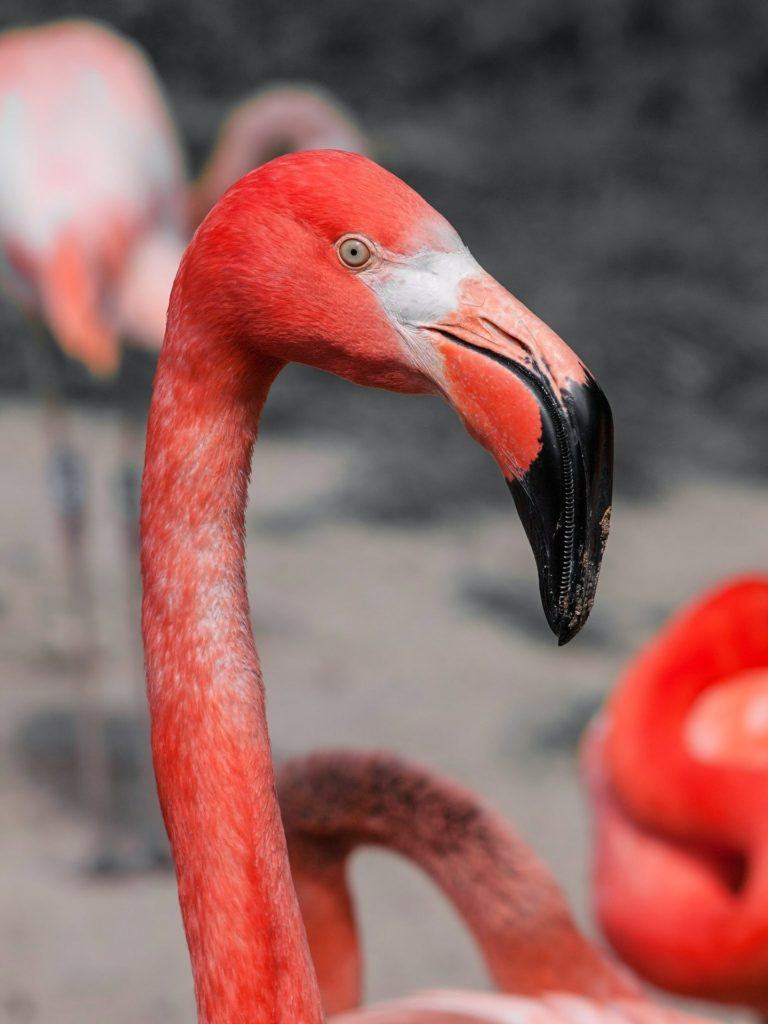
To see the famous Galápagos flamingos, along with more iguanas, head to the boardwalk that will take you to the Villamil Lagoon. It’s easily accessible from town and just on the other side of where you would begin the Wall of Tears bike ride.
At the end of the boardwalk, you will come to a tortoise breeding center. All of this is free and you can self guide. It was fun to see the tiny little baby tortoises!
Tortuga Island Snorkeling or Diving
Tortuga Island is a popular snorkeling and diving spot, though, to be honest, a few women from my group checked it out and reported such rough seas that they all got seasick. They didn’t see anything snorkeling, but the divers did see some sharks. Obviously, conditions can be different on a day by day basis so don’t write this one off if you’re dying to go scuba diving on Isabela.
Elizabeth Bay
Another day trip, Elizabeth Bay can be a good bet if you’re hoping to see Galápagos penguins. You also have the potential to see them on your way to Las Tintoreras.
Keep in mind that your best time of year to see the penguins is when the water is colder, which is during the dry season. You can check out this post for an idea of weather and animal sightings by month.

My group stayed at La Casa de Marita Boutique Hotel and it was wonderful. It is one of the higher end hotels on the island but with rooms with a nice view of the ocean and a delicious breakfast, plus food that is sourced from their organic farm, I can’t recommend it enough.
Honestly, most of the restaurants on the island are pretty similar and none really stood out as great or terrible. That said, Coco Surf had pretty good food, though it was pricey and a long wait.
Getting There:
Ferries depart daily from Santa Cruz Island to Isabela, typically at 7 AM and 2 to 3 PM. Ferries depart back to Santa Cruz around the same time from Isabela. The passage takes about two hours on a speed boat and it can be quite choppy, so take Dramamine if you’re the type to get seasick!
My group and I absolutely adored our time on the island, which had some of the best snorkeling of my entire Galápagos experience. I spent three weeks on the island, exploring by cruise , budget backpacking, and doing it more luxury style with my group. If you’re looking for a complete guide to the Galápagos , I’ve got you totally covered! To read more, click the images below.
About Kristin Addis
Kristin Addis is the founder and CEO of Be My Travel Muse, a resource for female travelers all around the world since 2012. She's traveled solo to over 65 countries and has brought over 150 women on her all-female adventure tours from Botswana to the Alaskan tundra.
Leave a Reply Cancel reply
Your email address will not be published. Required fields are marked *
Save my name, email, and website in this browser for the next time I comment.
subscribe to our newsletter
This site uses Akismet to reduce spam. Learn how your comment data is processed .

- Inquire Now
Galapagos Travel Center Travel Blog
The most fascinating articles and the most up-to-date information for your visit to the Enchanted Islands

Pros of Booking Your Galapagos Trip with a Travel Agency
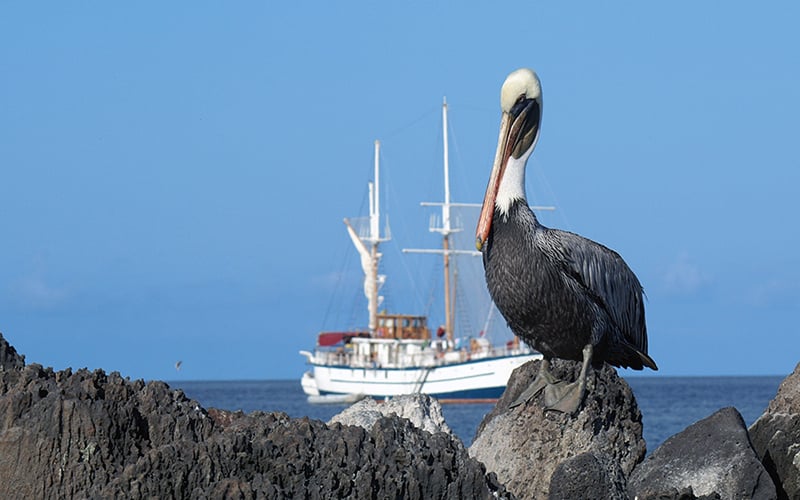
Galapagos is Safe for Travel
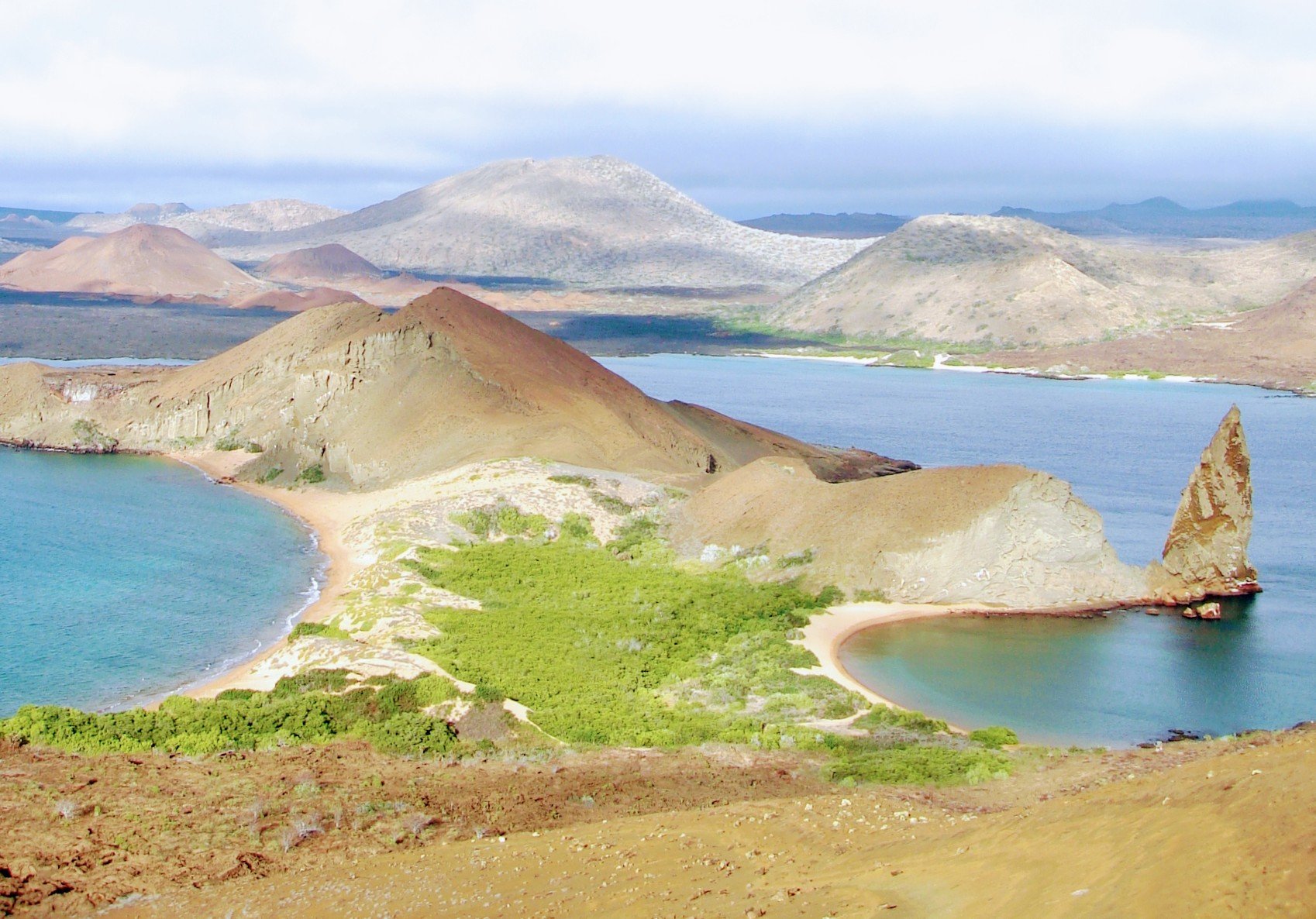
Blue Bonds: Galapagos Conservation & Historic Exchange of Debt For Nature
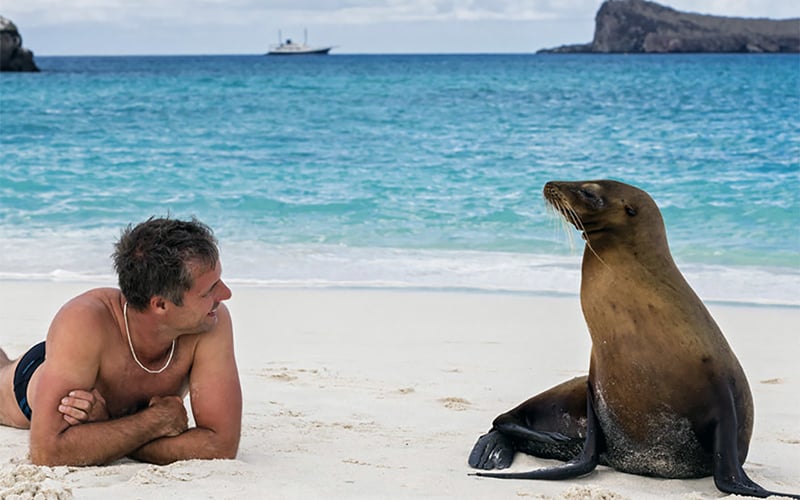
Why Galapagos is Different from Other Beach Destinations
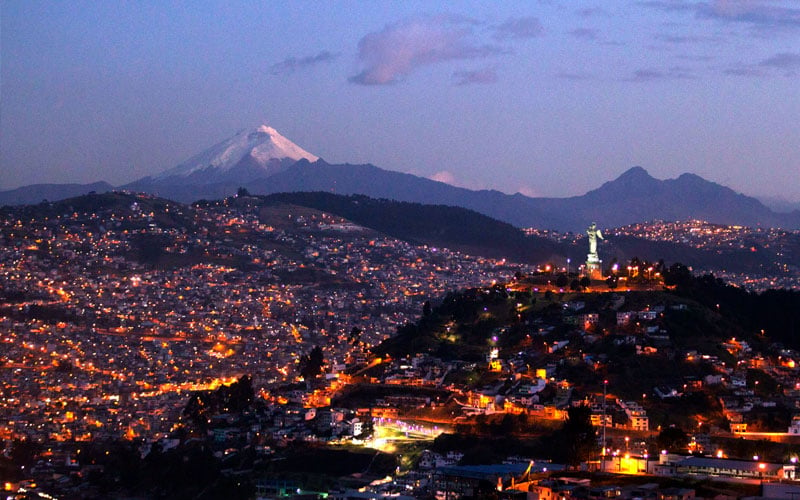
Tour Extensions that Work Perfectly with your Galapagos Trip
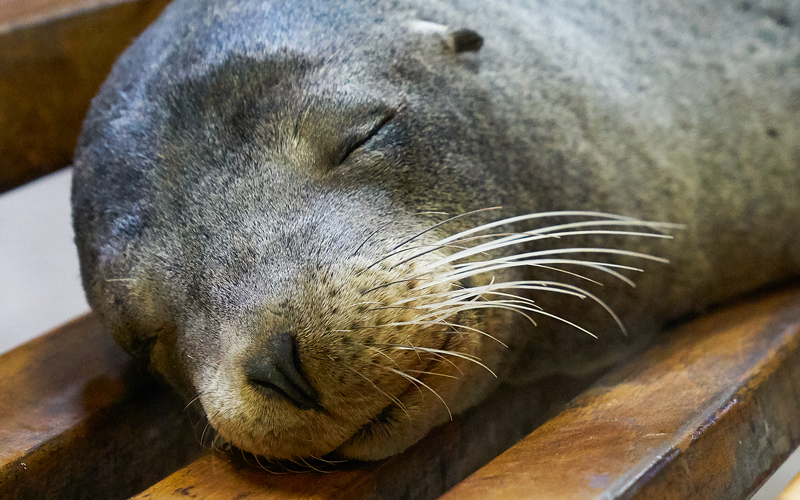
The Best Time to Buy Your Galapagos Tour
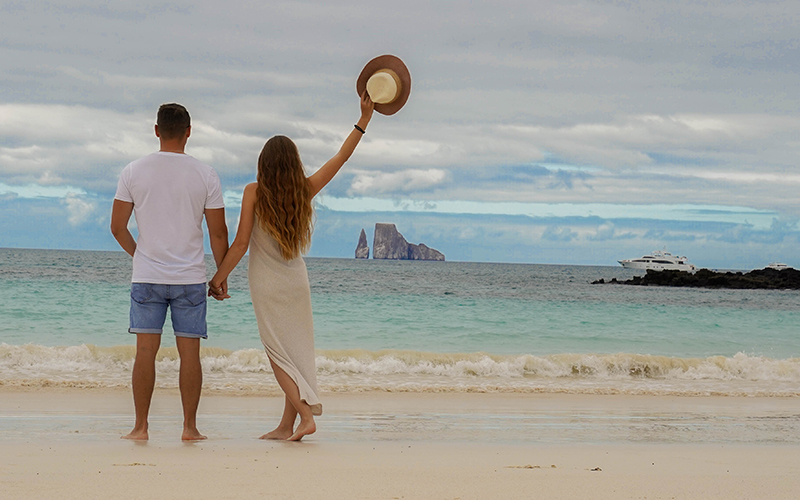
10 Tips on How To Travel to The Galapagos Islands
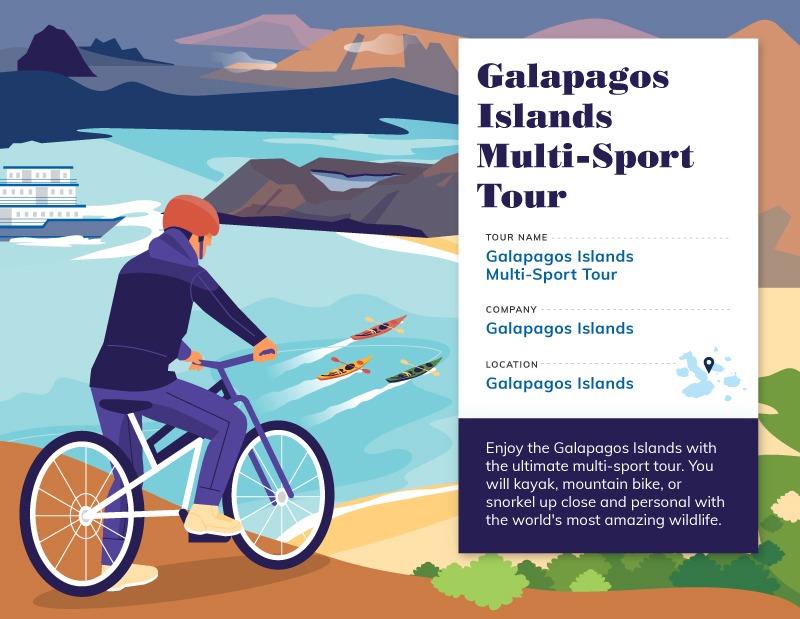
Galapagos Travel Center has been featured!
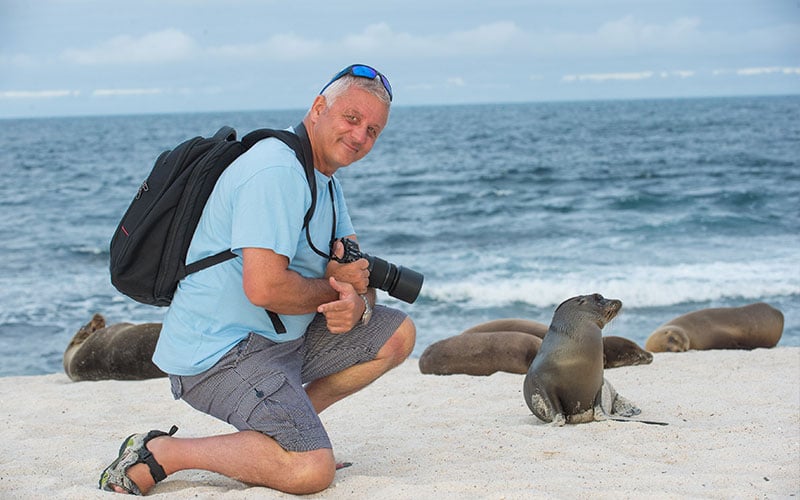
Why travel to Galapagos?
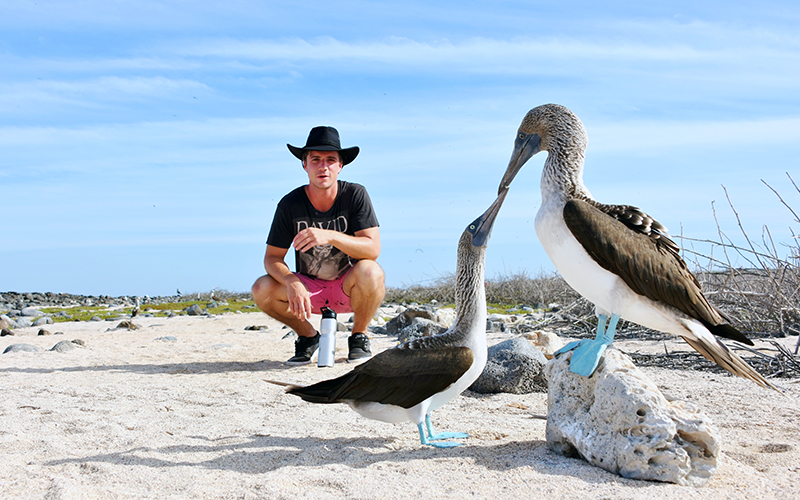
The Best Time to Visit the Galapagos
Posts navigation, our categories, travelers´choice.

Certificate of Excellence

Tripadvissor Reviews

Galapagos Cruises
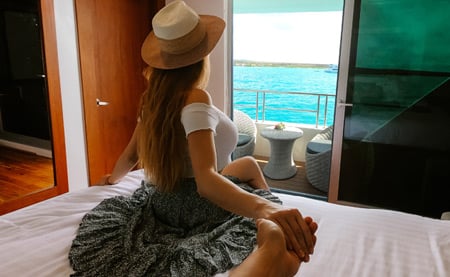
- First Class

IMAGES
VIDEO
COMMENTS
Galápagos Travel Guide. With a five-million-year history, The Galápagos Islands are an incredible destination. These UNESCO World Heritage Site islands are a haven for some of the world's most endangered species and are a dream to explore if you're a nature and outdoors' lover. You can spend weeks hiking the trails on the 18 main ...
There are two airports on the Galapagos to fly into: Baltra: Baltra is the airport closest to Puerto Ayora on Santa Cruz Island. It's super easy to get from Baltra to Puerto Ayora, and everyone will be headed in the same direction. There's a shuttle service to the ferry from Baltra to Santa Cruz Island which costs $5.
Situated on a tropical oasis, the restored 19th-century property offers authentic Ecuadorian cuisine and a peaceful setting to catch up on sleep before embarking on the remainder of the journey to the Galápagos. There are two major airports on the Galápagos Islands: Seymour Airport (serving the island of Baltra), and San Cristobal (found on ...
The Galapagos Islands are situated roughly 900 km (560 mi) off the Pacific coast of Ecuador. The volcanic archipelago straddles the equator and spreads out over an area of more than 45,000 km² (17,000 mi²). Most visitors arrive via a 2-hour direct flight from Quito or Guayaquil, or as part of a cruise from other parts of the Pacific.
A great tip for those wanting to backpack Galapagos on a budget - go for a last minute trip. Once you get to the island you can find specials and deals being offered everywhere for last minute trips. Day trips range from $40-$95 depending on where you want to go.
Check for flights from USA to Ecuador. From Europe, most flights go from Amsterdam or Madrid to Quito for around US$700 return. Flights from Quito/Guayaquil to Galapagos Islands cost around US$300 to $400 return. All flights are with either LATAM or Avianca, which are both reliable South American airlines.
Remember that the Galapagos Islands are located directly on the equator, making the sun rays some of the most powerful on Earth. Do yourself a favor and check your bag, double up on sunscreen, and buy two hats. As for bug spray, all I have to say is saltwater-loving horse flies and vicious mosquitoes… 'nuff said.
Discover the islands that inspired Charles Darwin. The Galápagos Islands, located roughly 600 miles off the coast of Ecuador, remained a closely guarded natural secret for millions of years. Over ...
2023-01-04. A quiet, calm, pristine and pure set of wonderful ecosystems, that is the essence of the Galapagos islands. It is no surprise that Darwin was able to study and develop his own theory of evolution while visiting the beautiful Galapagos islands. Truth is, the archipelago has more than 60 islets and it is accompanied by magnificent ...
7-Day Galapagos Island Hopping Budget. 6-day Multi Sport Tour in Galapagos including Isabela. Full Day Seymour North Island & Las Bachas from Puerto Ayora. Day tour to Pinzón Island and La Fé/Palmitas Bay with Snorkeling & Fishing from Puerto Ayora. Full Day Bartolome Island & Sullivan Bay from Puerto Ayora.
A variety of different people are traveling to the Galapagos! New ways to visit the islands include all-budget options for groups, families or couples. Corporate travel includes incentives programs for your company. Or, enjoy certified lesbian/gay-friendly tourist services. Charter and Groups. Galapagos for Families. Lesbian and Gay.
Galapagos Explorer: The perfect 8-day trip with overnight stays on all three major islands: San Cristobal, Santa Cruz, and Isabela. It provides relaxing travel at your own pace with flexibility to choose between Sierra Negra Volcano trekking or Los Tuneles snorkelling. The tour can be started on any day!
The Galapagos Islands are surreal. And as I write this, the last entry of a weeks' worth, I find it difficult to comprehend just how unbelievable the past few days have been. One last Galapagos sunrise. Oliver travelled on Intrepid's Galapagos Panorama trip. Explore all of Intrepid Travel's Galapagos itineraries here.
Day 3: Take a ferry from San Cristobal to Isla Isabella, via Santa Cruz. Day 4: Snorkelling day trip from Isla Isabella to Los Tuneles. Day 5: Take a morning ferry from Isla Isabella to Santa Cruz. In the afternoon, visit the Charles Darwin Research Centre. Enjoy an iced coffee at 1835 Coffee Lab after the visit.
Galapagos IslandsMichael EisemanMarch 10, 2024Galapagos Fees, Galapagos Islands, Ecuador Travel, Galapagos Travel, National Park Fees. Meet the Española Christmas Marine Iguana. Our team at Touring Galapagos would like to introduce one of the most unique endemic phenomena in the Galapagos, the Christmas Marine Iguana from Española Island.
1. Santa Cruz Island. Starting at the top, Santa Cruz Island houses the largest Galapagos population and is the most popular island with tourists for an overnight stay. Puerto Ayora is an attractive little port town with plenty to keep visitors busy on a free day or afternoon.
Explore the unique landscapes From lava fields to pristine beaches, the Galapagos Islands showcase an array of awe-inspiring landscapes. On Bartolome Island, hike to the summit to witness the iconic Pinnacle Rock against a backdrop of turquoise waters.In Santa Fe, encounter the island's endemic land iguanas and stroll along the picturesque white sand beaches.
First things first: you'll need to book a flight. There are only a few airlines that fly to the Galápagos, and prices typically hover between $350 - $450 (round trip from mainland Ecuador) depending on how far in advance you book. Tip # 1: The cheapest city to fly from is usually Guayaquil.
The Galapagos Islands; As an Ecuadorian blogger, I wrote this guide to traveling cheap (Low cost) with first-hand and updated information to explore it on your own, know what tours you can take on each Island and create a budget according to what you want to know. Every year, I travel to the Galapagos Islands (Ecuador) and everything you are going to read in the ChokoTrip and ChokoTours blog ...
On the Galápagos Sky, a 16-passenger yacht, divers swim in the shadow of giant manta rays, go fin-to-fin with impish sea lions, and explore the eroded, subsurface volcanoes of Darwin and Wolf where whale sharks migrate every year; all without leaving creature comforts like turn-down service, a full-service bar, Apple TVs, and made-to-order ...
7. Rabida Island - A red beach paradise. Rabida Island's red-sand beaches and rugged landscapes set it apart. This hidden gem is less frequented, offering tranquility amidst sea lions, pelicans, and flamingos. Hike its trails for breathtaking views and the chance to spot the elusive Galapagos hawk.
Ferries depart daily from Santa Cruz Island to Isabela, typically at 7 AM and 2 to 3 PM. Ferries depart back to Santa Cruz around the same time from Isabela. The passage takes about two hours on a speed boat and it can be quite choppy, so take Dramamine if you're the type to get seasick!
10 Tips on How To Travel to The Galapagos Islands. While planning this once-in-a-lifetime trip it's important to keep these Galapagos travel tips in mind! 1. […] 1. read more. by Kelsey Golias. January 23, 2020.